
Humboldt Broncos
The Humboldt Broncos are a Canadian junior "A" ice hockey team from Humboldt, Saskatchewan. Established in 1970, the Broncos play in the Saskatchewan Junior Hockey League.
A bus carrying the Humboldt Broncos junior ice hockey team collides with a semi-truck in Saskatchewan, Canada, killing 16 people and injuring 13 others.

The Humboldt Broncos are a Canadian junior "A" ice hockey team from Humboldt, Saskatchewan. Established in 1970, the Broncos play in the Saskatchewan Junior Hockey League.
On April 6, 2018, sixteen people were killed and thirteen were injured when a northbound coach bus struck a westbound semi-trailer truck near Armley, Saskatchewan, Canada. The driver of the semi-truck had failed to yield at a flashing stop sign at the intersection of Highways 35 and 335. The semi-trailer was travelling at a speed of approximately 100 km/h (60 mph). Most of the deceased and injured were players from the Humboldt Broncos, a junior ice hockey team from Humboldt, Saskatchewan, which plays in the Saskatchewan Junior Hockey League (SJHL).

Saskatchewan is a province in western Canada, bordered on the west by Alberta, on the north by the Northwest Territories, on the east by Manitoba, to the northeast by Nunavut, and on the south by the U.S. states of Montana and North Dakota. Saskatchewan and Alberta are the only landlocked provinces of Canada. In 2022, Saskatchewan's population was estimated at 1,194,803. Nearly 10% of Saskatchewan’s total area of 651,900 square kilometres (251,700 sq mi) is fresh water, mostly rivers, reservoirs and lakes.

Canada is a country in North America. Its ten provinces and three territories extend from the Atlantic Ocean to the Pacific Ocean and northward into the Arctic Ocean, covering over 9.98 million square kilometres, making it the world's second-largest country by total area. Its southern and western border with the United States, stretching 8,891 kilometres (5,525 mi), is the world's longest binational land border. Canada's capital is Ottawa, and its three largest metropolitan areas are Toronto, Montreal, and Vancouver.
U.S. military launches 59 Tomahawk cruise missiles at an air base in Syria. Russia describes the strikes as an "aggression", adding they significantly damage US-Russia ties.

On the morning of 7 April 2017, the United States launched 59 Tomahawk cruise missiles from the Mediterranean Sea into Syria, aimed at Shayrat Airbase controlled by the Syrian government. The strike was executed under responsibility of U.S. President Donald Trump, as a direct response to the Khan Shaykhun chemical attack that occurred on 4 April.

Syria, officially the Syrian Arab Republic, is a Western Asian country located in the Eastern Mediterranean and the Levant. It is a unitary republic that consists of 14 governorates (subdivisions), and is bordered by the Mediterranean Sea to the west, Turkey to the north, Iraq to the east and southeast, Jordan to the south, and Israel and Lebanon to the southwest. Cyprus lies to the west across the Mediterranean Sea. A country of fertile plains, high mountains, and deserts, Syria is home to diverse ethnic and religious groups, including the majority Syrian Arabs, Kurds, Turkmens, Assyrians, Armenians, Circassians, Albanians, and Greeks. Religious groups include Muslims, Christians, Alawites, Druze, and Yazidis. The capital and largest city of Syria is Damascus. Arabs are the largest ethnic group, and Muslims are the largest religious group.
The National Movement for the Liberation of Azawad unilaterally declared the region of Azawad independent from Mali.

The National Movement for the Liberation of Azawad or the Azawad National Liberation Movement, formerly the National Movement of Azawad, is a political and military organisation based in Azawad in northern Mali.

On 6 April 2012, the National Movement for the Liberation of Azawad unilaterally declared Azawad independent from the Republic of Mali in the wake of a rebellion which was preceded by a string of other Tuareg rebellions. It is called the Independent State of Azawad.

Azawad, or Azawagh was a short-lived unrecognised state from 2012 to 2013. Azawagh (Azawaɣ) is the generic Tuareg Berber name of all Tuareg Berber areas, especially the northern half of Mali and northern and western Niger. Its independence was declared unilaterally by the National Movement for the Liberation of Azawad (MNLA) in 2012, after a Tuareg rebellion drove the Malian Army from the region.
Azawad declares itself independent from the Republic of Mali.

Azawad, or Azawagh was a short-lived unrecognised state from 2012 to 2013. Azawagh (Azawaɣ) is the generic Tuareg Berber name of all Tuareg Berber areas, especially the northern half of Mali and northern and western Niger. Its independence was declared unilaterally by the National Movement for the Liberation of Azawad (MNLA) in 2012, after a Tuareg rebellion drove the Malian Army from the region.

On 6 April 2012, the National Movement for the Liberation of Azawad unilaterally declared Azawad independent from the Republic of Mali in the wake of a rebellion which was preceded by a string of other Tuareg rebellions. It is called the Independent State of Azawad.
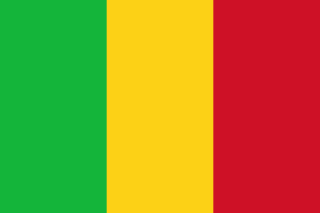
Mali, officially the Republic of Mali, is a landlocked country in West Africa. Mali is the eighth-largest country in Africa, with an area of over 1,240,000 square kilometres (480,000 sq mi). The population of Mali is 21.9 million. 67% of its population was estimated to be under the age of 25 in 2017. Its capital and largest city is Bamako. The sovereign state of Mali consists of eight regions and its borders on the north reach deep into the middle of the Sahara Desert. The country's southern part is in the Sudanian savanna, where the majority of inhabitants live, and both the Niger and Senegal rivers pass through. The country's economy centres on agriculture and mining. One of Mali's most prominent natural resources is gold, and the country is the third largest producer of gold on the African continent. It also exports salt.
In San Fernando, Tamaulipas, Mexico, over 193 victims of Los Zetas were exhumed from several mass graves.
San Fernando is a municipality and city located in the Mexican state of Tamaulipas. It is about 85 miles (137 km) away from Brownsville, Texas, United States. The municipality has a population of 57,220, while the city itself has a population of 29,665.
The 2011 San Fernando massacre, also known as the second massacre of San Fernando, was the mass murder of 193 people by Los Zetas drug cartel at La Joya ranch in the municipality of San Fernando, Tamaulipas, Mexico in March 2011. Authorities investigating the massacre reported numerous hijackings of passenger buses on Mexican Federal Highway 101 in San Fernando, and the kidnapped victims were later killed and buried in 47 clandestine mass graves. The investigations began immediately after several suitcases and other baggage went unclaimed in Reynosa and Matamoros, Tamaulipas. On 6 April 2011, Mexican authorities exhumed 59 corpses from eight mass graves. By 7 June 2011, after a series of multiple excavations, a total of 193 bodies were exhumed from mass graves in San Fernando.
Naxalite–Maoist insurgency: Insurgents from the Communist Party of India (Maoist) ambushed a Central Reserve Police Force convoy in Dantewada district, India, killing 76 officers.

The Naxalite–Maoist insurgency, officially referred to as the Left Wing Extremism (LWE), is an ongoing conflict between Maoist groups known as Naxalites or Naxals and the Indian government. The influence zone of LWE is called the red corridor, which has been steadily declining in terms of geographical coverage and number of violent incidents, and in 2021 it was confined to the 25 "most affected" locations and 70 "total affected" districts across 10 states in two coal-rich, remote, forested hilly clusters in and around the Dandakaranya-Chhattisgarh-Odisha region and the tri-junction area of Jharkhand-Bihar and West Bengal. The Naxalites have frequently targeted tribal police and government workers in what they say is a fight for improved land rights and more jobs for neglected agricultural labourers and the poor.
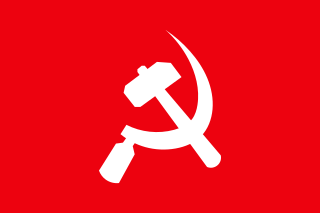
The Communist Party of India (Maoist) is a Marxist–Leninist–Maoist banned communist political party and militant organization in India which aims to overthrow the "semi-colonial and semi-feudal Indian state" through protracted people's war. It was founded on 21 September 2004, through the merger of the Communist Party of India (Marxist–Leninist) People's War and the Maoist Communist Centre of India (MCCI). The CPI (Maoist) are also known as the Naxalites, in reference to the Naxalbari insurrection conducted by radical Maoists in West Bengal since 1967. The party has been designated as a terrorist organisation in India under the Unlawful Activities (Prevention) Act since 2009.
The April 2010 Dantewada Maoist attack was an 6 April 2010 ambush by Naxalite-Maoist insurgents from the Communist Party of India (Maoist) near Chintalnar village in Dantewada district, Chhattisgarh, India, leading to the killing of 76 CRPF policemen and 8 Maoists — the deadliest attack by the Maoists on Indian security forces.

The Central Reserve Police Force (CRPF) is a federal police organisation in India under the authority of the Ministry of Home Affairs (MHA) of the Government of India. It is one among the Central Armed Police Forces. The CRPF's primary role lies in assisting the State/Union Territories in police operations to maintain law and order and counter-insurgency. It is composed of Central Reserve Police Force (Regular) and Central Reserve Police Force (Auxiliary).
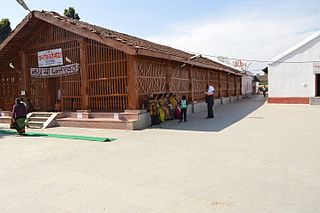
Dantewada District, also known as Dantewara District or Dakshin Bastar District, is a district in the Indian state of Chhattisgarh. Dantewada is the district headquarters. The district is part of Bastar Division. Until 1998, Dantewada District was a tehsil of the larger Bastar District.
Maoist rebels kill 76 CRPF officers in Dantewada district, India.
The April 2010 Dantewada Maoist attack was an 6 April 2010 ambush by Naxalite-Maoist insurgents from the Communist Party of India (Maoist) near Chintalnar village in Dantewada district, Chhattisgarh, India, leading to the killing of 76 CRPF policemen and 8 Maoists — the deadliest attack by the Maoists on Indian security forces.

The Central Reserve Police Force (CRPF) is a federal police organisation in India under the authority of the Ministry of Home Affairs (MHA) of the Government of India. It is one among the Central Armed Police Forces. The CRPF's primary role lies in assisting the State/Union Territories in police operations to maintain law and order and counter-insurgency. It is composed of Central Reserve Police Force (Regular) and Central Reserve Police Force (Auxiliary).

Dantewada District, also known as Dantewara District or Dakshin Bastar District, is a district in the Indian state of Chhattisgarh. Dantewada is the district headquarters. The district is part of Bastar Division. Until 1998, Dantewada District was a tehsil of the larger Bastar District.
A 6.3 Mw earthquake struck the region of Abruzzo in central Italy, killing 308 people and injuring more than 1,500 others.
The moment magnitude scale is a measure of an earthquake's magnitude based on its seismic moment. It was defined in a 1979 paper by Thomas C. Hanks and Hiroo Kanamori. Similar to the local magnitude scale (ML ) defined by Charles Francis Richter in 1935, it uses a logarithmic scale; small earthquakes have approximately the same magnitudes on both scales.

The 2009 L'Aquila earthquake occurred in the region of Abruzzo, in central Italy. The main shock occurred at 03:32 CEST on 6 April 2009, and was rated 5.8 or 5.9 on the Richter magnitude scale and 6.3 on the moment magnitude scale; its epicentre was near L'Aquila, the capital of Abruzzo, which together with surrounding villages suffered the most damage. There have been several thousand foreshocks and aftershocks since December 2008, more than thirty of which had a Richter magnitude greater than 3.5.

Abruzzo is a region of Southern Italy with an area of 10,763 square km and a population of 1.3 million. It is divided into four provinces: L'Aquila, Teramo, Pescara, and Chieti. Its western border lies 80 km (50 mi) east of Rome. Abruzzo borders the region of Marche to the north, Lazio to the west and north-west, Molise to the south and the Adriatic Sea to the east. Geographically, Abruzzo is divided into a mountainous area in the west, which includes the highest massifs of the Apennines, such as the Gran Sasso d'Italia and the Maiella, and a coastal area in the east with beaches on the Adriatic Sea.
Mass protests began across Moldova against the results of the parliamentary election.

Protests against the April 2009 Moldovan parliamentary election results began on 6 April 2009 in major cities of Moldova before the final official results were announced. The demonstrators claimed that the elections, which saw the governing Party of Communists of the Republic of Moldova (PCRM) win a majority of seats, were fraudulent, and alternatively demanded a recount, a new election, or resignation of the government. Similar demonstrations took place in other major Moldovan cities, including the country's second largest, Bălți, where over 7,000 people protested.

Parliamentary elections were held in Moldova on 5 April 2009. The Party of Communists of the Republic of Moldova (PCRM) won a majority of seats for the third consecutive occasion. Turnout was 59%, exceeding the 50% necessary for the election to be valid.
A 6.3 magnitude earthquake strikes near L'Aquila, Italy, killing 307.

The 2009 L'Aquila earthquake occurred in the region of Abruzzo, in central Italy. The main shock occurred at 03:32 CEST on 6 April 2009, and was rated 5.8 or 5.9 on the Richter magnitude scale and 6.3 on the moment magnitude scale; its epicentre was near L'Aquila, the capital of Abruzzo, which together with surrounding villages suffered the most damage. There have been several thousand foreshocks and aftershocks since December 2008, more than thirty of which had a Richter magnitude greater than 3.5.

L'Aquila is a city and comune in central Italy. It is the capital city of both the Abruzzo region and of the Province of L'Aquila. As of 2013, it has a population of 70,967 inhabitants. Laid out within medieval walls on a hill in the wide valley of the Aterno river, it is surrounded by the Apennine Mountains, with the Gran Sasso d'Italia to the north-east.
Egyptian workers staged an illegal general strike, two days before key municipal elections.
The 2008 Egyptian general strike was a strike which occurred on 6 April 2008, by Egyptian workers, primarily in the state-run textile industry, in response to low wages and rising food costs. Strikes are illegal in Egypt and authorities have been given orders to break demonstrations forcefully in the past. The strike took place just two days before key municipal elections.

The 2008 Egyptian municipal elections were local elections held across Egypt on 8 April 2008.
The 2008 Egyptian general strike starts led by Egyptian workers later to be adopted by April 6 Youth Movement and Egyptian activists.
The 2008 Egyptian general strike was a strike which occurred on 6 April 2008, by Egyptian workers, primarily in the state-run textile industry, in response to low wages and rising food costs. Strikes are illegal in Egypt and authorities have been given orders to break demonstrations forcefully in the past. The strike took place just two days before key municipal elections.

Egypt, officially the Arab Republic of Egypt, is a transcontinental country spanning the northeast corner of Africa and southwest corner of Asia via a land bridge formed by the Sinai Peninsula. It is bordered by the Mediterranean Sea to the north, the Gaza Strip of Palestine and Israel to the northeast, the Red Sea to the east, Sudan to the south, and Libya to the west. The Gulf of Aqaba in the northeast separates Egypt from Jordan and Saudi Arabia. Cairo is the capital and largest city of Egypt, while Alexandria, the second-largest city, is an important industrial and tourist hub at the Mediterranean coast. At approximately 100 million inhabitants, Egypt is the 14th-most populated country in the world.
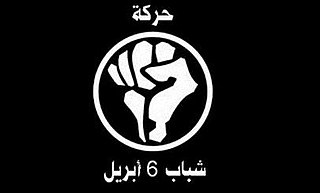
The April 6 Youth Movement is an Egyptian activist group established in Spring 2008 to support the workers in El-Mahalla El-Kubra, an industrial town, who were planning to strike on 6 April.
Kurdish leader Jalal Talabani was elected by the Iraqi National Assembly as the first non-Arab President of Iraq.
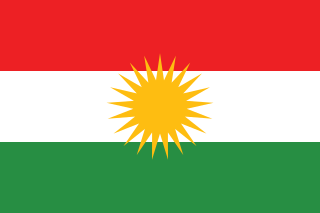
Kurds or Kurdish people are an Iranian ethnic group native to the mountainous region of Kurdistan in Western Asia, which spans southeastern Turkey, northwestern Iran, northern Iraq, and northern Syria. There are exclaves of Kurds in Central Anatolia, Khorasan, and the Caucasus, as well as significant Kurdish diaspora communities in the cities of western Turkey and Western Europe. The Kurdish population is estimated to be between 30 and 45 million.
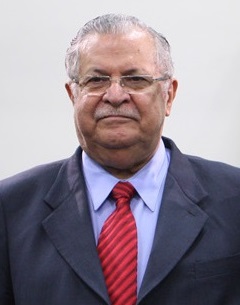
Jalal Talabani was an Iraqi Kurdish politician who served as the sixth president of Iraq from 2006 to 2014, as well as the president of the Governing Council of Iraq. He was the first non-Arab president of Iraq. He is known as Mam Jalal amongst the Kurds.

The Council of Representatives, usually referred to simply as the Parliament is the unicameral legislature of the Republic of Iraq. As of 2020, it comprises 329 seats and meets in Baghdad inside the Green Zone.

The President of Iraq is the head of state of Iraq and "safeguards the commitment to the Constitution and the preservation of Iraq's independence, sovereignty, unity, the security of its territories in accordance with the provisions of the Constitution". The president is elected by the Council of Representatives by a two-thirds majority, and is limited to two four-year terms. The president is responsible for ratifying treaties and laws passed by the Council of Representatives, issues pardons on the recommendation of the prime minister, and performs the "duty of the Higher Command of the armed forces for ceremonial and honorary purposes". Since the mid-2000s, the presidency is primarily a symbolic office, as the position does not possess significant power within the country according to the October 2005-adopted constitution. By convention, though not by any official legal requirement, the office is expected to be held by a Kurd.
Kurdish leader Jalal Talabani becomes Iraqi president; Shiite Arab Ibrahim al-Jaafari is named premier the next day.

Jalal Talabani was an Iraqi Kurdish politician who served as the sixth president of Iraq from 2006 to 2014, as well as the president of the Governing Council of Iraq. He was the first non-Arab president of Iraq. He is known as Mam Jalal amongst the Kurds.

Iraq, officially the Republic of Iraq, is a country in Western Asia. It is bordered by Turkey to the north, Iran to the east, the Persian Gulf and Kuwait to the southeast, Saudi Arabia to the south, Jordan to the southwest and Syria to the west. The capital and largest city is Baghdad. Iraq is home to diverse ethnic groups including Iraqi Arabs, Kurds, Turkmens, Assyrians, Armenians, Yazidis, Mandaeans, Persians and Shabakis with similarly diverse geography and wildlife. The vast majority of the country's 44 million residents are Muslims – the notable other faiths are Christianity, Yazidism, Mandaeism, Yarsanism and Zoroastrianism. The official languages of Iraq are Arabic and Kurdish; others also recognised in specific regions are Neo-Aramaic, Turkish and Armenian.
Premier is a title for the head of government in central governments, state governments and local governments of some countries. A second in command to a premier is designated as a deputy premier.
Lithuanian president Rolandas Paksas became the first European head of state to be removed from office by impeachment.
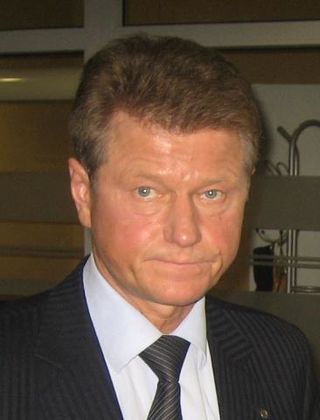
Rolandas Paksas is a Lithuanian politician who was the sixth President of Lithuania from 2003 to 2004. He was previously Prime Minister of Lithuania in 1999 and again from 2000 to 2001, and he also served as Mayor of Vilnius from 1997 to 1999 and again from 2000 to 2001. He led Order and Justice from 2004 to 2016 and was a Member of the European Parliament from 2009 to 2019.

Impeachment is the process by which a legislative body or other legally constituted tribunal initiates charges against a public official for misconduct. It may be understood as a unique process involving both political and legal elements.
Rolandas Paksas becomes the first president of Lithuania to be peacefully removed from office by impeachment.

Rolandas Paksas is a Lithuanian politician who was the sixth President of Lithuania from 2003 to 2004. He was previously Prime Minister of Lithuania in 1999 and again from 2000 to 2001, and he also served as Mayor of Vilnius from 1997 to 1999 and again from 2000 to 2001. He led Order and Justice from 2004 to 2016 and was a Member of the European Parliament from 2009 to 2019.

Lithuania, officially the Republic of Lithuania, is a country in the Baltic region of Europe. It is one of three Baltic states and lies on the eastern shore of the Baltic Sea. Lithuania shares land borders with Latvia to the north, Belarus to the east and south, Poland to the south, and Russia to the southwest. It has a maritime border with Sweden to the west on the Baltic Sea. Lithuania covers an area of 65,300 km2 (25,200 sq mi), with a population of 2.8 million. Its capital and largest city is Vilnius; other major cities are Kaunas and Klaipėda. Lithuanians belong to the ethno-linguistic group of the Balts and speak Lithuanian, one of only a few living Baltic languages.

Impeachment is the process by which a legislative body or other legally constituted tribunal initiates charges against a public official for misconduct. It may be understood as a unique process involving both political and legal elements.
Nuclear weapons testing: Pakistan tests medium-range missiles capable of reaching India.

Nuclear weapons tests are experiments carried out to determine nuclear weapons' effectiveness, yield, and explosive capability. Testing nuclear weapons offers practical information about how the weapons function, how detonations are affected by different conditions, and how personnel, structures, and equipment are affected when subjected to nuclear explosions. However, nuclear testing has often been used as an indicator of scientific and military strength. Many tests have been overtly political in their intention; most nuclear weapons states publicly declared their nuclear status through a nuclear test.

Pakistan, officially the Islamic Republic of Pakistan, is a country in South Asia. It is the world's fifth-most populous country, with a population of almost 243 million people, and has the world's second-largest Muslim population just behind Indonesia. Pakistan is the 33rd-largest country in the world by area and 2nd largest in South Asia, spanning 881,913 square kilometres. It has a 1,046-kilometre (650-mile) coastline along the Arabian Sea and Gulf of Oman in the south, and is bordered by India to the east, Afghanistan to the west, Iran to the southwest, and China to the northeast. It is separated narrowly from Tajikistan by Afghanistan's Wakhan Corridor in the north, and also shares a maritime border with Oman. Islamabad is the nation's capital, while Karachi is its largest city and financial centre.
In Greene County, Tennessee, the Lillelid murders occur.
The Lillelid murders refers to a criminal case in Greene County, Tennessee, United States, where three members of the Lillelid family were murdered on April 6, 1997. Vidar Lillelid, Delfina Lillelid, and their daughter Tabitha, and son Peter were shot on a deserted rural road near Baileyton during a carjacking committed by a group of youths. Vidar and Delfina were found dead at the scene, while Tabitha died after being transported to the hospital. Peter survived, but, as a result of the shooting, was left with disabilities. Six young people from Kentucky, including two minors, were convicted of felony murder for the deaths of Vidar, Delfina, and Tabitha Lillelid, with all six perpetrators receiving three life sentences, and an additional sentence of 25 years each for the attempted murder of Peter Lillelid.
The aircraft carrying Rwandan president Juvénal Habyarimana (pictured) and Burundian president Cyprien Ntaryamira was shot down in Kigali; the event became the catalyst for the Rwandan genocide.

Juvénal Habyarimana was a Rwandan politician and military officer who served as the second president of Rwanda, from 1973 until 1994. He was nicknamed Kinani, a Kinyarwanda word meaning "invincible".

Cyprien Ntaryamira was a Burundian politician who served as President of Burundi from 5 February 1994 until his death two months later. A Hutu born in Burundi, Ntaryamira studied there before fleeing to Rwanda to avoid ethnic violence and complete his education. Active in a Burundian student movement, he cofounded the socialist Burundi Workers' Party and earned an agricultural degree. In 1983 he returned to Burundi and worked agricultural jobs, though he was briefly detained as a political prisoner. In 1986 he cofounded the Front for Democracy in Burundi (FRODEBU), and in 1993 FRODEBU won Burundi's general elections. He subsequently became the Minister of Agriculture and Animal Husbandry on 10 July, but in October Tutsi soldiers killed the president and other top officials in an attempted coup.
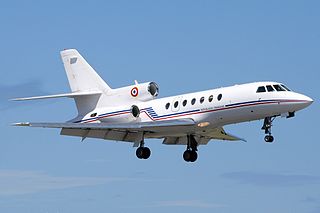
On the evening of 6 April 1994, the aircraft carrying Rwandan president Juvénal Habyarimana and Burundian president Cyprien Ntaryamira, both Hutu, was shot down with surface-to-air missiles as their jet prepared to land in Kigali, Rwanda. The assassination set in motion the Rwandan genocide, one of the bloodiest events of the late 20th century.

Kigali is the capital and largest city of Rwanda. It is near the nation's geographic centre in a region of rolling hills, with a series of valleys and ridges joined by steep slopes. As a primate city, Kigali has been Rwanda's economic, cultural, and transport hub since it became the capital following independence from Belgian rule in 1962.

The Rwandan genocide occurred between 7 April and 15 July 1994 during the Rwandan Civil War. During this period of around 100 days, members of the Tutsi minority ethnic group, as well as some moderate Hutu and Twa, were killed by armed Hutu militias. The most widely accepted scholarly estimates are around 500,000 to 662,000 Tutsi deaths.
The Rwandan genocide begins when the aircraft carrying Rwandan president Juvénal Habyarimana and Burundian president Cyprien Ntaryamira is shot down.

The Rwandan genocide occurred between 7 April and 15 July 1994 during the Rwandan Civil War. During this period of around 100 days, members of the Tutsi minority ethnic group, as well as some moderate Hutu and Twa, were killed by armed Hutu militias. The most widely accepted scholarly estimates are around 500,000 to 662,000 Tutsi deaths.

Rwanda, officially the Republic of Rwanda, is a landlocked country in the Great Rift Valley of Central Africa, where the African Great Lakes region and Southeast Africa converge. Located a few degrees south of the Equator, Rwanda is bordered by Uganda, Tanzania, Burundi, and the Democratic Republic of the Congo. It is highly elevated, giving it the soubriquet "land of a thousand hills", with its geography dominated by mountains in the west and savanna to the southeast, with numerous lakes throughout the country. The climate is temperate to subtropical, with two rainy seasons and two dry seasons each year. Rwanda has a population of over 12.6 million living on 26,338 km2 (10,169 sq mi) of land, and is the most densely populated mainland African country; among countries larger than 10,000 km2, it is the fifth most densely populated country in the world. One million people live in the capital and largest city Kigali.

President is a common title for the head of state in most republics. The president of a nation is, generally speaking, the head of the government and the fundamental leader of the country or the ceremonial head of state.

Juvénal Habyarimana was a Rwandan politician and military officer who served as the second president of Rwanda, from 1973 until 1994. He was nicknamed Kinani, a Kinyarwanda word meaning "invincible".
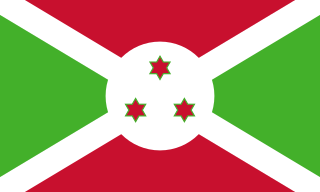
Burundi, officially the Republic of Burundi, is a landlocked country in the Great Rift Valley at the junction between the African Great Lakes region and East Africa. It is bordered by Rwanda to the north, Tanzania to the east and southeast, and the Democratic Republic of the Congo to the west; Lake Tanganyika lies along its southwestern border. The capital cities are Gitega and Bujumbura, the latter being the country's largest city.

Cyprien Ntaryamira was a Burundian politician who served as President of Burundi from 5 February 1994 until his death two months later. A Hutu born in Burundi, Ntaryamira studied there before fleeing to Rwanda to avoid ethnic violence and complete his education. Active in a Burundian student movement, he cofounded the socialist Burundi Workers' Party and earned an agricultural degree. In 1983 he returned to Burundi and worked agricultural jobs, though he was briefly detained as a political prisoner. In 1986 he cofounded the Front for Democracy in Burundi (FRODEBU), and in 1993 FRODEBU won Burundi's general elections. He subsequently became the Minister of Agriculture and Animal Husbandry on 10 July, but in October Tutsi soldiers killed the president and other top officials in an attempted coup.

On the evening of 6 April 1994, the aircraft carrying Rwandan president Juvénal Habyarimana and Burundian president Cyprien Ntaryamira, both Hutu, was shot down with surface-to-air missiles as their jet prepared to land in Kigali, Rwanda. The assassination set in motion the Rwandan genocide, one of the bloodiest events of the late 20th century.
The Bosnian War begins.
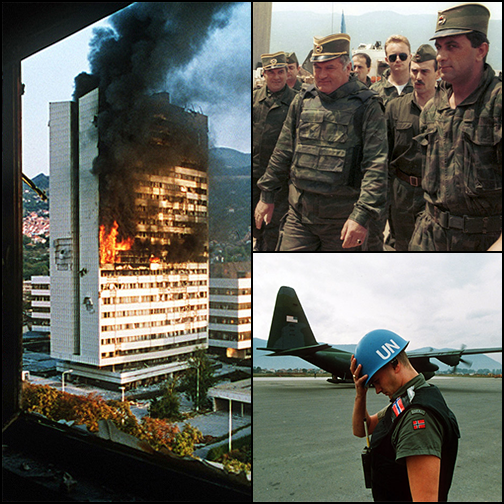
The Bosnian War was an international armed conflict that took place in Bosnia and Herzegovina between 1992 and 1995. The war is commonly seen as having started on 6 April 1992, following a number of earlier violent incidents. The war ended on 14 December 1995 when the Dayton accords were signed. The main belligerents were the forces of the Republic of Bosnia and Herzegovina and those of Herzeg-Bosnia and Republika Srpska, proto-states led and supplied by Croatia and Serbia, respectively.
Members of Cameroon's Republican Guard unsuccessfully attempt to overthrow the government headed by Paul Biya.

Cameroon, officially the Republic of Cameroon, is a country in west-central Africa. It is bordered by Nigeria to the west and north; Chad to the northeast; the Central African Republic to the east; and Equatorial Guinea, Gabon and the Republic of the Congo to the south. Its coastline lies on the Bight of Biafra, part of the Gulf of Guinea and the Atlantic Ocean. Due to its strategic position at the crossroads between West Africa and Central Africa, it has been categorized as being in both camps. Its nearly 27 million people speak 250 native languages.
An attempted coup d'état occurred in Cameroon in 1984, when presidential palace guards unsuccessfully tried to overthrow President Paul Biya. The fighting that resulted began on April 6, 1984, and ended several days later. The coup attempt is widely viewed as one of the most crucial events in the history of Cameroon since independence in 1960.

Paul Biya is a Cameroonian politician who has served as the president of Cameroon since 6 November 1982. He is the second-longest-ruling president in Africa and the oldest head of state in the world.
Launch of Pioneer 11 spacecraft.

Pioneer 11 is a 260-kilogram (570 lb) robotic space probe launched by NASA on April 5, 1973, to study the asteroid belt, the environment around Jupiter and Saturn, solar winds, and cosmic rays. It was the first probe to encounter Saturn, the second to fly through the asteroid belt, and the second to fly by Jupiter. Later, Pioneer 11 became the second of five artificial objects to achieve an escape velocity allowing it to leave the Solar System. Due to power constraints and the vast distance to the probe, the last routine contact with the spacecraft was on September 30, 1995, and the last good engineering data was received on November 24, 1995.

A spacecraft is a vehicle or machine designed to fly in outer space. A type of artificial satellite, spacecraft are used for a variety of purposes, including communications, Earth observation, meteorology, navigation, space colonization, planetary exploration, and transportation of humans and cargo. All spacecraft except single-stage-to-orbit vehicles cannot get into space on their own, and require a launch vehicle.
The American League of Major League Baseball begins using the designated hitter.

The American League of Professional Baseball Clubs, known simply as the American League (AL), is one of two leagues that make up Major League Baseball (MLB) in the United States and Canada. It developed from the Western League, a minor league based in the Great Lakes states, which eventually aspired to major league status. It is sometimes called the Junior Circuit because it claimed Major League status for the 1901 season, 25 years after the formation of the National League.

Major League Baseball (MLB) is a professional baseball organization and the oldest major professional sports league in the world. MLB is composed of 30 total teams, divided equally between the National League (NL) and the American League (AL), with 29 in the United States and 1 in Canada. The NL and AL were formed in 1876 and 1901, respectively. Beginning in 1903, the two leagues signed the National Agreement and cooperated but remained legally separate entities until 2000, when they merged into a single organization led by the Commissioner of Baseball. MLB is headquartered in Midtown Manhattan. It is also included as one of the major professional sports leagues in the United States and Canada.

The designated hitter (DH) is a baseball player who bats in place of another position player, most commonly the pitcher. The position is authorized by Major League Baseball Rule 5.11. It was adopted by the American League in 1973 and later by the National League in 2022, making it universal in MLB. Within that time frame, nearly all amateur, collegiate, and professional leagues worldwide have adopted the designated hitter or some variant, with the notable exception of Nippon Professional Baseball's Central League.
Vietnam War: Easter Offensive: American forces begin sustained air strikes and naval bombardments.

The Vietnam War was a conflict in Vietnam, Laos, and Cambodia from 1 November 1955 to the fall of Saigon on 30 April 1975. It was the second of the Indochina Wars and was officially fought between North Vietnam and South Vietnam. The north was supported by the Soviet Union, China, and other communist states, while the south was supported by the United States and other anti-communist allies. The war is widely considered to be a Cold War-era proxy war. It lasted almost 20 years, with direct U.S. involvement ending in 1973. The conflict also spilled over into neighboring states, exacerbating the Laotian Civil War and the Cambodian Civil War, which ended with all three countries becoming communist states by 1975.
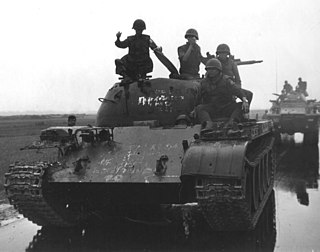
The Easter Offensive, also known as the 1972 spring–summer offensive by North Vietnam, or the red fiery summer as romanticized in South Vietnamese literature, was a military campaign conducted by the People's Army of Vietnam against the Army of the Republic of Vietnam and the United States military between 30 March and 22 October 1972, during the Vietnam War.
Four California Highway Patrol officers were killed in a shootout following a traffic stop in Newhall, north of Los Angeles.

The California Highway Patrol (CHP) is a state law enforcement agency of the U.S. state of California. The CHP has primary patrol jurisdiction over all California highways and roads and streets outside city limits, and can exercise law enforcement powers anywhere within the state. The California Highway Patrol can assist local and county agencies and can patrol major city streets along with local and county law enforcement, state and interstate highways, and is the primary law enforcement agency in rural parts of the state.

The Newhall incident, also called the Newhall massacre, was a shootout on April 5–6, 1970, in Valencia, California, between two heavily armed criminals and four officers of the California Highway Patrol (CHP). In less than five minutes, the four CHP officers were killed in the deadliest day in California law enforcement history.

A traffic stop, commonly referred to as being pulled over, is a temporary detention of a driver of a vehicle by police to investigate a possible crime or minor violation of law.

Newhall is the southernmost and oldest community in the city of Santa Clarita, California. Prior to the 1987 consolidation of Canyon Country, Saugus, Newhall, and Valencia into the city of Santa Clarita, it was an unincorporated area. It was the first permanent town in the Santa Clarita Valley.
Newhall massacre: Four California Highway Patrol officers are killed in a shootout.

The Newhall incident, also called the Newhall massacre, was a shootout on April 5–6, 1970, in Valencia, California, between two heavily armed criminals and four officers of the California Highway Patrol (CHP). In less than five minutes, the four CHP officers were killed in the deadliest day in California law enforcement history.

The California Highway Patrol (CHP) is a state law enforcement agency of the U.S. state of California. The CHP has primary patrol jurisdiction over all California highways and roads and streets outside city limits, and can exercise law enforcement powers anywhere within the state. The California Highway Patrol can assist local and county agencies and can patrol major city streets along with local and county law enforcement, state and interstate highways, and is the primary law enforcement agency in rural parts of the state.
In the downtown district of Richmond, Indiana, a double explosion kills 41 and injures 150.

Richmond is a city in eastern Wayne County, Indiana. Bordering the state of Ohio, it is the county seat of Wayne County and is part of the Dayton, OH Metropolitan Statistical Area In the 2010 census, the city had a population of 36,812. Situated largely within Wayne Township, its area includes a non-contiguous portion in nearby Boston Township, where Richmond Municipal Airport is currently located.
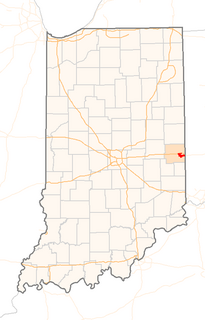
The Richmond, Indiana, explosion was a double explosion in the United States in 1968. It occurred at 1:47 PM EST on April 6, in downtown Richmond, Indiana. The explosions killed 41 people and injured more than 150. The primary explosion was due to natural gas leaking from one or more faulty transmission lines under the Marting Arms sporting goods store, located on the southeast corner of the intersection of 6th and Main streets. A secondary explosion was caused by gunpowder stored inside the building.
Pierre Elliott Trudeau wins the Liberal Party leadership election, and becomes Prime Minister of Canada soon afterward.

Joseph Philippe Pierre Yves Elliott Trudeau, also referred to by his initials PET, was a Canadian lawyer and politician who served as the 15th prime minister of Canada from 1968 to 1979 and from 1980 to 1984. He also briefly served as the leader of the Opposition from 1979 to 1980. He served as leader of the Liberal Party of Canada from 1968 to 1984.
The 1968 Liberal Party of Canada leadership election was held on April 6, 1968. The election was won by Minister of Justice and Attorney General Pierre Elliott Trudeau, who became the new Prime Minister of Canada as a result. He was the unexpected winner in what was one of the most important leadership conventions in party history. The Globe and Mail's newspaper report the next day called it "the most chaotic, confusing, and emotionally draining convention in Canadian political history."
Launch of Early Bird, the first commercial communications satellite to be placed in geosynchronous orbit.

Intelsat I was the first commercial communications satellite to be placed in geosynchronous orbit, on April 6, 1965. It was built by the Space and Communications Group of Hughes Aircraft Company for COMSAT, which activated it on June 28, 1965. It was based on the Syncom series of satellites that Hughes had previously built for NASA to demonstrate that communications via synchronous-orbit satellite were feasible. Its booster was a Thrust Augmented Delta. After a series of maneuvers, it reached its geosynchronous orbital position over the Atlantic Ocean at 28° West longitude, where it was put into service.

A satellite or artificial satellite is an object intentionally placed into orbit in outer space. Except for passive satellites, most satellites have an electricity generation system for equipment on board, such as solar panels or radioisotope thermoelectric generators (RTGs). Most satellites also have a method of communication to ground stations, called transponders. Many satellites use a standardized bus to save cost and work, the most popular of which is small CubeSats. Similar satellites can work together as a group, forming constellations. Because of the high launch cost to space, satellites are designed to be as lightweight and robust as possible. Most communication satellites are radio relay stations in orbit and carry dozens of transponders, each with a bandwidth of tens of megahertz.

A geosynchronous orbit is an Earth-centered orbit with an orbital period that matches Earth's rotation on its axis, 23 hours, 56 minutes, and 4 seconds. The synchronization of rotation and orbital period means that, for an observer on Earth's surface, an object in geosynchronous orbit returns to exactly the same position in the sky after a period of one sidereal day. Over the course of a day, the object's position in the sky may remain still or trace out a path, typically in a figure-8 form, whose precise characteristics depend on the orbit's inclination and eccentricity. A circular geosynchronous orbit has a constant altitude of 35,786 km (22,236 mi).
Capital Airlines Flight 67 crashes into Saginaw Bay near Freeland, Michigan, killing 47.

Capital Airlines Flight 67 was a domestic scheduled U.S. passenger flight operated by Capital Airlines which crashed on final approach to Freeland, Michigan, during a severe snowstorm on April 6, 1958, killing all 47 people on board. The flight was en route from Flint-Bishop Airport to the Freeland-Tri City Airport when it crashed. Flight 67 was the first of four fatal crashes in the space of two years involving Capital Airlines Vickers Viscounts; the others were Capital Airlines Flight 300, Capital Airlines Flight 75, and Capital Airlines Flight 20.

Saginaw Bay is a bay within Lake Huron located on the eastern side of the U.S. state of Michigan. It forms the space between Michigan's Thumb region and the rest of the Lower Peninsula of Michigan. Saginaw Bay is 1,143 square miles (2,960 km2) in area. It is located in parts of five Michigan counties: Arenac, Bay, Huron, Iosco, and Tuscola.

Freeland is a census-designated place in Tittabawassee Township, Saginaw County in the U.S. state of Michigan. It is part of the Saginaw-Midland-Bay Metropolitan Area. As of the 2000 census, the CDP population was 5,147. The CDP covers an area in the central portion of Tittabawassee Township. The Freeland post office, ZIP code 48623, serves nearly the entire township, as well as portions of Midland and Williams townships to the north, Frankenlust and Kochville townships to the east, Thomas and Richland townships to the south, and Ingersoll Township to the west.
The flag carrier airline of Greece for decades, Olympic Airways, is founded by Aristotle Onassis following the acquisition of "TAE - Greek National Airlines".
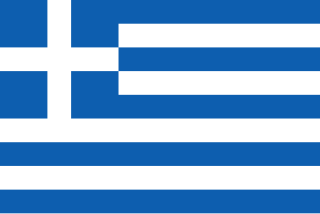
Greece, officially the Hellenic Republic, is a country in Southeast Europe. It is situated on the southern tip of the Balkans, and is located at the crossroads of Europe, Asia, and Africa. Greece shares land borders with Albania to the northwest, North Macedonia and Bulgaria to the north, and Turkey to the northeast. The Aegean Sea lies to the east of the mainland, the Ionian Sea to the west, and the Sea of Crete and the Mediterranean Sea to the south. Greece has the longest coastline on the Mediterranean Basin, featuring thousands of islands. The country consists of nine traditional geographic regions, and has a population of approximately 10.4 million. Athens is the nation's capital and largest city, followed by Thessaloniki and Patras.
Olympic Airlines, formerly named Olympic Airways for at least four decades, was the flag carrier airline of Greece. The airline's head office was located in Athens. The airline operated services to 37 domestic destinations and to 32 destinations world-wide. The airline's main base was at Athens International Airport, "Eleftherios Venizelos", with hubs at Thessaloniki International Airport, "Macedonia", Heraklion International Airport, "Nikos Kazantzakis" and Rhodes International Airport, "Diagoras". Olympic Airlines also owned a base at London Heathrow Airport. By December 2007, the airline employed about 8,500 staff.

Aristotle Socrates Onassis, was a Greek shipping magnate who amassed the world's largest privately-owned shipping fleet and was one of the world's richest and most famous men. He was married to Athina Mary Livanos, had a long-standing affair with opera singer Maria Callas and was married to Jacqueline Kennedy, the widow of US President John F. Kennedy.
The first Tony Awards, recognizing achievement in American theatre, were handed out at the Waldorf-Astoria Hotel in New York City.
The First Tony Awards, more formally known as the Antoinette Perry Awards for Excellence in Theatre, were held on April 6, 1947, in the Grand Ballroom of the Waldorf-Astoria Hotel in New York City. Perry was a co-founder of the revived and revised version the American Theatre Wing (ATW) in 1940, and the award were established by the ATW in her memory after her death in 1946. Fellow ATW co-founder Louise Heims Beck was responsible for overseeing the organization of the 1st Tony Awards.

The Antoinette Perry Award for Excellence in Broadway Theatre, more commonly known as the Tony Award, recognizes excellence in live Broadway theatre. The awards are presented by the American Theatre Wing and The Broadway League at an annual ceremony in Midtown Manhattan.
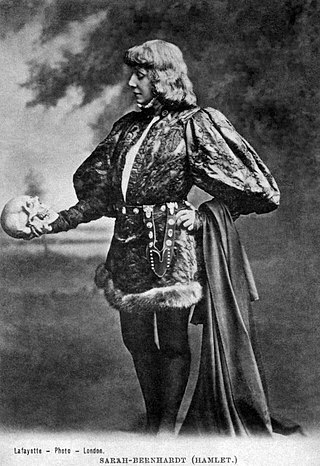
Theatre or theater is a collaborative form of performing art that uses live performers, usually actors or actresses, to present the experience of a real or imagined event before a live audience in a specific place, often a stage. The performers may communicate this experience to the audience through combinations of gesture, speech, song, music, and dance. Elements of art, such as painted scenery and stagecraft such as lighting are used to enhance the physicality, presence and immediacy of the experience. The specific place of the performance is also named by the word "theatre" as derived from the Ancient Greek θέατρον, itself from θεάομαι.

The Waldorf Astoria New York is a luxury hotel in Midtown Manhattan in New York City. The structure, at 301 Park Avenue between 49th and 50th Streets, is a 47-story 625 ft (191 m) Art Deco landmark designed by architects Schultze and Weaver, which was completed in 1931. The building was the world's tallest hotel from 1931 until 1963 when it was surpassed by Moscow's Hotel Ukraina by 23 feet (7.0 m). An icon of glamour and luxury, the current Waldorf Astoria is one of the world's most prestigious and best-known hotels. Waldorf Astoria Hotels & Resorts is a division of Hilton Hotels, and a portfolio of high-end properties around the world now operates under the name, including in New York City. Both the exterior and the interior of the Waldorf Astoria are designated by the New York City Landmarks Preservation Commission as official landmarks.
The first Tony Awards are presented for theatrical achievement.

The Antoinette Perry Award for Excellence in Broadway Theatre, more commonly known as the Tony Award, recognizes excellence in live Broadway theatre. The awards are presented by the American Theatre Wing and The Broadway League at an annual ceremony in Midtown Manhattan.
Second World War: The Battle of Slater's Knoll on Bougainville Island concluded with a decisive victory for the Australian Army's 7th Brigade against the Imperial Japanese Army's 6th Division.

World War II or the Second World War, often abbreviated as WWII or WW2, was a world war that lasted from 1939 to 1945. It involved the vast majority of the world's countries—including all of the great powers—forming two opposing military alliances: the Allies and the Axis powers. World War II was a total war that directly involved more than 100 million personnel from more than 30 countries.

The Battle of Slater's Knoll was a battle fought between Australian and Japanese forces on Bougainville Island during the Second World War. Part of the Bougainville campaign, the battle occurred as a force of about 3,300 Japanese from the Japanese 6th Division, including artillery and other supporting elements, launched a counterattack against the main Australian offensive which had been pushing south towards Buin, concentrating their attacks on Slater's Knoll near the Puriata River. The Australian troops belonged to the 7th Brigade, with the 25th Infantry Battalion being the most heavily engaged, although the 9th Infantry Battalion and the 61st Infantry Battalion also took part in the fighting.

Bougainville Island is the main island of the Autonomous Region of Bougainville, which is part of Papua New Guinea. It was previously the main landmass in the German Empire-associated North Solomons. Its land area is 9,300 km2 (3,600 sq mi). The population of the whole province, including nearby islets such as the Carterets, is approximately 300,000. The highest point is Mount Balbi, on the main island, at 2,715 m (8,907 ft). The much smaller Buka Island, c. 500 km2 (190 sq mi), lies to the north, across the 400–500 m (1,300–1,600 ft) wide Buka Strait. Even though the strait is narrow, there is no bridge across it, but there is a regular ferry service between the key settlements on either side. The main airport in the north is in the town of Buka.

The Australian Army is the principal land warfare force of Australia, a part of the Australian Defence Force (ADF) along with the Royal Australian Navy and the Royal Australian Air Force. The Army is commanded by the Chief of Army (CA), who is subordinate to the Chief of the Defence Force (CDF) who commands the ADF. The CA is also directly responsible to the Minister for Defence, with the Department of Defence administering the ADF and the Army.
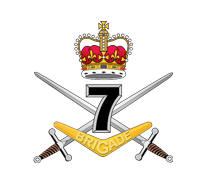
7th Brigade is a combined arms formation or brigade of the Australian Army. The brigade was first raised in 1912 as a Militia formation, although it was re-formed as part of the First Australian Imperial Force in early 1915 for service during World War I. It subsequently saw action at Gallipoli and on the Western Front during the war. Following the end of the war the brigade was disbanded in 1919 before being re-raised in 1921 as part of the Citizens Force. During World War II the brigade took part in the fighting against the Japanese in New Guinea and on Bougainville. Today, the 7th Brigade is part of Forces Command and is based in Brisbane, Queensland and is composed mainly of units of the Regular Army. While the brigade has not deployed as a whole unit since World War II, component units have deployed on operations to East Timor, the Solomon Islands, Iraq and Afghanistan.
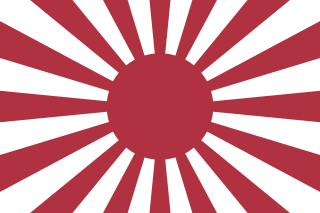
The Imperial Japanese Army was the official ground-based armed force of the Empire of Japan from 1868 to 1945. It was controlled by the Imperial Japanese Army General Staff Office and the Ministry of the Army, both of which were nominally subordinate to the Emperor of Japan as supreme commander of the army and the Imperial Japanese Navy. Later an Inspectorate General of Aviation became the third agency with oversight of the army. During wartime or national emergencies, the nominal command functions of the emperor would be centralized in an Imperial General Headquarters (IGHQ), an ad hoc body consisting of the chief and vice chief of the Army General Staff, the Minister of the Army, the chief and vice chief of the Naval General Staff, the Inspector General of Aviation, and the Inspector General of Military Training.
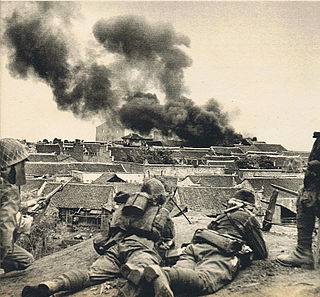
The 6th Division was an infantry division in the Imperial Japanese Army. Its call sign was the Bright Division .
World War II: Sarajevo is liberated from German and Croatian forces by the Yugoslav Partisans.

Sarajevo is the capital and largest city of Bosnia and Herzegovina, with a population of 275,524 in its administrative limits. The Sarajevo metropolitan area including Sarajevo Canton, East Sarajevo and nearby municipalities is home to 555,210 inhabitants. Located within the greater Sarajevo valley of Bosnia, it is surrounded by the Dinaric Alps and situated along the Miljacka River in the heart of the Balkans, a region of Southern Europe.

Nazi Germany was the German state between 1933 and 1945, when Adolf Hitler and the Nazi Party controlled the country, transforming it into a dictatorship. Under Hitler's rule, Germany quickly became a totalitarian state where nearly all aspects of life were controlled by the government. The Third Reich, meaning "Third Realm" or "Third Empire", alluded to the Nazi claim that Nazi Germany was the successor to the earlier Holy Roman Empire (800–1806) and German Empire (1871–1918). The Third Reich, which Hitler and the Nazis referred to as the Thousand-Year Reich, ended in May 1945 after just 12 years when the Allies defeated Germany, ending World War II in Europe.

The Independent State of Croatia was a World War II-era puppet state of Nazi Germany and Fascist Italy. It was established in parts of occupied Yugoslavia on 10 April 1941, after the invasion by the Axis powers. Its territory consisted of most of modern-day Croatia and Bosnia and Herzegovina, as well as some parts of modern-day Serbia and Slovenia, but also excluded many Croat-populated areas in Dalmatia, Istria, and Međimurje regions.
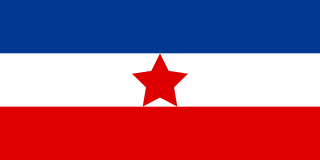
The Yugoslav Partisans, or the National Liberation Army, officially the National Liberation Army and Partisan Detachments of Yugoslavia, was the communist-led anti-fascist resistance to the Axis powers in occupied Yugoslavia during World War II. Led by Josip Broz Tito, the Partisans are considered to be Europe's most effective anti-Axis resistance movement during World War II.
World War II: The Battle of Slater's Knoll on Bougainville comes to an end.

The Battle of Slater's Knoll was a battle fought between Australian and Japanese forces on Bougainville Island during the Second World War. Part of the Bougainville campaign, the battle occurred as a force of about 3,300 Japanese from the Japanese 6th Division, including artillery and other supporting elements, launched a counterattack against the main Australian offensive which had been pushing south towards Buin, concentrating their attacks on Slater's Knoll near the Puriata River. The Australian troops belonged to the 7th Brigade, with the 25th Infantry Battalion being the most heavily engaged, although the 9th Infantry Battalion and the 61st Infantry Battalion also took part in the fighting.

Bougainville Island is the main island of the Autonomous Region of Bougainville, which is part of Papua New Guinea. It was previously the main landmass in the German Empire-associated North Solomons. Its land area is 9,300 km2 (3,600 sq mi). The population of the whole province, including nearby islets such as the Carterets, is approximately 300,000. The highest point is Mount Balbi, on the main island, at 2,715 m (8,907 ft). The much smaller Buka Island, c. 500 km2 (190 sq mi), lies to the north, across the 400–500 m (1,300–1,600 ft) wide Buka Strait. Even though the strait is narrow, there is no bridge across it, but there is a regular ferry service between the key settlements on either side. The main airport in the north is in the town of Buka.
World War II: German forces invaded Greece, beginning Operation Marita.

World War II or the Second World War, often abbreviated as WWII or WW2, was a world war that lasted from 1939 to 1945. It involved the vast majority of the world's countries—including all of the great powers—forming two opposing military alliances: the Allies and the Axis powers. World War II was a total war that directly involved more than 100 million personnel from more than 30 countries.
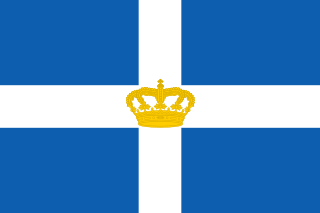
The Kingdom of Greece was established in 1832 and was the successor state to the First Hellenic Republic. It was internationally recognised by the Treaty of Constantinople, where Greece also secured its full independence from the Ottoman Empire after nearly four centuries.

The German invasion of Greece, also known as the Battle of Greece or Operation Marita, was the attack of Greece by Italy and Germany during World War II. The Italian invasion in October 1940, which is usually known as the Greco-Italian War, was followed by the German invasion in April 1941. German landings on the island of Crete came after Allied forces had been defeated in mainland Greece. These battles were part of the greater Balkans Campaign of the Axis powers and their associates.
World War II: The Luftwaffe began Operation Retribution, bombing the Yugoslav capital of Belgrade in retaliation for a coup d'état that overthrew the government that had signed the Tripartite Pact.

World War II or the Second World War, often abbreviated as WWII or WW2, was a world war that lasted from 1939 to 1945. It involved the vast majority of the world's countries—including all of the great powers—forming two opposing military alliances: the Allies and the Axis powers. World War II was a total war that directly involved more than 100 million personnel from more than 30 countries.

The Luftwaffe was the aerial-warfare branch of the German Wehrmacht before and during World War II. Germany's military air arms during World War I, the Luftstreitkräfte of the Imperial Army and the Marine-Fliegerabteilung of the Imperial Navy, had been disbanded in May 1920 in accordance with the terms of the 1919 Treaty of Versailles which banned Germany from having any air force.
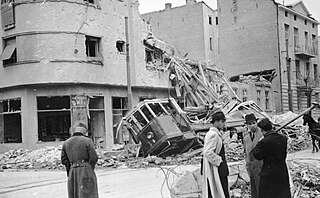
Operation Retribution, also known as Operation Punishment, was the April 1941 German bombing of Belgrade, the capital of Yugoslavia, in retaliation for the coup d'état that overthrew the government that had signed the Tripartite Pact. The bombing occurred in the first days of the German-led Axis invasion of Yugoslavia during World War II. The Royal Yugoslav Army Air Force (VVKJ) had only 77 modern fighter aircraft available to defend Belgrade against the hundreds of German fighters and bombers that struck in the first wave early on 6 April. Three days prior, VVKJ Major Vladimir Kren had defected to the Germans, disclosing the locations of multiple military assets and divulging the VVKJ's codes.
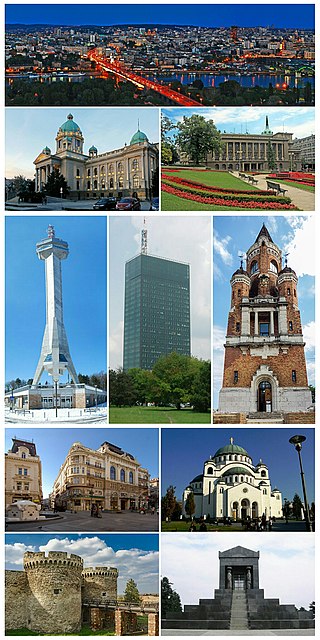
Belgrade is the capital and largest city in Serbia. It is located at the confluence of the Sava and Danube rivers and the crossroads of the Pannonian Plain and the Balkan Peninsula. Nearly 2.5 million people live within the administrative limits of the City of Belgrade. It is the third largest of all cities on the Danube river.

The Yugoslav coup d'état took place on 27 March 1941 in Belgrade, Kingdom of Yugoslavia, when the regency led by Prince Paul of Yugoslavia was overthrown and King Peter II fully assumed monarchical powers. The coup was planned and conducted by a group of pro-Western Serbian-nationalist Royal Yugoslav Army Air Force officers formally led by the Air Force commander, General Dušan Simović, who had been associated with several putsch plots from 1938 onwards. Brigadier General of Military Aviation Borivoje Mirković, Major Živan Knežević of the Yugoslav Royal Guards, and his brother Radoje Knežević were the main organisers in the overthrow of the government. In addition to Radoje Knežević, some other civilian leaders were probably aware of the takeover before it was launched and moved to support it once it occurred, but they were not among the organisers. Peter II himself was surprised by the coup, and heard of the declaration of his coming-of-age for the first time on the radio.

The Tripartite Pact, also known as the Berlin Pact, was an agreement between Germany, Italy, and Japan signed in Berlin on 27 September 1940 by, respectively, Joachim von Ribbentrop, Galeazzo Ciano and Saburō Kurusu. It was a defensive military alliance that was eventually joined by Hungary, Romania, Bulgaria and Yugoslavia as well as by the German client state of Slovakia. Yugoslavia's accession provoked a coup d'état in Belgrade two days later. Germany, Italy and Hungary responded by invading Yugoslavia. The resulting Italo-German client state, known as the Independent State of Croatia, joined the pact on 15 June 1941.
World War II: Nazi Germany launches Operation 25 (the invasion of Kingdom of Yugoslavia) and Operation Marita (the invasion of Greece).

World War II or the Second World War, often abbreviated as WWII or WW2, was a world war that lasted from 1939 to 1945. It involved the vast majority of the world's countries—including all of the great powers—forming two opposing military alliances: the Allies and the Axis powers. World War II was a total war that directly involved more than 100 million personnel from more than 30 countries.

Nazi Germany was the German state between 1933 and 1945, when Adolf Hitler and the Nazi Party controlled the country, transforming it into a dictatorship. Under Hitler's rule, Germany quickly became a totalitarian state where nearly all aspects of life were controlled by the government. The Third Reich, meaning "Third Realm" or "Third Empire", alluded to the Nazi claim that Nazi Germany was the successor to the earlier Holy Roman Empire (800–1806) and German Empire (1871–1918). The Third Reich, which Hitler and the Nazis referred to as the Thousand-Year Reich, ended in May 1945 after just 12 years when the Allies defeated Germany, ending World War II in Europe.

The invasion of Yugoslavia, also known as the April War or Operation 25, was a German-led attack on the Kingdom of Yugoslavia by the Axis powers which began on 6 April 1941 during World War II. The order for the invasion was put forward in "Führer Directive No. 25", which Adolf Hitler issued on 27 March 1941, following a Yugoslav coup d'état that overthrew the pro-Axis government.

The German invasion of Greece, also known as the Battle of Greece or Operation Marita, was the attack of Greece by Italy and Germany during World War II. The Italian invasion in October 1940, which is usually known as the Greco-Italian War, was followed by the German invasion in April 1941. German landings on the island of Crete came after Allied forces had been defeated in mainland Greece. These battles were part of the greater Balkans Campaign of the Axis powers and their associates.
Tupelo–Gainesville tornado outbreak: Another tornado from the same storm system as the Tupelo tornado hits Gainesville, Georgia, killing 203.
On April 5–6, 1936, an outbreak of at least 12 tornadoes struck the Southeastern United States. Approximately 454 people were killed by these tornadoes—419 by two tornadoes alone. This outbreak is the second deadliest ever recorded in US history. Although the outbreak was centered on Tupelo, Mississippi, and Gainesville, Georgia, where the fourth and fifth deadliest tornadoes in U.S. history respectively occurred, other destructive tornadoes associated with the outbreak struck Columbia, Tennessee; Anderson, South Carolina; and Acworth, Georgia.
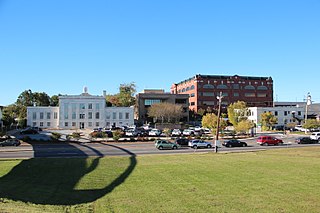
The city of Gainesville is the county seat of Hall County, Georgia, United States. As of the 2020 census, the city had a population of 42,296. Because of its large number of poultry processing plants, it is often called the "Poultry Capital of the World." Gainesville is the principal city of, and is included in, the Gainesville, Georgia Metropolitan Statistical Area, which is included in the Atlanta-Sandy Springs-Gainesville, Georgia Combined Statistical Area.
At the end of the Salt March, Gandhi raises a lump of mud and salt and declares, "With this, I am shaking the foundations of the British Empire."

The Salt March, also known as the Salt Satyagraha, Dandi March and the Dandi Satyagraha, was an act of nonviolent civil disobedience in colonial India led by Mahatma Gandhi. The twenty-four day march lasted from 12 March to 6 April 1930 as a direct action campaign of tax resistance and nonviolent protest against the British salt monopoly. Another reason for this march was that the Civil Disobedience Movement needed a strong inauguration that would inspire more people to follow Gandhi's example. Gandhi started this march with 78 of his trusted volunteers. The march spanned 385 kilometres (239 mi), from Sabarmati Ashram to Dandi, which was called Navsari at that time. Growing numbers of Indians joined them along the way. When Gandhi broke the British Raj salt laws at 8:30 am on 6 April 1930, it sparked large scale acts of civil disobedience against the salt laws by millions of Indians.

The British Empire was composed of the dominions, colonies, protectorates, mandates, and other territories ruled or administered by the United Kingdom and its predecessor states. It began with the overseas possessions and trading posts established by England between the late 16th and early 18th centuries. At its height it was the largest empire in history and, for over a century, was the foremost global power. By 1913, the British Empire held sway over 412 million people, 23 per cent of the world population at the time, and by 1920, it covered 35.5 million km2 (13.7 million sq mi), 24 per cent of the Earth's total land area. As a result, its constitutional, legal, linguistic, and cultural legacy is widespread. At the peak of its power, it was described as "the empire on which the sun never sets", as the Sun was always shining on at least one of its territories.
Huey P. Long, Governor of Louisiana, is impeached by the Louisiana House of Representatives.

Huey Pierce Long Jr., nicknamed "the Kingfish", was an American politician who served as the 40th governor of Louisiana from 1928 to 1932 and as a United States senator from 1932 until his assassination in 1935. He was a left-wing populist member of the Democratic Party and rose to national prominence during the Great Depression for his vocal criticism of President Franklin D. Roosevelt and his New Deal, which Long deemed insufficiently radical. As the political leader of Louisiana, he commanded wide networks of supporters and often took forceful action. A controversial figure, Long is celebrated as a populist champion of the poor or, conversely, denounced as a fascistic demagogue.

The governor of Louisiana is the head of state and head of government of the U.S. state of Louisiana. The governor is the head of the executive branch of Louisiana's state government and is charged with enforcing state laws.

Impeachment is the process by which a legislative body or other legally constituted tribunal initiates charges against a public official for misconduct. It may be understood as a unique process involving both political and legal elements.
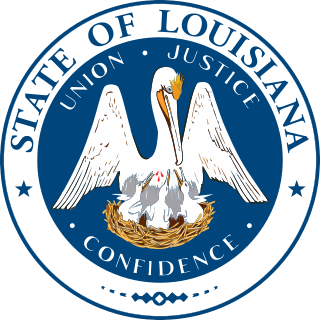
The Louisiana House of Representatives is the lower house in the Louisiana State Legislature, the state legislature of the U.S. state of Louisiana. This chamber is composed of 105 representatives, each of whom represents approximately 42,500 people. Members serve four-year terms with a term limit of three terms. The House is one of the five state legislative lower houses that has a four-year term, as opposed to the near-universal two-year term.
Varney Airlines makes its first commercial flight (Varney is the root company of United Airlines).

Varney Air Lines was an airline company that started service on April 6, 1926, as an air-mail carrier. Formed by Walter Varney, the airline was based in Boise, Idaho, United States. The airline is one of the predecessors of United Airlines.
United Airlines, Inc., is a major American airline headquartered at the Willis Tower in Chicago, Illinois. United operates a large domestic and international route network spanning cities large and small across the United States and all six inhabited continents. Measured by fleet size and the number of routes, it is the third-largest airline in the world after its merger with Continental Airlines in 2010.
Finnish Civil War: The battle of Tampere ends.
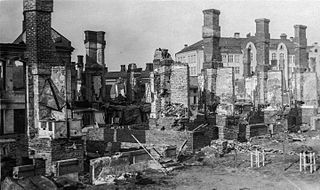
The Finnish Civil War was a civil war in Finland in 1918 fought for the leadership and control of the country between White Finland and the Finnish Socialist Workers' Republic during the country's transition from a grand duchy of the Russian Empire to an independent state. The clashes took place in the context of the national, political, and social turmoil caused by World War I in Europe. The war was fought between the "Reds", led by a section of the Social Democratic Party, and the "Whites", conducted by the conservative-based senate and the German Imperial Army. The paramilitary Red Guards, which were composed of industrial and agrarian workers, controlled the cities and industrial centers of southern Finland. The paramilitary White Guards, which consisted of land owners and those in the middle- and upper-classes, controlled rural central and northern Finland, and were led by General C. G. E. Mannerheim.

The Battle of Tampere was a 1918 Finnish Civil War battle, fought in Tampere, Finland from 15 March to 6 April between the Whites and the Reds. It is the most famous and the heaviest of all the Finnish Civil War battles. Today it is particularly remembered for its bloody aftermath as the Whites executed hundreds of capitulated Reds and took 11,000 prisoners placed in the Kalevankangas camp.
World War I: The United States declares war on Germany.

World War I or the First World War, often abbreviated as WWI or WW1, and referred to by some Anglophone authors as the "Great War" or the "War to End All Wars", was a global conflict which lasted from 1914 to 1918, and is considered one of the deadliest conflicts in history. Belligerents included much of Europe, the Russian Empire, the United States, and the Ottoman Empire, with fighting occurring throughout Europe, the Middle East, Africa, the Pacific, and parts of Asia. An estimated 9 million soldiers were killed in combat, plus another 23 million wounded, while 5 million civilians died as a result of military action, hunger, and disease. Millions more died in genocides within the Ottoman Empire and in the 1918 influenza pandemic, which was exacerbated by the movement of combatants during the war.

On April 2, 1917, President Woodrow Wilson asked a special joint session of the United States Congress for a declaration of war against the German Empire. Congress responded with the declaration on April 6.
During the Battle of Deçiq, Dedë Gjon Luli Dedvukaj, leader of the Malësori Albanians, raises the Albanian flag in the town of Tuzi, Montenegro, for the first time after George Kastrioti (Skanderbeg).
The Battle of Deçiq was a battle between Albanian tribesmen and Ottoman forces during the Malësori uprising of 1911. It was a turning point for Albania's secession from the Ottoman Empire. Dedë Gjo Luli, the organiser of the Albanian tribal forces, raised the Albanian flag for the first time since 1479 on the mountain of Deçiq after the Albanians had achieved victory over the Ottoman Turks.

Ded Gjo Luli Dedvukaj also referred to as Ded Gjon Luli was an Albanian guerrilla leader most notable for commanding the 1911 revolt against Ottoman troops. He was posthumously awarded the "Hero of Albania" title. Dedvukaj was the clan chieftain of the Hoti tribe.

Malësia e Madhe, known simply as Malësia, is a historical and ethnographic region in northern Albania and eastern central Montenegro corresponding to the highlands of the geographical subdivision of the Malësi e Madhe District in Albania and Tuzi Municipality in Montenegro. The largest settlement in the area is the town of Tuzi.
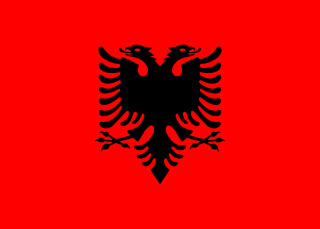
Albania, officially the Republic of Albania, is a country in Southeastern Europe. It is located on the Adriatic and Ionian Seas within the Mediterranean Sea and shares land borders with Montenegro to the northwest, Kosovo to the northeast, North Macedonia to the east and Greece to the south. Tirana is its capital and largest city, followed by Durrës, Vlorë, and Shkodër.

Tuzi is a small town in Montenegro and the seat of Tuzi Municipality, Montenegro. It is located along a main road between the city of Podgorica and the Albanian border crossing, just a few kilometers north of Lake Skadar. The Church of St. Anthony and Qazimbeg's Mosque are located in the centre of the town. Tuzi is the newest municipality in Montenegro, having been an independent municipality since 1 September 2018.

Montenegro is a country in Southeastern Europe. It is a part of the Balkans and is bordered by Serbia to the northeast, Bosnia and Herzegovina to the north, Kosovo to the east, Albania to the southeast, Croatia to the northwest, and the Adriatic Sea to the west with a coastline of 293.5 km. Podgorica, the capital and largest city, covers 10.4% of Montenegro's territory of 13,812 square kilometres (5,333 sq mi), and is home to roughly 30% of its total population of 621,000.

Gjergj Kastrioti, commonly known as Skanderbeg, was an Albanian feudal lord and military commander who led a rebellion against the Ottoman Empire in what is today Albania, North Macedonia, Greece, Kosovo, Montenegro, and Serbia.
Robert Peary and Matthew Henson become the first people to reach the North Pole; Peary's claim has been disputed because of failings in his navigational ability.

Robert Edwin Peary Sr. was an American explorer and officer in the United States Navy who made several expeditions to the Arctic in the late 19th and early 20th centuries. He is best known for, in April 1909, leading an expedition that claimed to be the first to have reached the geographic North Pole. Explorer Matthew Henson, part of the expedition, is thought to have reached what they believed to be the North Pole narrowly before Peary.

Matthew Alexander Henson was an African American explorer who accompanied Robert Peary on seven voyages to the Arctic over a period of nearly 23 years. They spent a total of 18 years on expeditions together. He is best known for his participation in the 1908–1909 expedition that claimed to have reached the geographic North Pole on April 6, 1909. Henson said he was the first of their party to reach the pole.

The North Pole, also known as the Geographic North Pole or Terrestrial North Pole, is the point in the Northern Hemisphere where the Earth's axis of rotation meets its surface. It is called the True North Pole to distinguish from the Magnetic North Pole.
The first modern Olympic Games opened in Athens, with athletes from 14 nations participating in 43 events.

The 1896 Summer Olympics, officially known as the Games of the I Olympiad and commonly known as Athens 1896, was the first international Olympic Games held in modern history. Organised by the International Olympic Committee (IOC), which had been created by French aristocrat Pierre de Coubertin, it was held in Athens, Greece, from 6 to 15 April 1896.
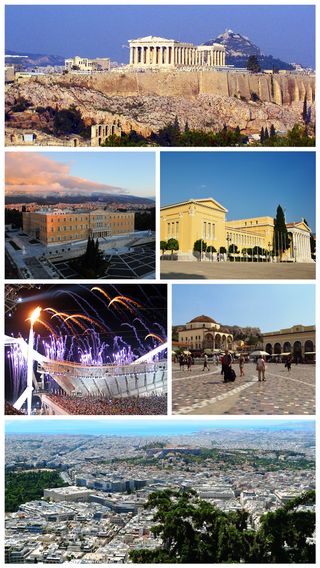
Athens is both the capital and largest city of Greece. With a population close to four million, it is also the seventh largest city in the European Union. Athens dominates and is the capital of the Attica region and is one of the world's oldest cities, with its recorded history spanning over 3,400 years and its earliest human presence beginning somewhere between the 11th and 7th millennia BC.
In Athens, the opening of the first modern Olympic Games is celebrated, 1,500 years after the original games are banned by Roman emperor Theodosius I.

Athens is both the capital and largest city of Greece. With a population close to four million, it is also the seventh largest city in the European Union. Athens dominates and is the capital of the Attica region and is one of the world's oldest cities, with its recorded history spanning over 3,400 years and its earliest human presence beginning somewhere between the 11th and 7th millennia BC.

The 1896 Summer Olympics, officially known as the Games of the I Olympiad and commonly known as Athens 1896, was the first international Olympic Games held in modern history. Organised by the International Olympic Committee (IOC), which had been created by French aristocrat Pierre de Coubertin, it was held in Athens, Greece, from 6 to 15 April 1896.

The Roman emperor was the ruler of the Roman Empire during the imperial period. The emperors used a variety of different titles throughout history. Often when a given Roman is described as becoming "emperor" in English it reflects his taking of the title augustus. Another title often used was caesar, used for heirs-apparent, and imperator, originally a military honorific. Early emperors also used the title princeps civitatis. Emperors frequently amassed republican titles, notably princeps senatus, consul, and pontifex maximus.
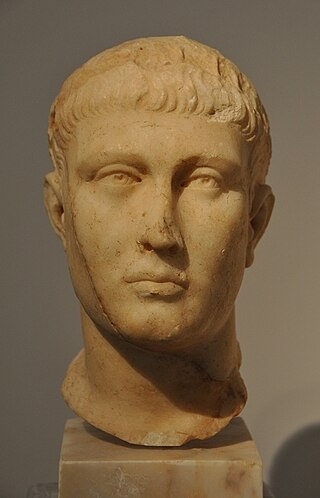
Theodosius I, also called Theodosius the Great, was Roman emperor from 379 to 395. During his reign, he succeeded in a crucial war against the Goths, as well as in two civil wars, and was instrumental in establishing the creed of Nicaea as the doctrine for Christianity. Theodosius was the last emperor to rule the entire Roman Empire before its administration was permanently split between two separate courts.
The Charter Oath, which stated the main aims and methods of action of the new Meiji era of Japan, was promulgated in Kyoto.
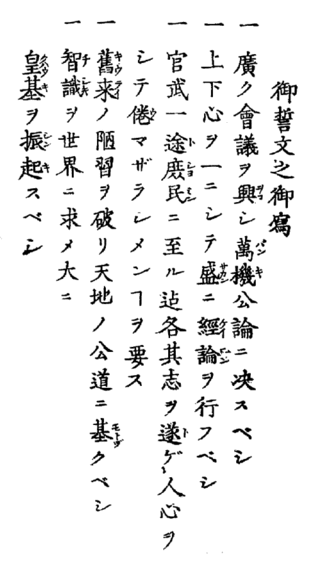
The Charter Oath was promulgated on 6 April 1868 in Kyoto Imperial Palace. The Oath outlined the main aims and the course of action to be followed during Emperor Meiji's reign, setting the legal stage for Japan's modernization. This also set up a process of urbanization as people of all classes were free to move jobs so people went to the city for better work. It remained influential, if less for governing than inspiring, throughout the Meiji era and into the twentieth century, and can be considered the first constitution of modern Japan.

The Meiji era is an era of Japanese history that extended from October 23, 1868 to July 30, 1912. The Meiji era was the first half of the Empire of Japan, when the Japanese people moved from being an isolated feudal society at risk of colonization by Western powers to the new paradigm of a modern, industrialized nation state and emergent great power, influenced by Western scientific, technological, philosophical, political, legal, and aesthetic ideas. As a result of such wholesale adoption of radically different ideas, the changes to Japan were profound, and affected its social structure, internal politics, economy, military, and foreign relations. The period corresponded to the reign of Emperor Meiji. It was preceded by the Keiō era and was succeeded by the Taishō era, upon the accession of Emperor Taishō.

Kyoto, officially Kyoto City , is the capital city of Kyoto Prefecture in Japan. Located in the Kansai region on the island of Honshu, Kyoto forms a part of the Keihanshin metropolitan area along with Osaka and Kobe. As of 2020, the city had a population of 1.46 million. The city is the cultural anchor of a substantially larger metropolitan area known as Greater Kyoto, a metropolitan statistical area (MSA) home to a census-estimated 3.8 million people.
The Grand Army of the Republic, an American patriotic organization composed of Union veterans of the American Civil War, is founded. It lasts until 1956.

The Grand Army of the Republic (GAR) was a fraternal organization composed of veterans of the Union Army, Union Navy, and the Marines who served in the American Civil War. It was founded in 1866 in Decatur, Illinois, and grew to include hundreds of "posts" across the North and West. It was dissolved in 1956 at the death of its last member.
American Civil War: The Battle of Sailor's Creek: Confederate General Robert E. Lee's Army of Northern Virginia fights and loses its last major battle while in retreat from Richmond, Virginia, during the Appomattox Campaign.

The Battle of Sailor's Creek was fought on April 6, 1865, near Farmville, Virginia, as part of the Appomattox Campaign, near the end of the American Civil War. It was the last major engagement between the Confederate Army of Northern Virginia, commanded by General Robert E. Lee and the Army of the Potomac, under the overall direction of Union General-in-Chief Lieutenant General Ulysses S. Grant.

Robert Edward Lee was a Confederate general during the American Civil War, towards the end of which he was appointed the overall commander of the Confederate States Army. He led the Army of Northern Virginia—the Confederacy's most powerful army—from 1862 until its surrender in 1865, earning a reputation as a skilled tactician.

The Army of Northern Virginia was the primary military force of the Confederate States of America in the Eastern Theater of the American Civil War. It was also the primary command structure of the Department of Northern Virginia. It was most often arrayed against the Union Army of the Potomac.

Richmond is the capital city of the Commonwealth of Virginia in the United States. It is the center of the Richmond Metropolitan Statistical Area and the Greater Richmond Region. Richmond was incorporated in 1742 and has been an independent city since 1871. At the 2010 census, the city's population was 204,214; in 2020, the population had grown to 226,610, making Richmond the fourth-most populous city in Virginia. The Richmond Metropolitan Area has a population of 1,260,029, the third-most populous metro in the state.

The Appomattox campaign was a series of American Civil War battles fought March 29 – April 9, 1865, in Virginia that concluded with the surrender of Confederate General Robert E. Lee's Army of Northern Virginia to forces of the Union Army under the overall command of Lieutenant General Ulysses S. Grant, marking the effective end of the war.
American Civil War: The Battle of Shiloh begins: In Tennessee, forces under Union General Ulysses S. Grant meet Confederate troops led by General Albert Sidney Johnston.

The American Civil War was a civil war in the United States. It was fought between the Union and the Confederacy, the latter formed by states that had seceded. The central cause of the war was the dispute over whether slavery would be permitted to expand into the western territories, leading to more slave states, or be prevented from doing so, which was widely believed would place slavery on a course of ultimate extinction.

The Battle of Shiloh was fought on April 6–7, 1862, in the American Civil War. The fighting took place in southwestern Tennessee, which was part of the war's Western Theater. The battlefield is located between a church named Shiloh and Pittsburg Landing, which is on the Tennessee River. Two Union armies combined to defeat the Confederate Army of Mississippi. Major General Ulysses S. Grant was the Union commander, while General Albert Sidney Johnston was the Confederate commander.

Tennessee, officially the State of Tennessee, is a landlocked state in the Southeastern region of the United States. Tennessee is the 36th-largest by area and the 16th-most populous of the 50 states. It is bordered by Kentucky to the north, Virginia to the northeast, North Carolina to the east, Georgia, Alabama, and Mississippi to the south, Arkansas to the southwest, and Missouri to the northwest. Tennessee is geographically, culturally, and legally divided into three Grand Divisions of East, Middle, and West Tennessee. Nashville is the state's capital and largest city, and anchors its largest metropolitan area. Other major cities include Memphis, Knoxville, Chattanooga, and Clarksville. Tennessee's population as of the 2020 United States census is approximately 6.9 million.

During the American Civil War, the Union, also known as the North, referred to the United States led by President Abraham Lincoln. It was opposed by the secessionist Confederate States of America (CSA), informally called "the Confederacy" or "the South". The Union is named after its declared goal of preserving the United States as a constitutional union. "Union" is used in the U.S. Constitution to refer to the founding formation of the people, and to the states in union. In the context of the Civil War, it has also often been used as a synonym for "the northern states loyal to the United States government;" in this meaning, the Union consisted of 20 free states and five border states.

Ulysses S. Grant was an American military officer and politician who served as the 18th president of the United States from 1869 to 1877. As Commanding General, he led the Union Army to victory in the American Civil War in 1865 and thereafter briefly served as Secretary of War. Later, as president, Grant was an effective civil rights executive who signed the bill that created the Justice Department and worked with Radical Republicans to protect African Americans during Reconstruction.

The Confederate States of America (CSA), commonly referred to as the Confederate States, the Confederacy, or "the South", was an unrecognized breakaway republic in North America that existed from February 8, 1861, to May 9, 1865. The Confederacy comprised U.S. states that declared secession and warred against the United States during the American Civil War. Eleven U.S. states, nicknamed Dixie, declared secession and formed the main part of the CSA. They were South Carolina, Mississippi, Florida, Alabama, Georgia, Louisiana, Texas, Virginia, Arkansas, Tennessee, and North Carolina. Kentucky, and Missouri also had declarations of secession and full representation in the Confederate Congress during their Union army occupation.

Albert Sidney Johnston served as a general in three different armies: the Texian Army, the United States Army, and the Confederate States Army. He saw extensive combat during his 34-year military career, fighting actions in the Black Hawk War, the Texas War of Independence, the Mexican–American War, the Utah War, and the American Civil War.
The Reorganized Church of Jesus Christ of Latter Day Saints, later renamed Community of Christ, is organized by Joseph Smith III and others at Amboy, Illinois.

The Community of Christ, known from 1872 to 2001 as the Reorganized Church of Jesus Christ of Latter Day Saints (RLDS), is an American-based international church, and is the second-largest denomination in the Latter Day Saint movement. The church reports 250,000 members in 1,100 congregations in 59 countries. The church traces its origins to Joseph Smith's establishment of the Church of Christ on April 6, 1830. His eldest son Joseph Smith III formally accepted leadership of the church on April 6, 1860 in the aftermath of the 1844 death of Joseph Smith.

Joseph Smith III was the eldest surviving son of Joseph Smith and Emma Hale Smith. Joseph Smith III was the Prophet-President of what became the Reorganized Church of Jesus Christ of Latter Day Saints, known as the Community of Christ since 2001, which considers itself a continuation of the church established by Smith's father in 1830. For fifty-four years until his own death, Smith presided over the church. Smith's moderate ideas and nature set much of the tone for the church's development, earning him the sobriquet of "the pragmatic prophet".
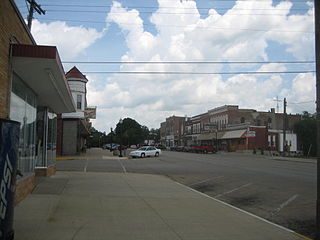
Amboy is a city in Lee County, Illinois, United States, along the Green River. The population was 2,500 at the 2010 census. The chain of Carson Pirie Scott & Co. began in Amboy when Samuel Carson opened his first dry goods store there in 1854. The Christian denomination Community of Christ, formerly the Reorganized Church of Jesus Christ of Latter Day Saints, had a general conference in Amboy on April 6, 1860, at which time Joseph Smith III reorganized the church founded by his father Joseph Smith, Jr.
U.S. President John Tyler is sworn in, two days after having become president upon William Henry Harrison's death.
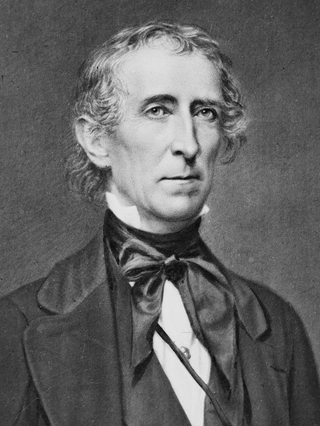
John Tyler was the tenth president of the United States, serving from 1841 to 1845, after briefly holding office as the tenth vice president in 1841. He was elected vice president on the 1840 Whig ticket with President William Henry Harrison, succeeding to the presidency following Harrison's death 31 days after assuming office. Tyler was a stalwart supporter and advocate of states' rights, including regarding slavery, and he adopted nationalistic policies as president only when they did not infringe on the states' powers. His unexpected rise to the presidency posed a threat to the presidential ambitions of Henry Clay and other Whig politicians and left Tyler estranged from both of the nation's major political parties at the time.

William Henry Harrison was an American military officer and politician who served as the ninth president of the United States. Harrison died just 31 days after his inauguration in 1841, and had the shortest presidency in United States history. He was also the first United States president to die in office, and a brief constitutional crisis resulted as presidential succession was not then fully defined in the United States Constitution. Harrison was the last president born as a British subject in the Thirteen Colonies and was the paternal grandfather of Benjamin Harrison, the 23rd president of the United States.
Joseph Smith, Oliver Cowdery, David Whitmer and others formally organized the Church of Christ, starting the Latter Day Saint movement.

Joseph Smith Jr. was an American religious leader and founder of Mormonism and the Latter Day Saint movement. When he was 24, Smith published the Book of Mormon. By the time of his death, 14 years later, he had attracted tens of thousands of followers and founded a religion that continues to the present with millions of global adherents.
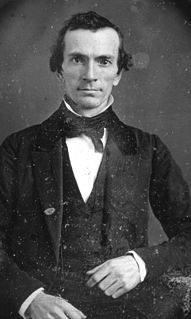
Oliver H. P. Cowdery was an American Mormon leader who, with Joseph Smith, was an important participant in the formative period of the Latter Day Saint movement between 1829 and 1836. He was the first baptized Latter Day Saint, one of the Three Witnesses of the Book of Mormon's golden plates, one of the first Latter Day Saint apostles, and the Second Elder of the church.
David Whitmer was an American Mormon leader who eventually became the most interviewed of the Three Witnesses to the Book of Mormon's golden plates.

The Church of Christ was the original name of the Latter Day Saint church founded by Joseph Smith. Organized informally in 1829 in New York and then formally on April 6, 1830, it was the first organization to implement the principles found in Smith's newly published Book of Mormon, and thus its establishment represents the formal beginning of the Latter Day Saint movement. Later names for this organization included the Church of the Latter Day Saints, the Church of Jesus Christ, the Church of God, the Church of Christ of Latter Day Saints, and the Church of Jesus Christ of Latter Day Saints.

The Latter Day Saint movement is the collection of independent church groups that trace their origins to a Christian Restorationist movement founded by Joseph Smith in the late 1820s.
Church of Christ, the original church of the Latter Day Saint movement, is organized by Joseph Smith and others at either Fayette or Manchester, New York.

The Church of Christ was the original name of the Latter Day Saint church founded by Joseph Smith. Organized informally in 1829 in New York and then formally on April 6, 1830, it was the first organization to implement the principles found in Smith's newly published Book of Mormon, and thus its establishment represents the formal beginning of the Latter Day Saint movement. Later names for this organization included the Church of the Latter Day Saints, the Church of Jesus Christ, the Church of God, the Church of Christ of Latter Day Saints, and the Church of Jesus Christ of Latter Day Saints.

The Latter Day Saint movement is the collection of independent church groups that trace their origins to a Christian Restorationist movement founded by Joseph Smith in the late 1820s.

Joseph Smith Jr. was an American religious leader and founder of Mormonism and the Latter Day Saint movement. When he was 24, Smith published the Book of Mormon. By the time of his death, 14 years later, he had attracted tens of thousands of followers and founded a religion that continues to the present with millions of global adherents.
Fayette is a town in Seneca County, New York, United States. The population was 3,617 at the 2020 census. The town is in the north-central part of the county and is southeast of Geneva, New York.

Manchester is a town in Ontario County, New York, United States. The population was 9,406 at the 2020 census. The town was named after one of its villages, which in turn was named after the original Manchester in England. It was formed in 1822 from the town of Farmington.
Nominal beginning of the Bourbon Restoration; anniversary date that Napoleon abdicates and is exiled to Elba.

The Bourbon Restoration was the period of French history during which the House of Bourbon returned to power after the first fall of Napoleon on 3 May 1814. Briefly interrupted by the Hundred Days War in 1815, the Restoration lasted until the July Revolution of 26 July 1830. Louis XVIII and Charles X, brothers of the executed king Louis XVI, successively mounted the throne and instituted a conservative government intended to restore the proprieties, if not all the institutions, of the Ancien Régime. Exiled supporters of the monarchy returned to France but were unable to reverse most of the changes made by the French Revolution. Exhausted by decades of war, the nation experienced a period of internal and external peace, stable economic prosperity and the preliminaries of industrialization.

Elba is a Mediterranean island in Tuscany, Italy, 10 km (6.2 mi) from the coastal town of Piombino on the Italian mainland, and the largest island of the Tuscan Archipelago. It is also part of the Arcipelago Toscano National Park, and the third largest island in Italy, after Sicily and Sardinia. It is located in the Tyrrhenian Sea about 50 km (30 mi) east of the French island of Corsica.
Peninsular War: After a three-week siege, the Anglo-Portuguese Army, under the Earl of Wellington, captured Badajoz, Spain, and forced the surrender of the French garrison.

The Peninsular War (1807–1814) was the military conflict fought in the Iberian Peninsula by Spain, Portugal, and the United Kingdom against the invading and occupying forces of the First French Empire during the Napoleonic Wars. In Spain, it is considered to overlap with the Spanish War of Independence. The war started when the French and Spanish armies invaded and occupied Portugal in 1807 by transiting through Spain, and it escalated in 1808 after Napoleonic France occupied Spain, which had been its ally. Napoleon Bonaparte forced the abdications of Ferdinand VII and his father Charles IV and then installed his brother Joseph Bonaparte on the Spanish throne and promulgated the Bayonne Constitution. Most Spaniards rejected French rule and fought a bloody war to oust them. The war on the peninsula lasted until the Sixth Coalition defeated Napoleon in 1814, and is regarded as one of the first wars of national liberation. It is also significant for the emergence of large-scale guerrilla warfare.

In the siege of Badajoz, also called the third siege of Badajoz, an Anglo-Portuguese Army under the Earl of Wellington besieged Badajoz, Spain, and forced the surrender of the French garrison. The siege was one of the bloodiest in the Napoleonic Wars and was considered a costly victory by the British, with some 4,800 Allied soldiers killed or wounded in a few short hours of intense fighting during the storming of the breaches as the siege drew to an end. Enraged at the huge number of casualties they suffered in seizing the city, the troops broke into houses and stores consuming vast quantities of alcohol with many of them then going on a rampage, threatening their officers and ignoring their commands to desist, and even killing several. It took three days before the men were brought back into order. When order was restored, an estimated 200-300 civilians had been killed or injured.
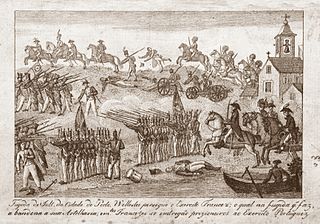
The Anglo-Portuguese Army was the combined British and Portuguese army that participated in the Peninsular War, under the command of Arthur Wellesley. The Army is also referred to as the British-Portuguese Army and, in Portuguese, as the Exército Anglo-Luso or the Exército Anglo-Português.
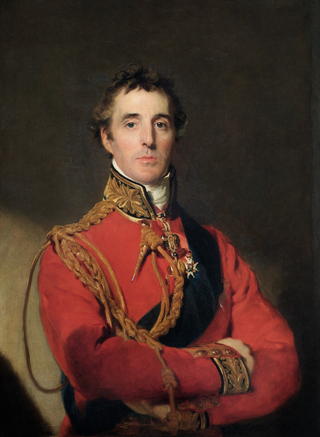
Arthur Wellesley, 1st Duke of Wellington, was an Anglo-Irish soldier and Tory statesman who was one of the leading military and political figures of 19th-century Britain, serving twice as prime minister of the United Kingdom. He is among the commanders who won and ended the Napoleonic Wars when the coalition defeated Napoleon at the Battle of Waterloo in 1815.
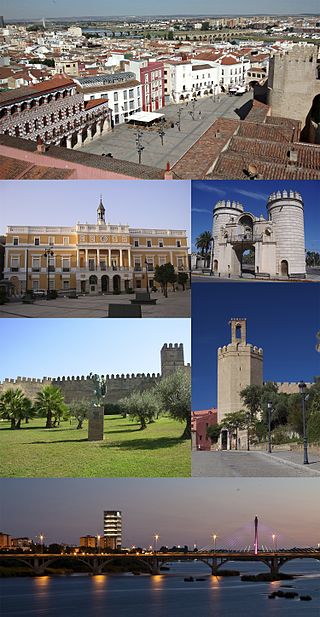
Badajoz is the capital of the Province of Badajoz in the autonomous community of Extremadura, Spain. It is situated close to the Portuguese border, on the left bank of the river Guadiana. The population in 2011 was 151,565.
British forces under the command of the Duke of Wellington assault the fortress of Badajoz. This would be the turning point in the Peninsular War against Napoleon-led France.

Arthur Wellesley, 1st Duke of Wellington, was an Anglo-Irish soldier and Tory statesman who was one of the leading military and political figures of 19th-century Britain, serving twice as prime minister of the United Kingdom. He is among the commanders who won and ended the Napoleonic Wars when the coalition defeated Napoleon at the Battle of Waterloo in 1815.

In the siege of Badajoz, also called the third siege of Badajoz, an Anglo-Portuguese Army under the Earl of Wellington besieged Badajoz, Spain, and forced the surrender of the French garrison. The siege was one of the bloodiest in the Napoleonic Wars and was considered a costly victory by the British, with some 4,800 Allied soldiers killed or wounded in a few short hours of intense fighting during the storming of the breaches as the siege drew to an end. Enraged at the huge number of casualties they suffered in seizing the city, the troops broke into houses and stores consuming vast quantities of alcohol with many of them then going on a rampage, threatening their officers and ignoring their commands to desist, and even killing several. It took three days before the men were brought back into order. When order was restored, an estimated 200-300 civilians had been killed or injured.

The Peninsular War (1807–1814) was the military conflict fought in the Iberian Peninsula by Spain, Portugal, and the United Kingdom against the invading and occupying forces of the First French Empire during the Napoleonic Wars. In Spain, it is considered to overlap with the Spanish War of Independence. The war started when the French and Spanish armies invaded and occupied Portugal in 1807 by transiting through Spain, and it escalated in 1808 after Napoleonic France occupied Spain, which had been its ally. Napoleon Bonaparte forced the abdications of Ferdinand VII and his father Charles IV and then installed his brother Joseph Bonaparte on the Spanish throne and promulgated the Bayonne Constitution. Most Spaniards rejected French rule and fought a bloody war to oust them. The war on the peninsula lasted until the Sixth Coalition defeated Napoleon in 1814, and is regarded as one of the first wars of national liberation. It is also significant for the emergence of large-scale guerrilla warfare.

Napoleon Bonaparte, later known by his regnal name Napoleon I, was a French military commander and political leader who rose to prominence during the French Revolution and led successful campaigns during the Revolutionary Wars. He was the de facto leader of the French Republic as First Consul from 1799 to 1804, then Emperor of the French from 1804 until 1814 and again in 1815. Napoleon's political and cultural legacy endures to this day, as a highly celebrated and controversial leader. He initiated many liberal reforms that have persisted in society, and is considered one of the greatest military commanders in history, but between three and six million civilians and soldiers perished in what became known as the Napoleonic Wars.
John Jacob Astor founded the American Fur Company, the profits from which made him the first multi-millionaire in the United States.

John Jacob Astor was a German-American businessman, merchant, real estate mogul, and investor who made his fortune mainly in a fur trade monopoly, by smuggling opium into China, and by investing in real estate in or around New York City. He was the first prominent member of the Astor family and the first multi-millionaire in the United States.

The American Fur Company (AFC) was founded in 1808, by John Jacob Astor, a German immigrant to the United States. During the 18th century, furs had become a major commodity in Europe, and North America became a major supplier. Several British companies, most notably the North West Company and the Hudson's Bay Company, were eventual competitors against Astor and capitalized on the lucrative trade in furs. Astor capitalized on anti-British sentiments and his commercial strategies to become one of the first trusts in American business and a major competitor to the British commercial dominance in North American fur trade. Expanding into many former British fur-trapping regions and trade routes, the company grew to monopolize the fur trade in the United States by 1830, and became one of the largest and wealthiest businesses in the country.
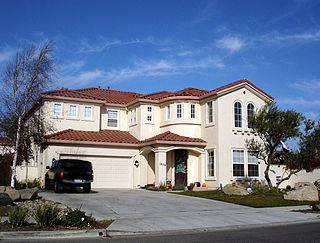
A millionaire(s) [in USA] or Crorer(s) [in international] is an individual whose net worth or wealth is equal to or exceeds one million units of currency. Depending on the currency, a certain level of prestige is associated with being a millionaire. In countries that use the short scale number naming system, a billionaire is someone who has at least a thousand times a million dollars, euros or the currency of the given country.
John Jacob Astor incorporates the American Fur Company, that would eventually make him America's first millionaire.

John Jacob Astor was a German-American businessman, merchant, real estate mogul, and investor who made his fortune mainly in a fur trade monopoly, by smuggling opium into China, and by investing in real estate in or around New York City. He was the first prominent member of the Astor family and the first multi-millionaire in the United States.

The American Fur Company (AFC) was founded in 1808, by John Jacob Astor, a German immigrant to the United States. During the 18th century, furs had become a major commodity in Europe, and North America became a major supplier. Several British companies, most notably the North West Company and the Hudson's Bay Company, were eventual competitors against Astor and capitalized on the lucrative trade in furs. Astor capitalized on anti-British sentiments and his commercial strategies to become one of the first trusts in American business and a major competitor to the British commercial dominance in North American fur trade. Expanding into many former British fur-trapping regions and trade routes, the company grew to monopolize the fur trade in the United States by 1830, and became one of the largest and wealthiest businesses in the country.
The Treaty of Constantinople establishes the Septinsular Republic, the first autonomous Greek state since the Fall of the Byzantine Empire. (Under the Old Style calendar then still in use in the Ottoman Empire, the treaty was signed on 21 March.)
The Treaty of Constantinople of 2 April [O.S. 21 March] 1800 was concluded between the Ottoman Empire and the Russian Empire, and heralded the creation of the Septinsular Republic, the first autonomous Greek state since the Fall of the Byzantine Empire.
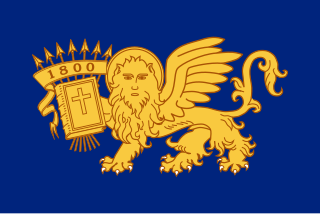
The Septinsular Republic was an oligarchic republic that existed from 1800 to 1807 under nominal Russian and Ottoman sovereignty in the Ionian Islands.

The Fall of Constantinople, also known as the Conquest of Constantinople, was the capture of the capital of the Byzantine Empire by the Ottoman Empire. The city fell on 29 May 1453 as part of the culmination of a 53-day siege which had begun on 6 April. The city's collapse marked the end of the Middle Ages.
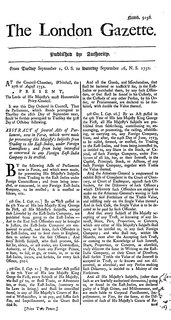
Old Style (O.S.) and New Style (N.S.) indicate dating systems before and after a calendar change, respectively. Usually, this is the change from the Julian calendar to the Gregorian calendar as enacted in various European countries between 1582 and 1923.
During the French Revolution, the Committee of Public Safety becomes the executive organ of the republic.

The French Revolution was a period of radical political and societal change in France that began with the Estates General of 1789 and ended with the formation of the French Consulate in November 1799. Many of its ideas are considered fundamental principles of liberal democracy, while phrases like liberté, égalité, fraternité reappeared in other revolts, such as the 1917 Russian Revolution, and inspired campaigns for the abolition of slavery and universal suffrage. The values and institutions it created dominate French politics to this day.

The Committee of Public Safety formed the provisional government and war cabinet during the Reign of Terror, a violent phase of the French Revolution. Supplementing the Committee of General Defence created after the execution of King Louis XVI in January 1793, the Committee of Public Safety was created in April 1793 by the National Convention. It was charged with protecting the new republic against its foreign and domestic enemies, fighting the First Coalition and the Vendée revolt. As a wartime measure, the committee was given broad supervisory and administrative powers over the armed forces, judiciary and legislature, as well as the executive bodies and ministers of the Convention.
King Buddha Yodfa Chulaloke (Rama I) of Siam (modern day Thailand) establishes the Chakri dynasty.

Phra Phutthayotfa Chulalok Maharaj, personal name Thongduang (ทองด้วง), also known as Rama I, was the founder of the Rattanakosin Kingdom and the first monarch of the reigning Chakri dynasty of Siam. His full title in Thai is Phra Bat Somdet Phra Paramoruracha Mahachakkriborommanat Phra Phutthayotfa Chulalok. He ascended the throne in 1782, following the deposition of King Taksin of Thonburi. He was also celebrated as the founder of Rattanakosin as the new capital of the reunited kingdom.
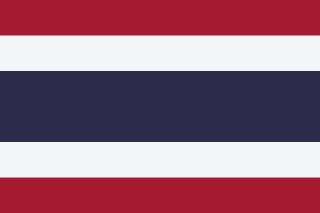
Thailand, historically known as Siam and officially the Kingdom of Thailand, is a country in Southeast Asia, located at the centre of the Indochinese Peninsula, spanning 513,120 square kilometres (198,120 sq mi), with a population of almost 70 million. The country is bordered to the north by Myanmar and Laos, to the east by Laos and Cambodia, to the south by the Gulf of Thailand and Malaysia, and to the west by the Andaman Sea and the extremity of Myanmar. Thailand also shares maritime borders with Vietnam to the southeast, and Indonesia and India to the southwest. Bangkok is the nation's capital and largest city.
American Revolutionary War: Ships of the Continental Navy unsuccessfully attempted to capture HMS Glasgow near Block Island.

The American Revolutionary War, also known as the Revolutionary War or American War of Independence, secured American independence from Great Britain. Fighting began on April 19, 1775, followed by the Lee Resolution on July 2, 1776, and the Declaration of Independence on July 4, 1776. The American Patriots were supported by the Kingdom of France and, to a lesser extent, the Dutch Republic and the Spanish Empire, in a conflict taking place in North America, the Caribbean, and the Atlantic Ocean.
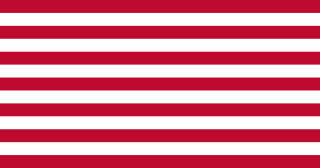
The Continental Navy was the navy of the United States during the American Revolutionary War and was founded October 13, 1775. The fleet cumulatively became relatively substantial through the efforts of the Continental Navy's patron John Adams and vigorous Congressional support in the face of stiff opposition, when considering the limitations imposed upon the Patriot supply pool.
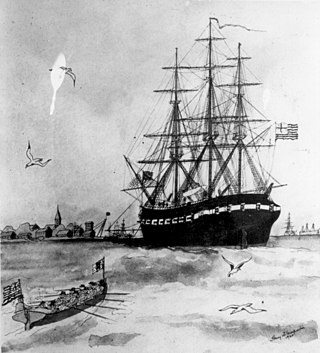
The Battle of Block Island was a naval skirmish which took place in the waters off Rhode Island during the American Revolutionary War. The Continental Navy under the command of Commodore Esek Hopkins was returning from a successful raid on Nassau when it encountered HMS Glasgow, a Royal Navy dispatch boat.
HMS Glasgow was a 20-gun sixth-rate post ship of the Royal Navy. She was launched in 1757 and took part in the American Revolutionary War. While under command of Capt. William Maltby she ran onto rocks at Cohasset, Massachusetts on 10 December, 1774. Refloated and arrived in Boston on the 15th for repairs. Capt. Maltby was relieved of command at a Court Martial and replaced by Tyringham Howe some time between 8-15 January, 1775. She is most famous for her encounter with the maiden voyage of the Continental Navy off Block Island on 6 April 1776. In that action, Glasgow engaged a squadron of 6 ships of the Continental Navy, managing to escape intact. She captured a prize in April, 1778, but it sprang a leak and sank.

Block Island is an island in the U.S. state of Rhode Island located in Block Island Sound approximately 9 miles (14 km) south of the mainland and 14 miles (23 km) east of Montauk Point, Long Island, New York, named after Dutch explorer Adriaen Block. It is part of Washington County and shares the same area as the town of New Shoreham. The Nature Conservancy added Block Island to its list of "The Last Great Places" which consists of 12 sites in the western hemisphere, and about 40 percent of the island is set aside for conservation. It is part of the Outer Lands region, a coastal archipelago.
American Revolutionary War: Ships of the Continental Navy fail in their attempt to capture a Royal Navy dispatch boat.

The American Revolutionary War, also known as the Revolutionary War or American War of Independence, secured American independence from Great Britain. Fighting began on April 19, 1775, followed by the Lee Resolution on July 2, 1776, and the Declaration of Independence on July 4, 1776. The American Patriots were supported by the Kingdom of France and, to a lesser extent, the Dutch Republic and the Spanish Empire, in a conflict taking place in North America, the Caribbean, and the Atlantic Ocean.

The Continental Navy was the navy of the United States during the American Revolutionary War and was founded October 13, 1775. The fleet cumulatively became relatively substantial through the efforts of the Continental Navy's patron John Adams and vigorous Congressional support in the face of stiff opposition, when considering the limitations imposed upon the Patriot supply pool.

The Battle of Block Island was a naval skirmish which took place in the waters off Rhode Island during the American Revolutionary War. The Continental Navy under the command of Commodore Esek Hopkins was returning from a successful raid on Nassau when it encountered HMS Glasgow, a Royal Navy dispatch boat.

The Royal Navy (RN) is the United Kingdom's naval warfare force. Although warships were used by English and Scottish kings from the early medieval period, the first major maritime engagements were fought in the Hundred Years' War against France. The modern Royal Navy traces its origins to the early 16th century; the oldest of the UK's armed services, it is consequently known as the Senior Service.
Dispatch boats were small boats, and sometimes large ships, tasked to carry military dispatches from ship to ship or from ship to shore or, in some cases from shore to shore. Dispatch boats were employed when other means of transmitting a message was not possible or safe or as quick.
A group of 23 slaves in New York City revolted, setting fire to a building, but were soon recaptured.
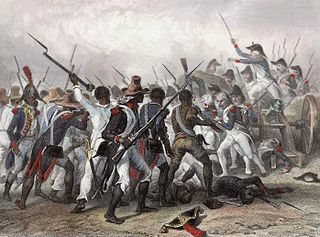
The New York Slave Revolt of 1712 was an uprising in New York City, in the Province of New York, of 23 Black slaves. They killed nine whites and injured another six before they were stopped. More than 70 black people were arrested and jailed. Of these, 27 were put on trial, and 21 convicted and executed.
The New York Slave Revolt of 1712 begins near Broadway.

The New York Slave Revolt of 1712 was an uprising in New York City, in the Province of New York, of 23 Black slaves. They killed nine whites and injured another six before they were stopped. More than 70 black people were arrested and jailed. Of these, 27 were put on trial, and 21 convicted and executed.

Broadway is a road in the U.S. state of New York. Broadway runs from State Street at Bowling Green for 13 mi (21 km) through the borough of Manhattan and 2 mi (3.2 km) through the Bronx, exiting north from New York City to run an additional 18 mi (29 km) through the Westchester County municipalities of Yonkers, Hastings-On-Hudson, Dobbs Ferry, Irvington, and Tarrytown, and terminating north of Sleepy Hollow.
At the Cape of Good Hope, Dutch sailor Jan van Riebeeck establishes a resupply camp that eventually becomes Cape Town.
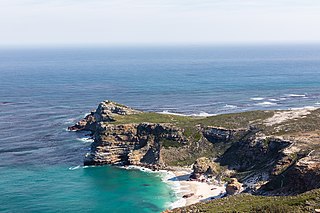
The Cape of Good Hope is a rocky headland on the Atlantic coast of the Cape Peninsula in South Africa.

Johan Anthoniszoon "Jan" van Riebeeck was a Dutch navigator and colonial administrator of the Dutch East India Company.

Cape Town is one of South Africa's three capital cities, serving as the seat of the Parliament of South Africa. It is the legislative capital of the country, the oldest city in the country, and the second largest. Colloquially named the Mother City, it is the largest city of the Western Cape province, and is managed by the City of Cape Town metropolitan municipality. The other two capitals are Pretoria, the executive capital, located in Gauteng, where the Presidency is based, and Bloemfontein, the judicial capital in the Free State, where the Supreme Court of Appeal is located.
One of the largest earthquakes recorded in the history of England, Flanders, or Northern France, takes place.
Though severe earthquakes in the north of France and Britain are rare, the 1580 Dover Straits earthquake appears to have been one of the largest in the recorded history of England, Flanders or northern France. Its effects started to be felt in London at around six o'clock in the evening of 6 April 1580, being Wednesday in the Easter week.
Mehmed II begins his siege of Constantinople. The city falls on May 29, and is renamed Istanbul.

Mehmed II, commonly known as Mehmed the Conqueror, was an Ottoman sultan who ruled from August 1444 to September 1446, and then later from February 1451 to May 1481. In Mehmed II's first reign, he defeated the crusade led by John Hunyadi after the Hungarian incursions into his country broke the conditions of the truce Peace of Szeged. When Mehmed II ascended the throne again in 1451, he strengthened the Ottoman navy and made preparations to attack Constantinople. At the age of 21, he conquered Constantinople and brought an end to the Byzantine Empire.

Constantinople was the capital of the Roman Empire, and later, the Eastern Roman Empire, the Latin Empire (1204–1261), and the Ottoman Empire (1453–1922). Following the Turkish War of Independence, the Turkish capital then moved to Ankara. Officially renamed Istanbul in 1930, the city is today the largest city and financial centre of the Republic of Turkey (1923–present). It is also the largest city in Europe.

Istanbul, formerly known as Constantinople, is the largest city in Turkey, serving as the country's economic, cultural and historic hub. The city straddles the Bosporus strait, lying in both Europe and Asia, and has a population of over 15 million residents, comprising 19% of the population of Turkey. Istanbul is the most populous European city, and the world's 15th-largest city.
The Scots reaffirm their independence by signing the Declaration of Arbroath.

The Declaration of Arbroath is the name usually given to a letter, dated 6 April 1320 at Arbroath, written by Scottish barons and addressed to Pope John XXII. It constituted King Robert I's response to his excommunication for disobeying the pope's demand in 1317 for a truce in the First War of Scottish Independence. The letter asserted the antiquity of the independence of the Kingdom of Scotland, denouncing English attempts to subjugate it.
Seventh Crusade: Egyptian Ayyubid forces defeated the Crusader army at the Battle of Fariskur in Egypt, capturing King Louis IX of France as a hostage.

The Seventh Crusade (1248–1254) was the first of the two Crusades led by Louis IX of France. Also known as the Crusade of Louis IX to the Holy Land, it aimed to reclaim the Holy Land by attacking Egypt, the main seat of Muslim power in the Near East. The Crusade initially met with success but ended in defeat, with most of the army – including the king – captured by the Muslims.

The Ayyubid dynasty was the founding dynasty of the medieval Sultanate of Egypt established by Saladin in 1171, following his abolition of the Fatimid Caliphate of Egypt. A Sunni Muslim of Kurdish origin, Saladin had originally served Nur ad-Din of Syria, leading Nur ad-Din's army in battle against the Crusaders in Fatimid Egypt, where he was made Vizier. Following Nur ad-Din's death, Saladin was proclaimed as the first Sultan of Egypt, and rapidly expanded the new sultanate beyond the frontiers of Egypt to encompass most of the Levant, in addition to Hijaz, Yemen, northern Nubia, Tarabulus, Cyrenaica, southern Anatolia, and northern Iraq, the homeland of his Kurdish family. By virtue of his sultanate including Hijaz, the location of the Islamic holy cities of Mecca and Medina, he was the first ruler to be hailed as the Custodian of the Two Holy Mosques, a title that would be held by all subsequent Sultans of Egypt until the Ottoman conquest of 1517. Saladin's military campaigns in the first decade of his rule, aimed at uniting the various Arab and Muslim states in the region against the Crusaders, set the general borders and sphere of influence of the Sultanate of Egypt for the almost three and a half centuries of its existence. Most of the Crusader states, including the Kingdom of Jerusalem, fell to Saladin after his victory at the Battle of Hattin in 1187. However, the Crusaders reconquered the coast of Palestine in the 1190s.
The Crusades were a series of religious wars initiated, supported, and sometimes directed by the Latin Church in the medieval period. The best known of these Crusades are those to the Holy Land in the period between 1095 and 1291 that were intended to recover Jerusalem and its surrounding area from Islamic rule. Beginning with the First Crusade, which resulted in the recovery of Jerusalem in 1099, dozens of Crusades were fought, providing a focal point of European history for centuries.
Battle of Fariskur may refer to:Battle of Fariskur (1219), during the Fifth Crusade Battle of Fariskur (1250), during the Seventh Crusade, whereat Louis IX of France was captured
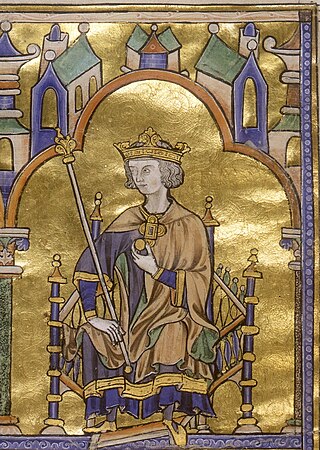
Louis IX, commonly known as Saint Louis or Louis the Saint, was King of France from 1226 to 1270, and the most illustrious of the Direct Capetians. He was crowned in Reims at the age of 12, following the death of his father Louis VIII. His mother, Blanche of Castile, ruled the kingdom as regent until he reached maturity, and then remained his valued adviser until her death. During Louis' childhood, Blanche dealt with the opposition of rebellious vassals and secured Capetian success in the Albigensian Crusade, which had started 20 years earlier.
Stilicho defeats the Visigoths under Alaric in the Battle of Pollentia.
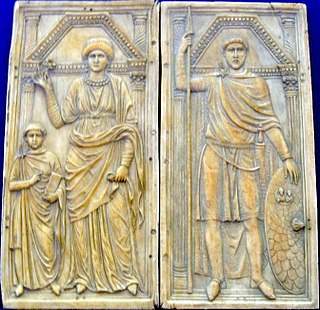
Flavius Stilicho was a military commander in the Roman army who, for a time, became the most powerful man in the Western Roman Empire. He was of Vandal origins and married to Serena, the niece of emperor Theodosius I. He became guardian for the underage Honorius. After nine years of struggle against barbarian and Roman enemies, political and military disasters finally allowed his enemies in the court of Honorius to remove him from power. His fall culminated in his arrest and execution in 408.

The Visigoths were an early Germanic people who, along with the Ostrogoths, constituted the two major political entities of the Goths within the Roman Empire in late antiquity, or what is known as the Migration Period. The Visigoths emerged from earlier Gothic groups, including a large group of Thervingi, who had moved into the Roman Empire beginning in 376 and had played a major role in defeating the Romans at the Battle of Adrianople in 378. Relations between the Romans and the Visigoths varied, with the two groups making treaties when convenient, and warring with one another when not. Under their first leader, Alaric I, the Visigoths invaded Italy and sacked Rome in August 410. Afterwards, they began settling down, first in southern Gaul and eventually in Hispania, where they founded the Visigothic Kingdom and maintained a presence from the 5th to the 8th centuries AD.
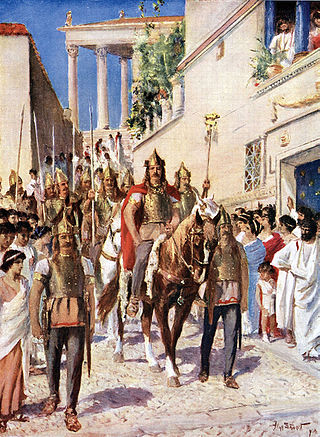
Alaric I was the first king of the Visigoths, from 395 to 410. He rose to leadership of the Goths who came to occupy Moesia—territory acquired a couple of decades earlier by a combined force of Goths and Alans after the Battle of Adrianople.
The Battle of Pollentia was fought on 6 April 402 (Easter) between the Romans under Stilicho and the Visigoths under Alaric I, during the first Gothic invasion of Italy (401–403). The Romans were victorious, and forced Alaric to retreat, though he rallied to fight again in the next year in the Battle of Verona, where he was again defeated. After this, Alaric retreated from Italy, leaving the province in peace until his second invasion in 409, after Stilicho's death.
Julius Caesar defeats Caecilius Metellus Scipio and Marcus Porcius Cato (Cato the Younger) at the Battle of Thapsus.
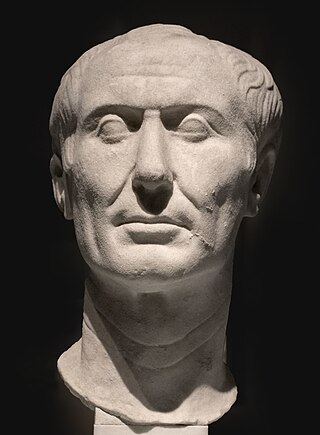
Gaius Julius Caesar, was a Roman general and statesman. A member of the First Triumvirate, Caesar led the Roman armies in the Gallic Wars before defeating his political rival Pompey in a civil war, and subsequently became dictator from 49 BC until his assassination in 44 BC. He played a critical role in the events that led to the demise of the Roman Republic and the rise of the Roman Empire.

Quintus Caecilius Metellus Pius Scipio, often referred to as Metellus Scipio, was a Roman senator and military commander. During the civil war between Julius Caesar and the senatorial faction led by Pompey, he was a staunch supporter of the latter. He led troops against Caesar's forces, mainly in the battles of Pharsalus and Thapsus, where he was defeated. He later committed suicide. Ronald Syme called him "the last Scipio of any consequence in Roman history."

Marcus Porcius Cato "Uticensis", also known as Cato the Younger, was an influential conservative Roman senator during the late Republic. His conservative principles were focused on the preservation of what he saw as old Roman values in decline. A noted orator and a follower of Stoicism, his scrupulous honesty and professed respect for tradition gave him a powerful political following which he mobilised against powerful generals of his day.

The Battle of Thapsus was a military engagement that took place on April 6, 46 BC near Thapsus. The forces of the Optimates, led by Quintus Caecilius Metellus Scipio, were defeated by the forces of Julius Caesar. It was followed shortly by the suicides of Scipio and his ally, Cato the Younger, Numidian King Juba, his Roman peer Marcus Petreius, and the surrender of Cicero and others who accepted Caesar's pardon.
Vladimir Zhirinovsky, Russian and Soviet politician (b. 1946) deaths

Vladimir Volfovich Zhirinovsky was a Russian ultranationalist politician and the leader of the populist Liberal Democratic Party of Russia (LDPR) from its creation in 1992 until his death. He had been a member of the State Duma since 1993 and leader of the LDPR group in the State Duma from 1993 to 2000, and from 2011 to 2022.
Jill Knight, British politician (b. 1923) deaths
Joan Christabel Jill Knight, Baroness Knight of Collingtree, was a British politician. A member of the Conservative Party, she served as Member of Parliament (MP) for Birmingham Edgbaston from 1966 to 1997. She was created a life peer as "Baroness Knight of Collingtree, of Collingtree in the County of Northamptonshire" in 1997 after she had stood down at that year's general election, and retired from the House of Lords on 24 March 2016.
Hans Küng, Swiss Catholic priest, theologian, and author (b. 1928) deaths

Hans Küng was a Swiss Catholic priest, theologian, and author. From 1995 he was president of the Foundation for a Global Ethic.
Michael O'Donnell, British physician, journalist, author and broadcaster (b. 1928) deaths
Michael O'Donnell was a British physician, journalist, author and broadcaster.
Don Rickles, American actor and comedian (b. 1926) deaths

Donald Jay Rickles was an American stand-up comedian and actor. He became known primarily for his insult comedy. His film roles include Run Silent, Run Deep (1958) with Clark Gable, Carl Reiner's Enter Laughing (1967), the Clint Eastwood–led Kelly's Heroes (1970), and Martin Scorsese's Casino (1995) with Robert De Niro. From 1976 to 1978, Rickles had a two-season starring role in the NBC television sitcom C.P.O. Sharkey, having previously starred in two eponymous half-hour programs, an ABC variety show titled The Don Rickles Show (1968) and a CBS sitcom identically titled The Don Rickles Show (1972).
Merle Haggard, American singer-songwriter and guitarist (b. 1937) deaths
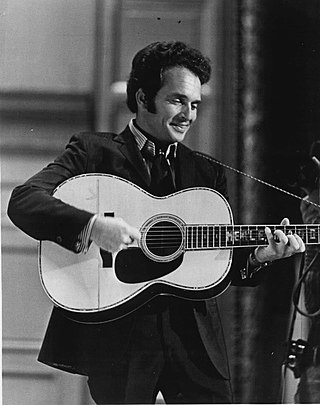
Merle Ronald Haggard was an American country music singer, songwriter, guitarist, and fiddler.
Giovanni Berlinguer, Italian lawyer and politician (b. 1924) deaths
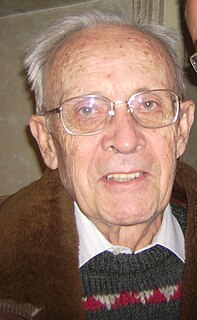
Giovanni Berlinguer was an Italian politician, humanist and professor of social medicine.
James Best, American actor, director, and screenwriter (b. 1926) deaths

Jewel Franklin Guy, known professionally as James Best, was an American television, film, stage, and voice actor, as well as a writer, director, acting coach, artist, college professor, and musician. During a career that spanned more than 60 years, he performed not only in feature films but also in scores of television series, as well as appearing on various country music programs and talk shows. Television audiences, however, perhaps most closely associate Best with his role as the bumbling Sheriff Rosco P. Coltrane in the action-comedy series The Dukes of Hazzard, which originally aired on CBS between 1979 and 1985. He reprised the role in 1997 and 2000 for the made-for-television movies The Dukes of Hazzard: Reunion! and The Dukes of Hazzard: Hazzard in Hollywood (2000).
Ray Charles, American singer-songwriter and conductor (b. 1918) deaths

Ray Charles was an American musician, singer, songwriter, vocal arranger and conductor who was best known as organizer and leader of the Ray Charles Singers who were featured on Perry Como's records and television shows for 35 years and were also known for a series of 30 choral record albums produced in the 1950s and 1960s for the Essex, MGM, Decca and Command labels.
Dollard St. Laurent, Canadian ice hockey player (b. 1929) deaths

Joseph Dollard Herve St. Laurent was a Canadian ice hockey defenceman.
Mary Anderson, American actress (b. 1918) deaths
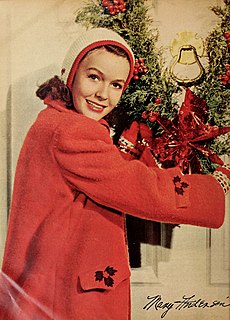
Mary Bebe Anderson was an American actress, who appeared in 31 films and 22 television productions between 1939 and 1965. She was best known for her small supporting role in the film Gone With the Wind as well as one of the main characters in Alfred Hitchcock's 1944 film Lifeboat.
Jacques Castérède, French pianist and composer (b. 1926) deaths
Jacques Castérède was a French composer and pianist.
Liv Dommersnes, Norwegian actress (b. 1922) deaths

Liv Dommersnes was a Norwegian actress and reciter of poetry. She was a member of group that founded Studioteatret in 1945.
Mickey Rooney, American soldier, actor, and dancer (b. 1920) deaths

Joseph Yule Jr., also known as Mickey Rooney and Mickey Maguire; was an American actor. In a career spanning nine decades, he appeared in more than 300 films and was among the last surviving stars of the silent-film era. He was the top box-office attraction from 1939 to 1941, and one of the best-paid actors of that era. At the height of a career marked by declines and comebacks, Rooney performed the role of Andy Hardy in a series of 16 films in the 1930s and 1940s that epitomized mainstream America's self-image.
Chuck Stone, American soldier, journalist, and academic (b. 1924) deaths
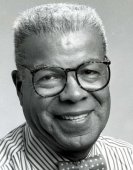
Charles Sumner "Chuck" Stone, Jr. was an American pilot, newspaper editor, journalism professor, and author. He was a member of the Tuskegee Airmen during World War II and was the first president of the National Association of Black Journalists, serving from 1975 to 1977. Passionate about racial issues and supportive of many liberal causes, he refused to follow any party line, "but called the issues as he saw them."
Massimo Tamburini, Italian motorcycle designer, co-founded Bimota (b. 1943) deaths
Massimo Tamburini was an Italian motorcycle designer for Cagiva, Ducati, and MV Agusta, and one of the founders of Bimota. Tamburini's designs are iconic in their field, with one critic calling him the "Michelangelo of motorbike design". His Ducati 916 and MV Agusta F4 were included in the Guggenheim Museum's The Art of the Motorcycle exhibit of 1998–1999.

Bimota is an Italian manufacturer of custom and production motorcycles. It was founded in 1973 in Rimini by Valerio Bianchi, Giuseppe Morri, and Massimo Tamburini. The company name is a portmanteau derived from the first two letters of each of the three founders' surnames: Bianchi, Morri, and Tamburini.
Hilda Bynoe, Grenadian physician and politician, 2nd Governor of Grenada (b. 1921) deaths
Dame Hilda Louisa Bynoe, DBE was the Governor of Grenada between 1967 and 1972.
This is a list of Viceroys of Grenada from the establishment of French rule in 1649 until its independence from the United Kingdom in 1974. Following independence, the viceroy of Grenada ceased to represent the British monarch and British government, and ceased to be a British person, instead the new vice regal office, renamed to Governor-General of Grenada represented the Monarch of Grenada, and the person holding the office must be a Grenadian citizen.
Bill Guttridge, English footballer and manager (b. 1931) deaths
William Henry Guttridge was an English professional football player and manager.
Bigas Luna, Spanish director and screenwriter (b. 1946) deaths

José Juan Bigas Luna was a Spanish film director, designer and artist. His films are typically characterised by a strong emphasis on the erotic, often related to food, something for which he admitted a strong passion. His work often explores and parodies clichés of Spanish identity, but he had an international career and has made films in Spanish, Catalan, Italian, French and English.
Ottmar Schreiner, German lawyer and politician (b. 1946) deaths

Ottmar Schreiner was a German lawyer and left-wing politician. He was known as one of the leading leftists in his party, SPD.
Roland Guilbault, American admiral (b. 1934) deaths
Roland George "Gil" Guilbault was an American U.S. Navy rear admiral who commanded the USS Ticonderoga, the first Aegis cruiser. In 1987, he served as a battle force commander aboard the USS Eisenhower. He retired as a rear admiral in 1994.
Thomas Kinkade, American painter and illustrator (b. 1958) deaths

William Thomas Kinkade III was an American painter of popular realistic, pastoral, and idyllic subjects. He is notable for achieving success during his lifetime with the mass marketing of his work as printed reproductions and other licensed products by means of the Thomas Kinkade Company. According to Kinkade's company, one in every twenty American homes owned a copy of one of his paintings.
Fang Lizhi, Chinese astrophysicist and academic (b. 1936) deaths

Fang Lizhi was a Chinese astrophysicist, vice-president of the University of Science and Technology of China, and activist whose liberal ideas inspired the pro-democracy student movement of 1986–87 and, finally, the Tiananmen Square protests of 1989. Because of his activism, he was expelled from the Chinese Communist Party in January 1987. For his work, Fang was a recipient of the Robert F Kennedy Human Rights Award in 1989, given each year to an individual whose courageous activism is at the heart of the human rights movement and in the spirit of Robert F. Kennedy's vision and legacy. He was elected an academician of the Chinese Academy of Sciences in 1980, but it was revoked after 1989.
Sheila Scotter, Australian fashion designer and journalist (b. 1920) deaths
Sheila Winifred Gordon Scotter, AM, MBE was an Australian businesswoman. She was a fashion designer and third editor of the Vogue Australia magazine. She also founded the Vogue Living magazine. She was famous for always wearing black and white clothing and leaving her hair silver. This earned her the nickname, the Silver Duchess. She was honoured for her journalism and her fundraising for opera.
Reed Whittemore, American poet and critic (b. 1919) deaths
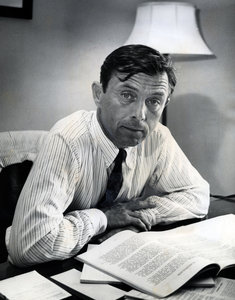
Edward Reed Whittemore, Jr. was an American poet, biographer, critic, literary journalist and college professor. He was appointed the sixteenth and later the twenty-eighth Poet Laureate Consultant in Poetry to the Library of Congress in 1964, and in 1984.
Gerald Finnerman, American director and cinematographer (b. 1931) deaths
Gerald Perry Finnerman was an American cinematographer who worked on TV series such as Moonlighting and the original Star Trek. He served as vice president of the American Society of Cinematographers, and won a Primetime Emmy Award for Outstanding Cinematography in Entertainment Programming for a Special.
Wilma Mankiller, American tribal leader (b. 1945) deaths
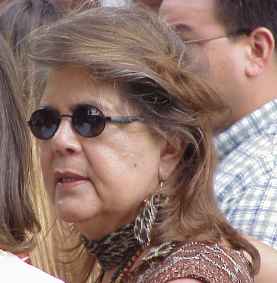
Wilma Pearl Mankiller was a Native American activist, social worker, community developer and the first woman elected to serve as Principal Chief of the Cherokee Nation. Born in Tahlequah, Oklahoma, she lived on her family's allotment in Adair County, Oklahoma, until the age of 11, when her family relocated to San Francisco as part of a federal government program to urbanize Native Americans. After high school, she married a well-to-do Ecuadorian and raised two daughters. Inspired by the social and political movements of the 1960s, Mankiller became involved in the Occupation of Alcatraz and later participated in the land and compensation struggles with the Pit River Tribe. For five years in the early 1970s, she was employed as a social worker, focusing mainly on children's issues.
Corin Redgrave, English actor (b. 1939) deaths

Corin William Redgrave was an English actor and left-wing socialist activist.
Shaylee Mansfield, deaf American actress and YouTuber births

Shaylee Mansfield is an American actress and former YouTuber who is deaf. Mansfield was born in Burbank, California, and first gained recognition by making viral videos in which she tells Christmas stories in American Sign Language. Mansfield appeared in an "Unforgettable Stories" video advertisement by Disney Parks, in which she met Minnie Mouse, who was learning sign language at Walt Disney World. The video quickly went viral and became one of Disney's most-watched advertisements.
Valentina Tronel, French child singer, winner of the Junior Eurovision Song Contest 2020 births

Valentina Tronel, better known as simply Valentina, is a French child singer and voice actress best known for winning the Junior Eurovision Song Contest 2020. In 2016, she took part in the French version of The Voice Kids. Since 2018, she has been part of the child musical group Kids United Nouvelle Génération, with whom she has recorded the albums Au bout de nos rêves (2018) and L'Hymne de la vie (2019). She represented France in the Junior Eurovision Song Contest 2020 with the song "J'imagine", and went on to win the competition, becoming the first French entrant to win the Junior Eurovision Song Contest.

The Junior Eurovision Song Contest 2020 was the 18th edition of the annual Junior Eurovision Song Contest, organised by Telewizja Polska (TVP) and the European Broadcasting Union (EBU). The contest took place on 29 November 2020, and was held in Warsaw, Poland, following the country's victory at the 2019 contest with the song "Superhero" by Viki Gabor. This was the first time the contest was held in the same country for two consecutive years.
J. M. S. Careless, Canadian historian and academic (b. 1919) deaths
James Maurice Stockford Careless was a Canadian historian.
Shawn Mackay, Australian rugby player and coach (b. 1982) deaths

Shawn Mackay was an Australian rugby union player with the Canberra based Brumbies in the Super 14 competition. He was the son of former Eastern Suburbs rugby league player John Mackay.
Luigi Comencini, Italian director and producer (b. 1916) deaths

Luigi Comencini was an Italian film director. Together with Dino Risi, Ettore Scola and Mario Monicelli, he was considered among the masters of the commedia all'italiana genre.
Maggie Dixon, American basketball player and coach (b. 1977) deaths

Margaret Mary Dixon was an American collegiate women's basketball coach.
Francis L. Kellogg, American soldier and diplomat (b. 1917) deaths
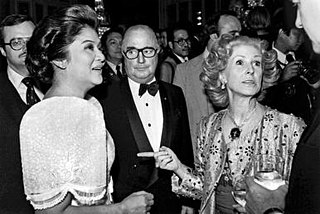
Francis Leonard Kellogg was an American diplomat, a special assistant to the Secretary of State during the Nixon and Ford Administrations and a prominent socialite in New York City.
Stefanos Stratigos, Greek actor and director (b. 1926) deaths
Stefanos Stratigos was a Greek actor in film and television.
Rainier III, Prince of Monaco (b. 1923) deaths
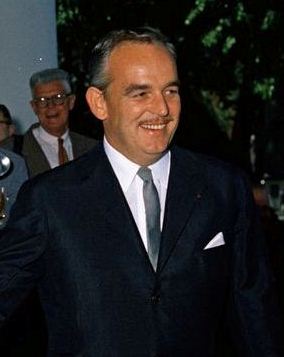
Rainier III was Prince of Monaco from 1949 to his death in 2005. Rainier ruled the Principality of Monaco for almost 56 years, making him one of the longest-ruling monarchs in European history.
Lou Berberet, American baseball player (b. 1929) deaths

Louis Joseph Berberet was an American catcher in Major League Baseball who played for the New York Yankees, Washington Senators, Boston Red Sox and Detroit Tigers between 1954 and 1960. He was born in Long Beach, California.
Larisa Bogoraz, Russian linguist and activist (b. 1929) deaths

Larisa Iosifovna Bogoraz was a dissident in the Soviet Union.
David Bloom, American journalist (b. 1963) deaths
David Jerome Bloom was an American television journalist until his sudden death in 2003 after a deep vein thrombosis (DVT) became a pulmonary embolism.
Anita Borg, American computer scientist and educator; founded Anita Borg Institute for Women and Technology (b. 1949) deaths

Anita Borg was an American computer scientist. She founded the Institute for Women and Technology and the Grace Hopper Celebration of Women in Computing.

AnitaB.org is a global nonprofit organization based in Belmont, California. Founded by computer scientists Anita Borg and Telle Whitney, the institute's primary aim is to recruit, retain, and advance women in technology.
Gerald Emmett Carter, Canadian cardinal (b. 1912) deaths

Gerald Emmett Cardinal Carter (1912–2003) was a Canadian prelate of the Roman Catholic Church. He served as Archbishop of Toronto from 1978 to 1990, and was elevated to the cardinalate in 1979.
Babatunde Olatunji, Nigerian drummer, educator, and activist (b. 1927) deaths

Michael Babatunde Olatunji was a Nigerian drummer, educator, social activist, and recording artist.
Dino Yannopoulos, Greek stage director of the Metropolitan Opera (b. 1919) deaths
Konstantinos "Dino" Yannopoulos was the principal stage director of the Metropolitan Opera between 1945 and 1977. One of his major works was a production of Giacomo Puccini's Tosca with Maria Callas on the title role. He was also the founder of the Athens Music Festival. Also active as an educator, he worked as director of the opera program at the Curtis Institute of Music during the 1970s and was director of the Academy of Vocal Arts in Philadelphia from 1977-1987 and artistic director of the AVA from 1987-1989. He earned degrees from the University of Vienna, the University of Leipzig, and the Mozarteum.
Leyre Romero Gormaz, Spanish tennis player births
Leyre Romero Gormaz is a Spanish tennis player.
Charles Pettigrew, American singer-songwriter (b. 1963) deaths

Charles & Eddie were an American soul music duo composed of Charles Pettigrew and Eddie Chacon. Their single "Would I Lie to You?", taken from their 1992 debut album, Duophonic, won Ivor Novello Awards in 1993 in the Best Contemporary Song, Best Selling Song and International Hit of the Year categories. Between 1992 and 1995 they hit the top 40 three more times in the UK.
Shaheen Afridi, Pakistani cricketer births
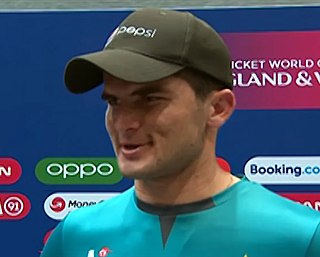
Shaheen Shah Afridi is a Pakistani professional cricketer who plays as a fast bowler for the Pakistan national cricket team. He made his international debut for Pakistan in April 2018 and his Test match debut for the national team in December 2018.
Habib Bourguiba, Tunisian politician, 1st President of Tunisia (b. 1903) deaths
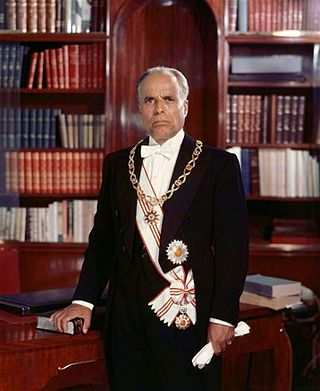
Habib Bourguiba was a Tunisian lawyer, nationalist leader and statesman who led the country from 1956 to 1957 as the prime minister of the Kingdom of Tunisia (1956–57) then as the first president of Tunisia (1957–87). Prior to his presidency, he led the nation to independence from France, ending the 75-year-old protectorate and earning the title of "Supreme Combatant".

The president of Tunisia, officially the president of the Tunisian Republic, is the head of state of Tunisia. Tunisia is a presidential republic, whereby the president is the head of state and head of government. Under Article 77 of the Constitution of Tunisia, the president is also the commander-in-chief of the Tunisian Armed Forces. The incumbent president is Kais Saied who has held this position since 23 October 2019 following the death of Beji Caid Essebsi on 25 July 2019. 2022 Tunisian constitutional referendum turned Tunisia into a presidential republic, giving the president sweeping powers while largely limiting the role of the parliament.
Red Norvo, American vibraphone player and composer (b. 1908) deaths

Red Norvo was an American musician, one of jazz's early vibraphonists, known as "Mr. Swing". He helped establish the xylophone, marimba, and vibraphone as jazz instruments. His recordings included "Dance of the Octopus", "Bughouse", "Knockin' on Wood", "Congo Blues", and "Hole in the Wall".
Peyton List, American actress and model births

Peyton Roi List is an American actress and model. List began her career as a child model, modeling for tween magazines and companies, before transitioning to child actress. She made her acting debut with the film 27 Dresses (2008), and soon became recognized for playing Holly Hills in the Diary of a Wimpy Kid film series (2011–2012).
Spencer List, American actor births

Spencer List is an American actor. List is best known from the Fox show Fringe where he played a mysterious mute child in the episode "Inner Child". He has played Carter in The Fosters and its spin-off Good Trouble. He has also been on Law & Order: Special Victims Unit in which he played Tate, the son of Leland Orser's character, Kevin Walker. List appeared in Jack Ketchum's Offspring in 2009. He made a guest appearance on the Disney Channel show Bunk'd in the episode "Luke's Back" as a Camp Champion camper named Eric.
Norbert Schmitz, German footballer (b. 1958) deaths
Norbert "Nobbi" Christian Schmitz was a German footballer who made a total of 89 2. Bundesliga appearances for Tennis Borussia Berlin and SC Fortuna Köln during his professional career.
Tammy Wynette, American singer-songwriter (b. 1942) deaths

Tammy Wynette was an American country music artist, as well as an actress and author. She is considered among the genre's most influential and successful artists. Wynette helped bring a woman's perspective to the male-dominated country music field that helped other women find representation in the genre. Her characteristic vocal delivery has been acclaimed by critics, journalists and writers for conveying unique emotion. Twenty of her singles topped the Billboard country chart during her career. Her signature song "Stand by Your Man" received both acclaim and criticism for its portrayal of women's loyalty towards their husbands.
Greer Garson, English-American actress (b. 1904) deaths

Eileen Evelyn Greer Garson was an English-American actress and singer. She was a major star at Metro-Goldwyn-Mayer who became popular during the Second World War for her portrayal of strong women on the homefront; listed by the Motion Picture Herald as one of America's top-ten box office draws from 1942 to 1946.
Darya Lebesheva, Belarusian tennis player births
Darya Vyacheslavovna Lebesheva is a Belarusian tennis player.
Ioannis Alevras, Greek banker and politician, President of Greece (b. 1912) deaths
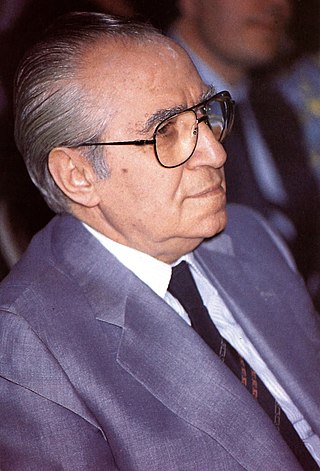
Ioannis Alevras, sometimes spelled Yannis Alevras, was a Greek Panhellenic Socialist Movement politician and Speaker of the Hellenic Parliament, who served as acting President of Greece in March 1985.

The president of Greece, officially the President of the Hellenic Republic, commonly referred to in Greek as the President of the Republic, is the head of state of Greece. The president is elected by the Hellenic Parliament; the role has been mainly ceremonial since the 1986 constitutional reform. The office was formally established by the Constitution of Greece in 1975, but has antecedents in the Second Hellenic Republic of 1924–1935 and the Greek junta in 1973–1974 which predated the transition to the current Third Hellenic Republic. The incumbent, since 13 March 2020, is Katerina Sakellaropoulou.
Adrián Alonso, Mexican actor births

Adrián Alonso Barona is a Mexican actor. As a child actor, he was best known for the movie The Legend of Zorro.
Juvénal Habyarimana, Rwandan banker and politician, 3rd President of Rwanda (b. 1937) deaths

Juvénal Habyarimana was a Rwandan politician and military officer who served as the second president of Rwanda, from 1973 until 1994. He was nicknamed Kinani, a Kinyarwanda word meaning "invincible".

This article lists the presidents of Rwanda since the creation of the office in 1961, to the present day.
Cyprien Ntaryamira, Burundian politician, 5th President of Burundi (b. 1955) deaths

Cyprien Ntaryamira was a Burundian politician who served as President of Burundi from 5 February 1994 until his death two months later. A Hutu born in Burundi, Ntaryamira studied there before fleeing to Rwanda to avoid ethnic violence and complete his education. Active in a Burundian student movement, he cofounded the socialist Burundi Workers' Party and earned an agricultural degree. In 1983 he returned to Burundi and worked agricultural jobs, though he was briefly detained as a political prisoner. In 1986 he cofounded the Front for Democracy in Burundi (FRODEBU), and in 1993 FRODEBU won Burundi's general elections. He subsequently became the Minister of Agriculture and Animal Husbandry on 10 July, but in October Tutsi soldiers killed the president and other top officials in an attempted coup.

The president of Burundi, officially the President of the Republic, is the head of state and head of government of the Republic of Burundi. The president is also commander-in-chief of the National Defence Force. The office of the presidency was established when Michel Micombero declared Burundi a republic on 28 November 1966. The first constitution to specify the powers and duties of the president was the constitution of 1974 adopted in 1976. The constitution, written by Micombero, affirmed Micombero's position as the first president of Burundi. The powers of the president currently derive from the 2005 constitution implemented as a result of the 2000 Arusha Accords after the Burundian Civil War. The current president since 18 June 2020 is Évariste Ndayishimiye.
Ken, South Korean singer births

Lee Jae-hwan, better known by his stage name Ken (Korean: 켄), is a South Korean singer and actor, signed under Jellyfish Entertainment. He is one of the members in the South Korean boy group VIXX, and has been widely praised for his unique, soulful, and husky vocal tone. Ken began his acting career in 2014 in MBC Every 1's comedy drama Boarding House No. 24 as Lee Jae-hwan.
Julie Ertz, American soccer player births
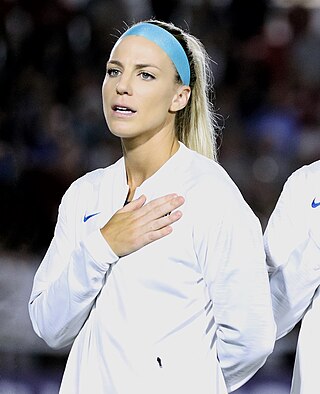
Julie Beth Ertz is an American soccer player for the United States women's national soccer team. She first appeared for the United States national team during an international friendly against Scotland on February 9, 2013. She has since made more than 100 total appearances for the team.
Isaac Asimov, American science fiction writer (b. 1920) deaths
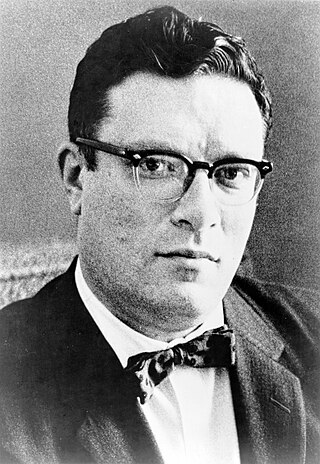
Isaac Asimov was an American writer and professor of biochemistry at Boston University. During his lifetime, Asimov was considered one of the "Big Three" science fiction writers, along with Robert A. Heinlein and Arthur C. Clarke. A prolific writer, he wrote or edited more than 500 books. He also wrote an estimated 90,000 letters and postcards. Best known for his hard science fiction, Asimov also wrote mysteries and fantasy, as well as much nonfiction.
Lachlan Coote, Australian rugby league player births

Lachlan Coote is a Scotland and Great Britain international rugby league footballer who plays as a fullback for Hull Kingston Rovers in the Super League.
Charlie McDermott, American actor births

Charles Joseph McDermott Jr. is an American television and film actor, and musician, best known for his role as Axl Heck on ABC's The Middle. He was nominated for the Independent Spirit Award for Best Supporting Male for his performance in the acclaimed film Frozen River.
Andrei Veis, Estonian footballer births
Andrei Veis is an Estonian international footballer who plays in Estonian Meistriliiga for Paide Linnameeskond. He can play as a defender and a midfielder.
Jucilei, Brazilian footballer births

Jucilei da Silva, known simply as Jucilei, is a Brazilian professional footballer who plays for Boavista as a central or defensive midfielder.
Leigh Adams, Australian footballer births
Leigh Adams is a former professional Australian rules footballer who played with the North Melbourne Football Club in the Australian Football League (AFL).
Daniele Gasparetto, Italian footballer births
Daniele Gasparetto is an Italian footballer who plays as a defender for Serie D club Legnago Salus.
Carlton Mitchell, American football player births

Carlton Mitchell is a former American football wide receiver. He was drafted by the Cleveland Browns of the National Football League (NFL) in the sixth round of the 2010 NFL Draft. He played college football at South Florida.
Fabrice Muamba, Congolese-English footballer births

Fabrice Ndala Muamba is an English former professional footballer who played for Arsenal, Birmingham City and Bolton Wanderers as a central midfielder. Born in Zaire, Muamba moved to England at the age of 11 and subsequently played for England up to under-21 level.
Ivonne Orsini, Puerto Rican model and television host, Miss World Puerto Rico 2008 births

Ivonne Marie Orsini López is a Puerto Rican actress, model and TV personality. Her career began in the pageantry industry, but she has moved into other media. Orsini was one of the hosts of WAPA-TV show ¡Viva la tarde!. Currently, she is now the co-host of the Puerto Rican version of Hoy Día on Telemundo station WKAQ-TV.
Miss World Puerto Rico 2008, The annual competition was held in Puerto Rico, televised live by Telemundo Puerto Rico. Miss World Puerto Rico 2007, Jennifer Guevara Campos of Orocovis was succeeded by Ivonne Orsini, from San Juan who won the Miss World Puerto Rico 2008 title on March 27, 2008. Orsini represented Puerto Rico at the Miss World 2008 contest.
Benjamin Corgnet, French footballer births

Benjamin Corgnet is a French professional footballer who plays as a midfielder.
Heidi Mount, American model births

Heidi Mount is an American fashion model, modeling for fashion houses such as Michael Kors, Bottega Veneta, Sonia Rykiel, Versace, and Valentino. She has appeared in campaigns for Chanel, Prada, and Bally.
Juan Adriel Ochoa, Mexican footballer births
Juan Adriel Ochoa Reyes is a Mexican footballer who played in the Primera División A for Club Universidad de Guadalajara.
Levi Porter, English footballer births
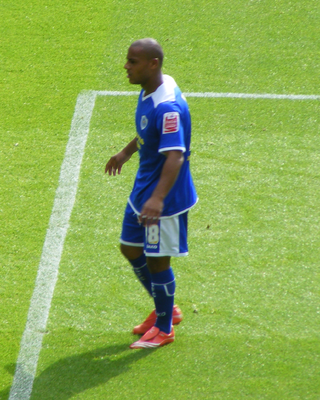
Levi Roger Porter is an English footballer who most recently played for Melton Town F.C.
Hilary Rhoda, American model births

Hilary Hollis Rhoda is an American model. She is perhaps best known for her work with the brand Estée Lauder and her 2009, 2010 and 2011 appearances in the Sports Illustrated Swimsuit Issue.
Nikolas Asprogenis, Cypriot footballer births
Nikolas Asprogenous is a Cypriot former professional footballer who played as a goalkeeper.
Aaron Curry, American football player births

Aaron Curry is an American college football coach and former linebacker who played in the National Football League. He is currently an assistant coach with the Seattle Seahawks football team. Curry was drafted by the Seattle Seahawks in the first round in the 2009 NFL Draft out of Wake Forest. Curry also played for the Oakland Raiders in 2011 and 2012.
Goeido Gotaro, Japanese sumo wrestler births

Gōeidō Gōtarō is a former sumo wrestler from Osaka Prefecture, Japan. He made his professional debut in January 2005 and reached the top makuuchi division in September 2007. Long regarded as one of the most promising Japanese wrestlers in sumo, Gōeidō holds the modern record for the most consecutive appearances at sumo's third highest rank of sekiwake, at 14 tournaments. He was finally promoted to the rank of ōzeki following the July 2014 tournament, after scores of twelve wins against three losses in two of the previous three tournaments. However, he only managed to win ten or more bouts in a tournament as an ōzeki on six occasions, and was kadoban, or in danger of demotion, eight times. He won his only top division tournament in September 2016 with a perfect 15–0 record and was a runner-up seven times in his career. He retired in January 2020 after two consecutive losing records that would have seen him demoted, to become an elder of the Japan Sumo Association under the name of Takekuma.
Ryota Moriwaki, Japanese footballer births
Ryota Moriwaki is a Japanese football player who plays for Ehime FC.
Clarke MacArthur, Canadian ice hockey player births

Clarke MacArthur is a Canadian former professional ice hockey left winger. MacArthur played in the National Hockey League (NHL) with the Ottawa Senators, Buffalo Sabres, Atlanta Thrashers and Toronto Maple Leafs. He was originally selected by Buffalo in the third round, 74th overall, at the 2003 NHL Entry Draft.
Frank Ongfiang, Cameroonian footballer births

Franck Olivier Ongfiang is a Cameroonian former professional footballer who played as a midfielder.
Sinqua Walls, American basketball player and actor births

Sinqua Walls is an American actor known for appearing in Friday Night Lights, The Secret Life of the American Teenager, and American Soul.
Max Bemis, American singer-songwriter births

Maxim Adam Bemis is an American singer, songwriter and musician. He was the lead singer, primary composer and primary lyricist of the band, Say Anything, before their hiatus in 2018. He also sings alongside Chris Conley in the supergroup Two Tongues, plays alongside his wife Sherri Dupree-Bemis under the name Perma, and is a comic book writer, chiefly for Marvel Comics.
Michaël Ciani, French footballer births

Michaël Henry Ciani is a French former professional footballer who played as a centre back.
Siboniso Gaxa, South African footballer births
Siboniso Gaxa, nicknamed Pa is a South African retired football defender who played for big clubs such as Ajax Cape Town, Kaizer Chiefs F.C. ,Mamelodi Sundowns F.C. and as Bafana Bafana defender.
Diana Matheson, Canadian soccer player births

Diana Beverly Matheson is a retired Canadian professional soccer player who played for the Canada national team from 2003 to 2020 and multiple professional women's teams over the course of her career. She is best known for scoring the bronze medal-winning goal for Canada in the 92nd minute against France at the 2012 Summer Olympics. She also won a bronze medal at the 2016 Rio Olympics and gold medal at the 2011 Pan American Games with the senior national team.
Mehdi Ballouchy, Moroccan footballer births

Mehdi Ballouchy is a retired Moroccan professional footballer who played as a midfielder. He is currently one of the coaching staff for New York City FC.
Jerome Kaino, New Zealand rugby player births

Jerome Kaino is a former New Zealand rugby union player.
Mitsuru Nagata, Japanese footballer births

Mitsuru Nagata is a Japanese retired football player. He played for Japan national team.
Remi Nicole, English singer-songwriter and actress births
Remi Nicole Wilson, better known as Remi Nicole, is a British singer-songwriter and actress who was born in North London, but now resides in Los Angeles. She is best known for her single "Go Mr Sunshine", which was released in 2007. Her debut album, My Conscience and I, was released later that year and her second, Cupid Shoot Me, on 31 August 2009. As an actress she is credited as Remi Wilson.
James Wade, English darts player births

James Martin Wade is an English professional darts player, currently playing in the Professional Darts Corporation (PDC). He became the youngest player to win a major PDC title, when he won the 2007 World Matchplay at the age of 24. This record has since been broken by Michael van Gerwen. Wade has won eleven PDC majors, third in the all-time list behind Phil Taylor and Michael van Gerwen.
Katie Weatherston, Canadian ice hockey player births

Katherine Marie "Katie" Weatherston is a Canadian retired ice hockey player and head coach of the Lebanese women’s national ice hockey team. As a member of the Canadian women's national ice hockey team, she won Olympic gold in the women's ice hockey tournament at the 2006 Winter Olympics in Turin and medalled at two IIHF Women's World Championships.
Jayanto Nath Chaudhuri, Indian General who served as the Chief of Army Staff of the Indian Army from 1962 to 1966 and the Military Governor of Hyderabad State from 1948 to 1949. (b. 1908) deaths

General Jayanto Nath Chaudhuri was a General Officer in the Indian Army. He served as the 6th Chief of Army Staff from 1962 to 1966 and the Military Governor of Hyderabad State from 1948 to 1949. After his retirement from the Indian Army, he served as the Indian High Commissioner to Canada from 19 July 1966 until August 1969.
Travis Moen, Canadian ice hockey player births

Travis Shawn Moen is a Canadian former professional ice hockey player who most recently played under contract for the Dallas Stars of the National Hockey League (NHL). Although he was born in Swift Current, Saskatchewan, he grew up in Stewart Valley, Saskatchewan. He was originally drafted in the fifth round of the 2000 NHL Entry Draft by the Calgary Flames; however, he never played for the club.
Miguel Ángel Silvestre, Spanish actor births

Miguel Ángel Silvestre Rambla is a Spanish actor. He rose to prominence with his performance as El Duque in Sin tetas no hay paraíso.
Robert Earnshaw, Welsh footballer births

Robert Earnshaw is a Welsh former international footballer who played as a forward. He is the only player to have scored a hat-trick in the Premier League, all three divisions of the English Football League, the League Cup, the FA Cup, and for his country in an international match.
Jeff Faine, American football player births

Jeffrey Kalei Faine is a former American football center. He was drafted by the Cleveland Browns 21st overall in the 2003 NFL Draft. He played college football at Notre Dame.
Lucas Licht, Argentine footballer births
Lucas Matías Licht is an Argentine professional footballer who plays for Club Atlético Villa San Carlos mainly as a left-back but also as a left winger.
Alex Suarez, American bass player births

Cobra Starship was an American dance-pop band founded in 2006 by Gabe Saporta (ex-Midtown), and headquartered in New York City. He recorded the first album as a solo project, While the City Sleeps, We Rule the Streets. Saporta later enlisted guitarist Ryland Blackinton, bassist Alex Suarez, drummer Nate Novarro, and keytarist Victoria Asher, all of whom provide backing vocals.
Tommi Evilä, Finnish long jumper births

Jaakko Tommi Kristian Evilä is a Finnish former long jumper. He gained fame following his surprise bronze in the 2005 Helsinki World Championships, which was Finland's only medal in the championships.
Tanja Poutiainen, Finnish skier births

Tanja Tuulia Poutiainen is a retired World Cup alpine ski racer from Finland. She specialized in the technical events of slalom and giant slalom, and was the silver medalist in the women's giant slalom at the 2006 Winter Olympics in Torino.
Antonio Thomas, American wrestler births

Thomas Matera is an American professional wrestler and personal trainer, better known by his ring name Antonio Thomas. He is best known for his stint with World Wrestling Entertainment on the Raw brand as one half of The Heart Throbs.
Lord Frederick Windsor, English journalist and financier births
Lord Frederick Michael George David Louis Windsor is a British financial analyst, and the only son of Prince and Princess Michael of Kent. He is married to British actress Sophie Winkleman. He is currently 52nd in the line of succession to the British throne. He is president of Soldier On!, a charity for the professional development of vulnerable and disadvantaged people.
Clay Travis, American sports journalist, blogger, and broadcaster births
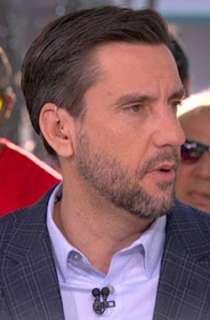
Richard Clay Travis is an American writer, lawyer, radio host and television analyst. As a sports journalist, Travis founded OutKick.
Ivan Vasilyov, Bulgarian architect, designed the SS. Cyril and Methodius National Library (b. 1893) deaths
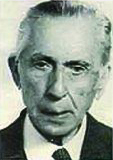
Ivan Vasilyov was a Bulgarian architect, born in 1893, deceased in 1979.

The SS. Cyril and Methodius National Library is the national library of Bulgaria, situated in the capital city of Sofia. Founded on 4 April 1878, the library received the status of Bulgarian National Library three years later and the Bulgarian National Revival Archive was merged into it in 1924.
Imani Coppola, American singer-songwriter and violinist births

Imani Francesca Coppola is an American singer-songwriter and violinist. Her debut single "Legend of a Cowgirl" reached the top 40 on the Billboard Hot 100 and the UK Singles Chart in 1997. Her debut album, Chupacabra, released by Columbia Records, was praised by critics and appeared on the US Heatseekers Albums chart. In 2001, Coppola appeared as a guest artist on the Baha Men single "You All Dat", which broke the top 10 in Australia and gave Coppola her second entry on the Billboard Hot 100 to date.
Robert Glasper, American singer-songwriter, pianist, and producer births
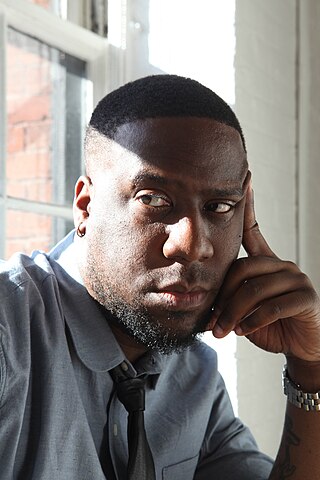
Robert Andre Glasper is an American pianist, record producer, songwriter, and musical arranger with a career that bridges several different musical and artistic genres, mostly centered on jazz. To date, Glasper has won four Grammy Awards and received nine nominations across eight categories.
Tim Hasselbeck, American football player and sportscaster births
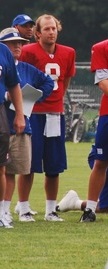
Timothy Thomas Hasselbeck is an American sports journalist and former American football quarterback who currently works as an analyst for ESPN. He played eight seasons in the NFL with the New York Giants, Washington Redskins, Philadelphia Eagles, Buffalo Bills, Baltimore Ravens, and Arizona Cardinals as well as the Berlin Thunder of NFL Europe. He played college football at Boston College. He is the younger brother of former NFL quarterback Matt Hasselbeck.
Myleene Klass, Austrian/Filipino-English singer, pianist, and model births

Myleene Angela Klass is a British singer, presenter, musician, model and businesswoman. She was a member of the pop group Hear'Say, and later released two solo classical crossover albums in 2003 and 2007. More recently, Klass has been a television and radio presenter. She has hosted television series including Popstar to Operastar (2010–2011) and BBQ Champ (2015) on ITV and The One Show (2007) on BBC One. She was briefly a regular panellist on the ITV lunchtime chat show Loose Women in 2014.
Martín Méndez, Uruguayan bass player and songwriter births

Martín Méndez is a Uruguayan Swedish bassist of progressive death metal band Opeth and second longest serving member of the band, behind lead vocalist, songwriter and guitarist Mikael Åkerfeldt.
Blaine Neal, American baseball player births
Blaine Neal is an American former professional baseball relief pitcher. Neal played with the Florida Marlins (2001–2003), San Diego Padres (2004), Boston Red Sox (2005), and Colorado Rockies (2005) of Major League Baseball (MLB). He bats left-handed and throws right-handed.
Igor Semshov, Russian footballer births

Igor Petrovich Semshov is a Russian professional football coach and a former player.
Ville Nieminen, Finnish ice hockey player births

Ville Juhani Nieminen is a Finnish former professional ice hockey forward who played over 400 games in the National Hockey League.
Andy Phillips, American baseball player and coach births
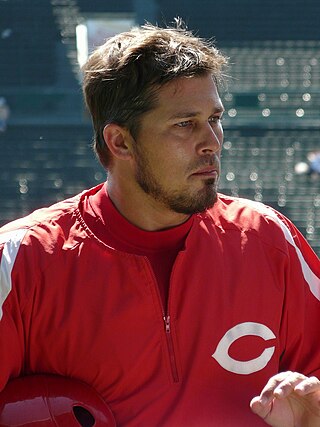
George Andrew Phillips is an American baseball coach and former infielder. He played college baseball at Alabama for coach Jim Wells from 1996 to 1999 and played in Major League Baseball (MLB) for the New York Yankees, New York Mets, and Cincinnati Reds. Phillips was raised in Demopolis, Alabama, where he played baseball for the Demopolis Academy Generals. Phillips was an All-American for the Tide.
Kōichi Kido, Japanese politician, 13th Lord Keeper of the Privy Seal of Japan (b. 1889) deaths

Marquis Kōichi Kido was a Japanese statesman who served as Lord Keeper of the Privy Seal of Japan from 1940 to 1945, and was the closest advisor to Emperor Hirohito throughout World War II. He was convicted of war crimes and sentenced to life imprisonment, of which he served 6 years before being released in 1953.
The Lord Keeper of the Privy Seal of Japan was an administrative post not of Cabinet rank in the government of the Empire of Japan, responsible for keeping the Privy Seal of Japan and State Seal of Japan. The modern office of the Lord Keeper of the Privy Seal was identical with the old Naidaijin only in name and should not be confused. The office was abolished in 1946 after World War II.
Candace Cameron Bure, American actress and talk show panelist births

Candace Cameron Bure is an American actress, producer, author and television personality. She is known for portraying D.J. Tanner on Full House and its sequel series Fuller House, and a number of roles in Hallmark Channel original productions—including the title character in their adaptations of the Aurora Teagarden novel series.
James Fox, Welsh singer-songwriter, guitarist, and actor births

James Richard Mullett, known professionally as James Fox, is a Welsh pop singer, songwriter, pianist and guitarist. He represented the United Kingdom in the Eurovision Song Contest 2004 in Istanbul. In 2008 he wrote and recorded the Cardiff City F.C. FA Cup Final song, "Bluebirds Flying High".
Chris Hoke, American football player births

Christopher L. Hoke is a former American football defensive lineman in the National Football League. He spent his entire eleven-year professional career with the Pittsburgh Steelers.
Georg Hólm, Icelandic bass player births

Georg "Goggi" Hólm is the bassist of the Icelandic post-rock band Sigur Rós. He is the most prominent member of Sigur Rós in the English press, as he does significantly more press than the other members due to him being the most fluent English speaker in the band.
Hirotada Ototake, Japanese author and educator births

Hirotada Ototake is a Japanese sports writer from Tokyo, Japan.
Zach Braff, American actor, director, producer, and screenwriter births

Zachary Israel Braff is an American actor and filmmaker. He portrayed J.D. on the NBC/ABC television series Scrubs (2001–2010), for which he was nominated for the Primetime Emmy Award for Outstanding Lead Actor in a Comedy Series in 2005 as well as for three Golden Globe Awards from 2005 to 2007. He starred in The Broken Hearts Club: A Romantic Comedy (2000), The Last Kiss (2006), The Ex (2006), and In Dubious Battle (2016). He has done voice-work for Chicken Little (2005), Oz the Great and Powerful (2013), and the Netflix series BoJack Horseman.
Hal Gill, American ice hockey player births

Harold Priestley Gill III is an American former professional ice hockey defenseman who played 16 NHL seasons with six different teams, winning the Stanley Cup with the Pittsburgh Penguins in 2009.
Willem Marinus Dudok, Dutch architect (b. 1884) deaths

Willem Marinus Dudok was a Dutch modernist architect. He was born in Amsterdam. He became City Architect for the town of Hilversum in 1928 where he was best known for the brick Hilversum Town Hall, completed in 1931. Not only did he design the building, but also the interior including the carpets, furniture and even the mayor's meeting hammer. He also designed and built about 75 houses, public buildings and entire neighborhoods.
Hudson Fysh, Australian pilot and businessman, co-founded Qantas Airways Limited (b. 1895) deaths

Sir Wilmot Hudson Fysh, KBE, DFC was an Australian aviator and businessman. A founder of the Australian airline company Qantas, Fysh was born in Launceston, Tasmania. Serving in the Battle of Gallipoli and Palestine Campaign as a lieutenant of the Australian Light Horse Brigade, Fysh later became an observer and gunner to Paul McGinness in the AFC. He was awarded a Distinguished Flying Cross during the aftermath of the war for his services to aerial warfare.
Qantas Airways Limited is the flag carrier of Australia and the country's largest airline by fleet size, international flights, and international destinations. It is the world's third-oldest airline still in operation, having been founded in November 1920; it began international passenger flights in May 1935. Qantas is an acronym of the airline's original name, Queensland and Northern Territory Aerial Services, as it originally served Queensland and the Northern Territory, and is popularly nicknamed "The Flying Kangaroo". Qantas is a founding member of the Oneworld airline alliance.
Donnie Edwards, American football player births
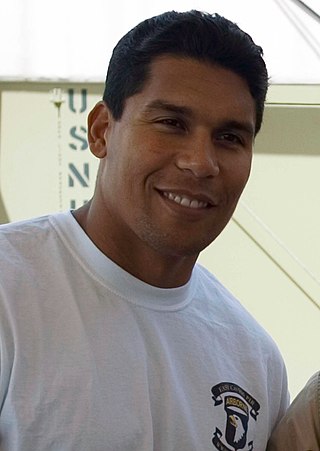
Donnie Edwards is a former American football linebacker from San Diego, California. He played for thirteen seasons in the National Football League (NFL) for the Kansas City Chiefs and the San Diego Chargers. He began his career as an All-American Collegiate at the University of California, Los Angeles. He was drafted by the Kansas City Chiefs in the fourth round of the 1996 NFL Draft.
Randall Godfrey, American football player births

Randall Euralentris Godfrey is a former American football linebacker in the National Football League. Godfrey played college football at the University of Georgia, where he majored in housing and consumer economics. He also played High School Football at Lowndes High School in Valdosta Georgia. He was drafted in the 1996 NFL Draft by the Dallas Cowboys with the 49th overall pick. He then played for the Tennessee Titans and the Seattle Seahawks.
Rie Miyazawa, Japanese model and actress births

Rie Miyazawa is a Japanese actress and former teen idol. She is regarded as one of Japan's top actresses, and her accolades include six Japan Academy Film Prizes and three Kinema Junpo Awards
Sun Wen, Chinese footballer births
Sun Wen is a Chinese former professional footballer who played as a forward. She previously captained the China national team and the Atlanta Beat of the Women's United Soccer Association (WUSA).
Anders Thomas Jensen, Danish director and screenwriter births

Anders Thomas Jensen is a Danish screenwriter and film director. His film Election Night won the 1998 Academy Award for Best Live Action Short Film.
Dickey Simpkins, American basketball player and sportscaster births
LuBara Dixon "Dickey" Simpkins is an American former professional basketball player best known for his tenure with the Chicago Bulls in the late 1990s. He is currently a scout for the Washington Wizards.
Igor Stravinsky, Russian-American pianist, composer, and conductor (b. 1882) deaths

Igor Fyodorovich Stravinsky was a Russian composer, pianist and conductor, later of French and American citizenship. He is widely considered one of the most important and influential composers of the 20th century and a pivotal figure in modernist music.
Olaf Kölzig, South African-German ice hockey player and coach births

Olaf Kölzig is a South African-born German former professional ice hockey goaltender and current goaltender coach and player development coach for the Washington Capitals of the National Hockey League (NHL). With the exception of eight games with the Tampa Bay Lightning, he played his entire 14-year NHL career with the Capitals.
Roy Mayorga, American drummer, songwriter, and producer births

Roy Mayorga is an American musician, best known as the drummer of heavy metal bands Hellyeah and Stone Sour and is currently the drummer for the industrial metal band Ministry.
Huang Xiaomin, Chinese swimmer births
Huang Xiaomin is a Chinese former breaststroke swimmer, whose best performance during her career was winning the silver medal in the 200 m breaststroke at the 1988 Summer Olympics in Seoul, South Korea. She was born in Qiqihar, Heilongjiang. She admitted to have used doping substances during her active career and is now publicly opposed to it.
Maurice Stokes, American basketball player (b. 1933) deaths
Maurice Stokes was an American professional basketball player. He played for the Cincinnati/Rochester Royals of the National Basketball Association (NBA) from 1955 to 1958. Stokes was a three-time NBA All-Star, a three-time All-NBA Second Team member and the 1956 NBA Rookie of the Year. His career – and later his life – was cut short by a debilitating brain injury and paralysis.
Bret Boone, American baseball player and manager births
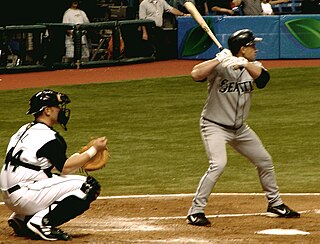
Bret Robert Boone is a former Major League Baseball second baseman. During his career Boone was a three-time All-Star, four-time Gold Glove winner, and two-time Silver Slugger Award winner. He is a third generation professional athlete. His brother is Aaron Boone, manager of the New York Yankees.
Bison Dele, American basketball player (d. 2002) births
Bison Dele was an American professional basketball player who played center for the NBA's Orlando Magic, Denver Nuggets, Los Angeles Clippers, Chicago Bulls and Detroit Pistons. Dele won a championship with the Bulls in 1997. He is believed to have been murdered at sea by his older brother Miles Dabord in 2002. His girlfriend, Serena Karlan, and skipper Bertrand Saldo are also presumed to have been killed by Dabord.
Philipp Peter, Austrian race car driver births
Philipp Peter is a race car driver from Austria.
Paul Rudd, American actor births
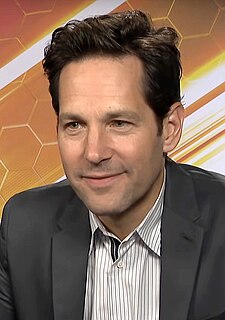
Paul Stephen Rudd is an American actor. He studied theater at the University of Kansas and the American Academy of Dramatic Arts, before making his acting debut in 1991. He received a star on the Hollywood Walk of Fame in July 2015. He was named one of Forbes Celebrity 100 in 2019. In 2021, he was named People magazine's "Sexiest Man Alive".
Spencer Wells, American geneticist and anthropologist births

Spencer Wells is an American geneticist, anthropologist, author and entrepreneur. He co-hosts The Insight podcast with Razib Khan. Wells led The Genographic Project from 2005 to 2015, as an Explorer-in-Residence at the National Geographic Society, and is the founder and executive director of personal genomics nonprofit The Insitome Institute.
Archon Fung, American political scientist, author, and academic births
Archon Fung, is the Winthrop Laflin McCormack Professor of Citizenship and Democracy at Harvard University's Kennedy School of Government and co-founder of the Transparency Policy Project. Fung served as an assistant professor of public policy at the Kennedy School from July 1999–June 2004, then as an associate professor of public policy at the Kennedy School from July 2004–October 2007, and finally as a professor of public policy from October 2007–March 2009 before being named as the Ford Foundation Chair of Democracy and Citizenship in March 2009. In 2015, he was elected to the Common Cause National Governing Board.
Affonso Giaffone, Brazilian race car driver births
Affonso Giaffone Neto is a Brazilian former racing driver. He is one of several racing drivers in his family; he is a cousin of Felipe Giaffone, and a cousin-in-law of Rubens Barrichello. His father Affonso Giaffone Jr. was also a racing driver.
Julian Anderson, English composer and educator births
Julian Anderson is a British composer and teacher of composition.
Kathleen Barr, Canadian voice actress and singer births
Kathleen Barr is a Canadian voice actress. She is best known for voicing Marie Kanker and Kevin in Ed, Edd n Eddy and Trixie Lulamoon and Queen Chrysalis in My Little Pony: Friendship is Magic. She also voiced Henri Richard Maurice Dutoit LeFevbre in Liberty's Kids, Dot Matrix in ReBoot, Kaiko Nekton in The Deep, Wheezie in Dragon Tales, and Gelorum in Hot Wheels: AcceleRacers.
Tanya Byron, English psychologist and academic births

Tanya Byron is a British psychologist, writer, and media personality, best known for her work as a child therapist on television shows Little Angels and The House of Tiny Tearaways. She also co-created the BBC Two sitcom The Life and Times of Vivienne Vyle with Jennifer Saunders, and still contributes articles to various newspapers.
Jonathan Firth, English actor births
Jonathan Stephen Firth is an English actor. He is best known for his roles in such noted British television productions as Middlemarch, Far from the Madding Crowd, and Victoria & Albert. He lives in Islington, North London.
Vince Flynn, American author (d. 2013) births

Vincent Joseph Flynn was an American author of political thriller novels featuring the fictional assassin Mitch Rapp. He was a story consultant for the fifth season of the television series 24. He died on June 19, 2013, after three years with prostate cancer.
Young Man Kang, South Korean-American director and producer births
Young Man Kang is a Korean filmmaker based in Los Angeles, California, United States. Kang directed and produced The Last Eve (2005), Soap Girl (2002), Cupid's Mistake (2001) and Kimchi Warrior (2009). He is the director and founder of Seoul Webfest.
Black Francis, American singer-songwriter and guitarist births
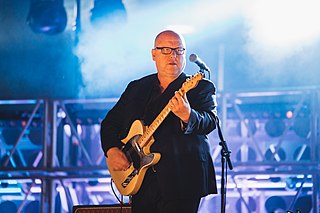
Charles Michael Kittridge Thompson IV is an American singer, songwriter, and guitarist. He is best known as the frontman of the alternative rock band Pixies, with whom he performs under the stage name Black Francis. Following the band's breakup in 1993, he embarked on a solo career under the name Frank Black. After releasing two albums with record label 4AD and one with American Recordings, he left the label and formed a new band, Frank Black and the Catholics. He re-adopted the name Black Francis in 2007.
Sterling Sharpe, American football player and sportscaster births
Sterling Sharpe is a former American football wide receiver and analyst for the NFL Network. He attended the University of South Carolina, and played from 1988 to 1994 with the Green Bay Packers in a career shortened by a neck injury. He is the older brother of Pro Football Hall of Fame tight end Shannon Sharpe.
Rafael Correa, Ecuadorian economist and politician, 54th President of Ecuador births

Rafael Vicente Correa Delgado, known as Rafael Correa, is an Ecuadorian politician and economist who served as President of Ecuador from 2007 to 2017. The leader of the PAIS Alliance political movement from its foundation until 2017, Correa is a democratic socialist and his administration focused on the implementation of left-wing policies. Internationally, he served as president pro tempore of the UNASUR.

The president of Ecuador, officially called the Constitutional President of the Republic of Ecuador, serves as both the head of state and head of government of Ecuador. It is the highest political office in the country as the head of the executive branch of government. Per the current constitution, the President can serve two four-year terms. Prior to that, the president could only serve one four-year term.
Otto Struve, Ukrainian-American astronomer and academic (b. 1897) deaths
Otto Struve was a Russian-American astronomer of Baltic German origins. In Russian, his name is sometimes given as Otto Lyudvigovich Struve ; however, he spent most of his life and his entire scientific career in the United States. Otto was the descendant of famous astronomers of the Struve family; he was the son of Ludwig Struve, grandson of Otto Wilhelm von Struve and great-grandson of Friedrich Georg Wilhelm von Struve. He was also the nephew of Karl Hermann Struve.
Iris Häussler, German sculptor and academic births
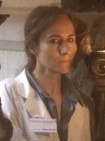
Iris Haeussler is a conceptual and installation art artist of German origin. She lives in Toronto, Ontario, Canada. Many of Iris Haeussler's works are detailed, hyperrealistic installations that visitors can decode as narrative stories. Recurring topics in her work include historic, cultural, social and geographic origins; family ties, relationships, memory, history, trauma and obsession.
Marco Schällibaum, Swiss footballer, coach, and manager births

Marco Schällibaum is a Swiss football manager and former player. He is the manager of Swiss Challenge League side Yverdon-Sport FC.
Rory Bremner, Scottish impressionist and comedian births
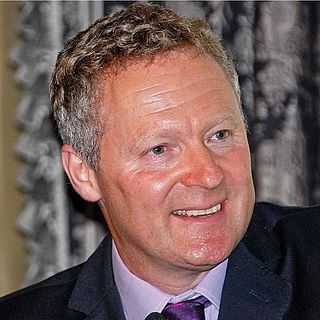
Roderick Keith Ogilvy "Rory" Bremner, is a Scottish impressionist and comedian, noted for his work in political satire and impressions of British public figures. He is also known for his work on Mock the Week as a panellist, Rory Bremner...Who Else?, and sketch comedy series Bremner, Bird and Fortune.
Peter Jackson, English footballer and manager births

Peter Allan Jackson is a football manager and former footballer. He has previously had two spells as Huddersfield Town manager, whom he helped win the Division Three play-off in 2004, and he has also managed Lincoln City, before taking charge at his former playing club Bradford City in 2011.
Jules Bordet, Belgian microbiologist and immunologist, Nobel Prize laureate (b. 1870) deaths

Jules Jean Baptiste Vincent Bordet was a Belgian immunologist and microbiologist. The bacterial genus Bordetella is named after him. The Nobel Prize in Physiology or Medicine was awarded to him in 1919 for his discoveries relating to immunity.

The Nobel Prize in Physiology or Medicine is awarded yearly by the Nobel Assembly at the Karolinska Institute for outstanding discoveries in physiology or medicine. The Nobel Prize is not a single prize, but five separate prizes that, according to Alfred Nobel's 1895 will, are awarded "to those who, during the preceding year, have conferred the greatest benefit to humankind". Nobel Prizes are awarded in the fields of Physics, Chemistry, Physiology or Medicine, Literature, and Peace.
Warren Haynes, American singer-songwriter and guitarist births

Warren Haynes is an American musician, singer and songwriter. He is best known for his work as longtime guitarist with the Allman Brothers Band and as founding member of the jam band Gov't Mule. Early in his career he was a guitarist for David Allan Coe and The Dickey Betts Band. Haynes also is known for his associations with the surviving members of the Grateful Dead, including touring with Phil Lesh and Friends and the Dead. In addition, Haynes founded and manages Evil Teen Records.
Richard Loe, New Zealand rugby player births
Richard Wyllie Loe is a retired All Black prop forward. He is a sports broadcaster on BSport, Radio Live and SKY Sport.
John Pizzarelli, American singer-songwriter and guitarist births
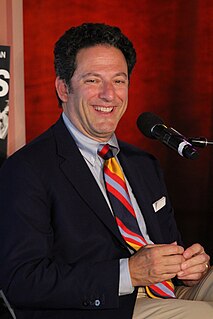
John Paul Pizzarelli Jr. is an American jazz guitarist and vocalist. He has recorded over twenty solo albums and has appeared on more than forty albums by other recording artists, including Paul McCartney, James Taylor, Rosemary Clooney; his father, jazz guitarist Bucky Pizzarelli; and his wife, singer Jessica Molaskey.
Gail Shea, Canadian politician births
Gail A. Shea is a Canadian politician who served as the Member of Parliament for Egmont from 2008 to 2015. She was previously a member of the Legislative Assembly of Prince Edward Island from 2000 to 2007, representing the electoral district of Tignish-DeBlois as a member of the Progressive Conservative Party.
Leo Aryeh Mayer, Polish-Israeli scholar and academic (b. 1895) deaths

Leo Aryeh Mayer, was an Israeli scholar of Islamic art and rector of the Hebrew University of Jerusalem.
Graeme Base, Australian author and illustrator births
Graeme Rowland Base is a British-Australian author and artist of picture books. He is perhaps best known for his second book, Animalia published in 1986, and third book The Eleventh Hour which was released in 1989.
Giorgio Damilano, Italian race walker and coach births

Giorgio Damilano is an Italian former race walker.
Maurizio Damilano, Italian race walker and coach births

Maurizio Damilano is an Italian former race walker. He won 15 individual medals, at senior level, at the International athletics competitions.
Jaroslava Maxová, Czech soprano and educator births

Jaroslava Maxová is a Czech mezzo-soprano opera singer and vocal coach.
Paolo Nespoli, Italian soldier, engineer, and astronaut births

Major Paolo Angelo Nespoli is an Italian astronaut and engineer of the European Space Agency (ESA). In 2007, he first traveled into space aboard the Space Shuttle Discovery as a mission specialist of STS-120. In December 2010 he again traveled into space aboard the Soyuz TMA-20 spacecraft as an Expedition 26/27 flight engineer. Nespoli's third spaceflight was on board Soyuz MS-05, which launched in July 2017 for Expedition 52/53. He was also the European Space Agency's oldest active astronaut prior to his retirement in 2019.
Michele Bachmann, American lawyer and politician births
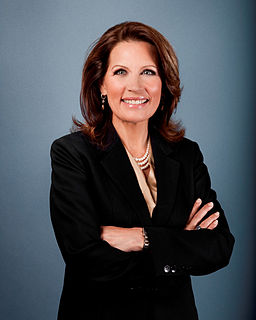
Michele Marie Bachmann is an American politician who was the U.S. representative for Minnesota's 6th congressional district from 2007 until 2015. A member of the Republican Party, she was a candidate for President of the United States in the 2012 election, but lost the Republican nomination to Mitt Romney.
Normand Corbeil, Canadian composer (d. 2013) births
Normand Corbeil was a Canadian composer known for his work on films, video games and television.
Mudassar Nazar, Pakistani cricketer births
Mudassar Nazar is a Pakistani cricket coach and former cricketer with a career in Test cricket for Pakistan and in league cricket in Pakistan and England. He was an opening batsman who played 76 test and 122 one-day matches for Pakistan. After retiring from professional cricket, he has had a number of administrative positions in the cricketing world, including two stints as coach for Pakistan in 1993 and 2001, for Kenya and for several other teams. He was born in Lahore, Punjab.
Lee Scott, English politician births
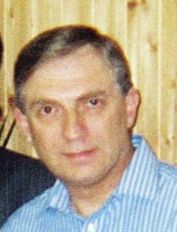
Lee Scott is a British Conservative Party politician. He was the Member of Parliament (MP) for Ilford North from 2005 until his defeat at the 2015 general election. Scott is an officer of the Conservative Friends of Israel. In the 2021 Essex County Council election he was elected to the ward of Chigwell & Loughton Broadway.
Sebastian Spreng, Argentinian-American painter and journalist births

Sebastian Spreng is an Argentine-born American visual artist and music journalist. He is a self-taught artist. He lives in Bay Harbor Islands, Florida.
Dilip Vengsarkar, Indian cricketer and coach births

Dilip Balwant Vengsarkar pronunciation (help·info) is a former Indian cricketer and a cricket administrator. He was known as one of the foremost exponents of the drive. Along with Sunil Gavaskar and Gundappa Viswanath, he was a key player in the Indian batting line up in the late 70s and early 80s. He went on to play until 1992.
Rob Epstein, American director and producer births

Robert P. Epstein, is an American director, producer, writer, and editor. He has won two Academy Awards for Best Documentary Feature, for the films The Times of Harvey Milk and Common Threads: Stories from the Quilt.
Michael Rooker, American actor, director, and producer births

Michael Rooker is an American actor known for his roles as Henry in Henry: Portrait of a Serial Killer (1986), Chick Gandil in Eight Men Out (1988), Frank Baily in Mississippi Burning (1988), Terry Cruger in Sea of Love (1989), Rowdy Burns in Days of Thunder (1990), Bill Broussard in JFK (1991), Hal Tucker in Cliffhanger (1993), Sherman McMaster in Tombstone (1993), Jared Svenning in Mallrats (1995), Detective Howard Cheney in The Bone Collector (1999), Grant Grant in Slither (2006), Merle Dixon in AMC's The Walking Dead (2010–2013), Yondu Udonta in Guardians of the Galaxy (2014), its sequel, Guardians of the Galaxy Vol. 2 (2017), and the animated series What If...? (2021), and Savant in The Suicide Squad (2021).
Cathy Jones, Canadian actress, comedian, and writer births

Catherine Frederica "Cathy" Jones is a Canadian actress, comedian and writer. She is known for her work for 28 years on the Canadian television series This Hour Has 22 Minutes. Jones left the show in 2021.
Patrick Doyle, Scottish actor and composer births

Patrick Doyle is a Scottish film composer with Irish heritage. A longtime collaborator of actor-director Kenneth Branagh, Doyle is known for his work composing for films such as Henry V, Sense and Sensibility, Hamlet, Carlito's Way, and Gosford Park, as well as Harry Potter and the Goblet of Fire, Rise of the Planet of the Apes, Thor, Brave, Cinderella, and Murder on the Orient Express. Doyle has been nominated for two Academy Awards and two Golden Globe Awards, and is the recipient of the ASCAP Henry Mancini Award for "outstanding achievements and contributions to the world of film and television music".
Christopher Franke, German-American drummer and songwriter births
Christopher Franke is a German musician and composer. From 1971 to 1987, he was a member of the electronic group Tangerine Dream. Initially a drummer with The Agitation, later renamed Agitation Free, his primary focus eventually shifted to keyboards and synthesizers as the group moved away from its psychedelic rock origins. While he was not the first musician to use an analog sequencer, he was probably the first to turn it into a live performance instrument, thus laying the rhythmic foundation for classic Tangerine Dream pieces and indeed for the whole Berlin school sound.
Idris Davies, Welsh poet and author (b. 1905) deaths
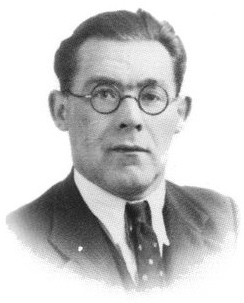
Idris Davies was a Welsh poet. Born in Rhymney, near Merthyr Tydfil in South Wales, he became a poet, originally writing in Welsh, but later writing exclusively in English.
Udo Dirkschneider, German singer-songwriter births
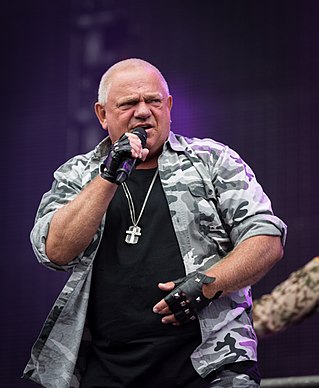
Udo Dirkschneider is a German singer and songwriter who rose to fame with German heavy metal band Accept. After leaving the band in 1987, he formed U.D.O., with which he has also enjoyed commercial success.
Marilu Henner, Greek-Polish American actress and author births

Mary Lucy Denise Henner is an American actress. She began her career appearing in the original production of the musical Grease in 1971, before making her screen debut in the 1977 comedy-drama film Between the Lines. In 1977, Henner was cast in her breakthrough role as Elaine O'Connor Nardo in the ABC/NBC sitcom Taxi, a role she played until 1983 and received five Golden Globe Award nominations. She later had co-starring roles in films such as Hammett (1982), The Man Who Loved Women (1983), Cannonball Run II (1984), Johnny Dangerously (1984), Rustlers' Rhapsody (1985), Ladykillers (1988), L.A. Story (1991), and Noises Off (1992). She returned to television with a starring role in the CBS sitcom Evening Shade (1990–1994), and later had leading roles in many made-for-television movies.
Michel Larocque, Canadian ice hockey player and manager (d. 1992) births
Michel Raymond "Bunny" Larocque was a Canadian professional ice hockey goaltender who played for the Montreal Canadiens, Toronto Maple Leafs, Philadelphia Flyers and St. Louis Blues in the National Hockey League.
Bert Blyleven, Dutch-American baseball player and sportscaster births
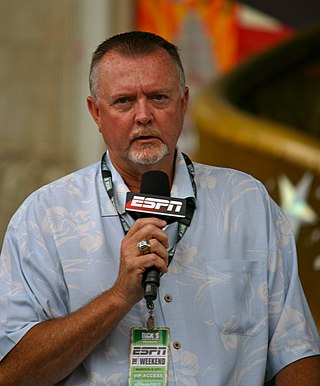
Bert Blyleven is a Dutch-American former professional baseball pitcher who played 22 seasons in Major League Baseball (MLB) from 1970 to 1992, primarily with the Minnesota Twins. Blyleven recorded 3,701 career strikeouts, the fifth-most in MLB history. He won 287 games, 27th-most all-time and pitched 4,970 innings, 14th-most all-time. A renowned curveball pitcher, Blyleven was also a two-time All-Star and World Series champion. Although under-appreciated during his playing career, he was inducted into the Baseball Hall of Fame in 2011—his second-to-last year of eligibility.
Jean-Marc Boivin, French skier, mountaineer, and pilot (d. 1990) births

Jean-Marc Boivin was a French mountaineer, extreme skier, hang glider and paraglider pilot, speleologist, BASE jumper, film maker and author. The holder of several altitude records for hang gliding and paragliding, the creator of numerous first ascents and first ski descents in the Alps, a member of the team that broke the record for a sub-glacial dive and the first person to paraglide from the summit of Mount Everest, Boivin was a pioneer of extreme sports. He died from injuries incurred after BASE jumping off Angel Falls in Venezuela, the highest waterfall in the world.
Pascal Rogé, French pianist births
Pascal Rogé is a French pianist.
Claire Morissette, Canadian cycling activist (d. 2007) births

Claire Morissette was a Canadian cycling advocate who fought for equal cyclists' rights in Montreal since 1976. She was a member of the group Le Monde à Bicyclette. Notable were the stunts they organized to raise consciousness of automobile transportation's negative impact on cities and their inhabitants, such as bringing snow skis and toboggans on subways to protest the exclusion of bicycles and a die-in on the corner of St. Catherine and University streets in which 100 people lay in the street adorned with fake blood and surrounded with wrecked bikes.
Cleo Odzer, American anthropologist and author (d. 2001) births

Cleo Odzer was an American writer who authored books on prostitution in Thailand, the hippie culture of Goa, India, and cybersex.
Louis Wilkins, American pole vaulter (b. 1882) deaths

Louis Gary Wilkins was an American athlete who competed mainly in the pole vault. He competed for the United States in the 1904 Summer Olympics held in St Louis, United States in the pole vault where he won the bronze medal.
Alyson Bailes, English academic and diplomat (d. 2016) births

Alyson Judith Kirtley Bailes CMG was a British diplomat, political scientist, academic and polymath.
Patrick Hernandez, French singer-songwriter births
Patrick Pierre Hernandez is a French singer who had a worldwide hit with "Born to Be Alive" in 1979.
Ng Ser Miang, Singaporean athlete, entrepreneur and diplomat births

Ng Ser Miang, is a Singaporean entrepreneur, diplomat, and retired sailor. He founded Trans-Island Bus Services in 1982 and is a board member of Singapore Press Holdings. Since 1990, he has been the vice-president of the Singapore National Olympic Council, and since 2009, has served as a vice-president of the International Olympic Committee. In 2013, he was a candidate for the presidency of the International Olympic Committee, but eventually lost to Thomas Bach.
Horst Ludwig Störmer, German physicist and academic, Nobel Prize laureate births

Horst Ludwig Störmer is a German physicist, Nobel laureate and emeritus professor at Columbia University. He was awarded the 1998 Nobel Prize in Physics jointly with Daniel Tsui and Robert Laughlin "for their discovery of a new form of quantum fluid with fractionally charged excitations". He and Tsui were working at Bell Labs at the time of the experiment cited by the Nobel committee.

The Nobel Prize in Physics is a yearly award given by the Royal Swedish Academy of Sciences for those who have made the most outstanding contributions for humankind in the field of physics. It is one of the five Nobel Prizes established by the will of Alfred Nobel in 1895 and awarded since 1901, the others being the Nobel Prize in Chemistry, Nobel Prize in Literature, Nobel Peace Prize, and Nobel Prize in Physiology or Medicine. Physics is traditionally the first award presented in the Nobel Prize ceremony.
John Ratzenberger, American actor and director births
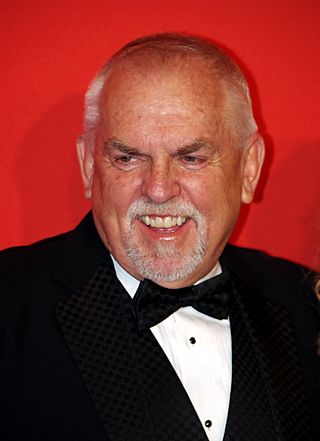
John D. Ratzenberger is an American actor and director. He is best known for playing the character Cliff Clavin on the comedy series Cheers, for which he earned two Primetime Emmy nominations. Ratzenberger voiced characters in Pixar Animation Studios' feature films, including Hamm in the Toy Story franchise, The Abominable Snowman in the Monsters, Inc. franchise, Mack in the Cars franchise, The Underminer in The Incredibles franchise, and others.
André Weinfeld, French-American director, producer, and screenwriter births

André Weinfeld, is a French and American film and television producer, director, screenwriter, cinematographer, photographer, and journalist. He is an alumnus of the prestigious Lycée Louis-le-Grand and the Sorbonne University in Paris.
Mike Worboys, English mathematician and computer scientist births
Michael Worboys is a British mathematician and computer scientist. He is professor of spatial informatics at the School of Computing and Mathematical Sciences at the University of Greenwich, London, England.
Herbert Backe, German agronomist and politician (b. 1896) deaths
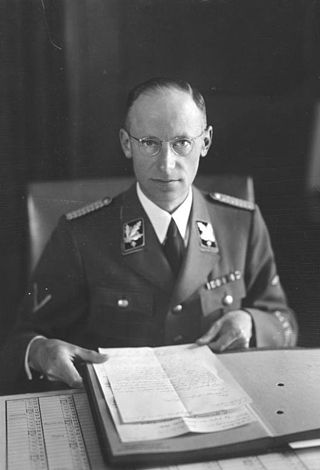
Herbert Friedrich Wilhelm Backe was a German politician and SS Senior group leader (SS-Obergruppenführer) in Nazi Germany who served as State Secretary and Minister in the Reich Ministry of Food and Agriculture. He was a doctrinaire racial ideologue, a long-time associate of Richard Walther Darré and a personal friend of Reinhard Heydrich. He developed and implemented the Operation Hunger that envisioned death by starvation of millions of Slavic and Jewish "useless eaters" following Operation Barbarossa, the 1941 invasion of the Soviet Union.
Paul Beresford, New Zealand-English dentist and politician births

Sir Alexander Paul Beresford is a British-New Zealand dentist and politician who has served as the British Conservative Party Member of Parliament (MP) for Mole Valley in Surrey since the 1997 general election. He was first elected as the MP for Croydon Central in the 1992 general election.
Rodney Bickerstaffe, English trade union leader (d. 2017) births

Rodney Kevan Bickerstaffe was a British trade unionist. He was General Secretary of the National Union of Public Employees (1982–1993) and UNISON (1996–2001), Britain's largest trade union at the time. He later became president of the UK National Pensioners Convention (2001–2005).
Peter Hill, English journalist births
Peter Hill is a British journalist and a former editor of the Daily Express.
Felicity Palmer, English operatic soprano births
Dame Felicity Joan Palmer,, is an English mezzo-soprano and music professor. She sang soprano roles until 1983.
Rose O'Neill, American cartoonist, illustrator, artist, and writer (b. 1874) deaths

Rose Cecil O'Neill was an American cartoonist, illustrator, artist, and writer. She built a successful career as a magazine and book illustrator and, at a young age, became the best-known and highest-paid female commercial illustrator in the United States. O'Neill earned a fortune and international fame by creating the Kewpie, the most widely known cartoon character until Mickey Mouse.
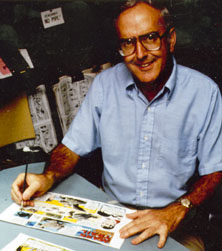
A cartoonist is a visual artist who specializes in both drawing and writing cartoons or comics. Cartoonists differ from comics writers or comic book illustrators in that they produce both the literary and graphic components of the work as part of their practice. Cartoonists may work in a variety of formats, including booklets, comic strips, comic books, editorial cartoons, graphic novels, manuals, gag cartoons, storyboards, posters, shirts, books, advertisements, greeting cards, magazines, newspapers, webcomics, and video game packaging.
Max Clifford, English journalist and publicist (d. 2017) births

Maxwell Frank Clifford was an English publicist who was particularly associated with promoting "kiss and tell" stories in tabloid newspapers.
Roger Cook, New Zealand-English journalist and academic births
Roger Lou Belvedere Cook is a New Zealand-born British investigative journalist and television broadcaster. In 1997, he won a British Academy of Film & Television Arts (BAFTA) special award "for 25 years of outstanding quality investigative reporting", for his show The Cook Report.
Ian MacRae, New Zealand rugby player births

Ian Robert MacRae is a former New Zealand rugby union player. A second five-eighth and centre, MacRae represented West Coast, Bay of Plenty and Hawke's Bay at a provincial level, and was a member of the New Zealand national side, the All Blacks, from 1963 to 1970. He played 28 matches for the All Blacks—three as captain—including 17 internationals.
Mitchell Melton, American lawyer and politician (d. 2013) births
Mitchell Wesley Melton was a former Democratic member of the Pennsylvania House of Representatives. He was the founder, organizer and original spokesman of the Pennsylvania Legislative Black Caucus, founded in 1969.
Barry Levinson, American actor, director, producer, and screenwriter births

Barry Lee Levinson is an American filmmaker, comedian and actor. Levinson's best-known works are mid-budget comedy drama and drama films such as Diner (1982); The Natural (1984); Good Morning, Vietnam (1987); Bugsy (1991); and Wag the Dog (1997). He won the Academy Award for Best Director for Rain Man (1988). In 2021, he co-executive produced the Hulu miniseries Dopesick and directed the first two episodes.
Anita Pallenberg, Italian-English model, actress, and fashion designer (d. 2017) births
Anita Pallenberg was a German-Italian actress, artist, and model. A style icon and "It Girl" of the 1960s and 1970s, Pallenberg was credited as the muse of the Rolling Stones: she was the romantic partner of the Rolling Stones founder, multi-instrumentalist Brian Jones, and later, from 1967 to 1980, the partner of Stones guitarist Keith Richards, with whom she had three children.
Christopher Allsopp, English economist and academic births
Christopher Allsopp is a British economist. He was Director of the Oxford Institute for Energy Studies from 2006-2013, is Emeritus Fellow of New College, Oxford, and a Reader in Economic Policy at the University of Oxford.
Phil Austin, American comedian, actor, and screenwriter (d. 2015) births

Philip Baine Austin was an American comedian and writer, best known as a member of the Firesign Theatre.
Hans W. Geißendörfer, German director and producer births

Hans W. Geißendörfer is a German film director and producer.
Angeliki Laiou, Greek-American Byzantinist and politician (d. 2008) births

Angeliki E. Laiou was a Greek-American Byzantinist and politician. She taught at the University of Louisiana, Harvard University, Brandeis University, and Rutgers University. She was Dumbarton Oaks Professor of Byzantine Studies at Harvard from 1981 until her death. From 2000 to 2002, she was also a member of the Hellenic Parliament for the Panhellenic Socialist Movement (PASOK): she served as Deputy Secretary of Foreign Affairs for six months in 2000.
Don Prudhomme, American race car driver and manager births

Don Prudhomme, nicknamed "The Snake", is an American drag racer.
Gheorghe Zamfir, Romanian flute player and composer births

Gheorghe Zamfir is a Romanian nai musician.
Homero Aridjis, Mexican journalist, author, and poet births

Homero Aridjis is a Mexican poet, novelist, environmental activist, journalist and diplomat known for his rich imagination, poetry of lyrical beauty, and ethical independence.
Pedro Armendáriz, Jr., Mexican-American actor and producer (d. 2011) births

Pedro Armendáriz Bohr, better known by his stage name Pedro Armendáriz Jr., was a Mexican actor who made films and television series from the United States and Mexico.
André Ouellet, Canadian lawyer and politician, 1st Canadian Minister of Foreign Affairs births
André Ouellet, is a former longtime Liberal federal politician and Cabinet member in Canada. Following his political career, he served as chairman of Canada Post.
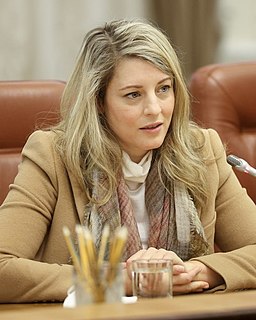
The Minister of Foreign Affairs is the minister of the Crown in the Canadian Cabinet who is responsible for overseeing the Government of Canada's international relations and is the lead minister responsible for Global Affairs Canada, though the minister of international trade leads on trade issues. In addition to Global Affairs Canada, the minister is also the lead in overseeing the International Centre for Human Rights and Democratic Development and the International Development Research Centre.
John Sculley, American businessman, co-founded Zeta Interactive births

John Sculley III is an American businessman, entrepreneur and investor in high-tech startups. Sculley was vice-president (1970–1977) and president of PepsiCo (1977–1983), until he became chief executive officer (CEO) of Apple Inc. on April 8, 1983, a position he held until leaving in 1993. In May 1987, Sculley was named Silicon Valley's top-paid executive, with an annual salary of US$10.2 million.
Zeta Global Holdings Corp. is a data-driven marketing technology company which was founded in 2007. Zeta offers companies a suite of multichannel marketing tools focused on creating, maintaining, and monetizing customer relationships.
Paul Daniels, English magician and television host (d. 2016) births

Newton Edward Daniels, known professionally as Paul Daniels, was an English magician and television presenter. He achieved international fame through his television series The Paul Daniels Magic Show, which ran on the BBC from 1979 to 1994.
Roy Thinnes, American television and film actor births
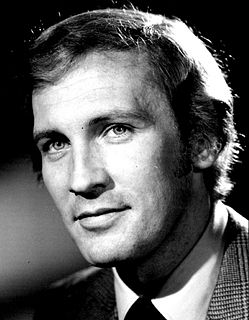
Roy Thinnes is an American television and film actor best known for his portrayal of lonely hero David Vincent in the ABC 1967–68 television series The Invaders.
Merle Haggard, American singer-songwriter and guitarist (d. 2016) births

Merle Ronald Haggard was an American country music singer, songwriter, guitarist, and fiddler.
Tom Veivers, Australian cricketer and politician births

Thomas Robert Veivers is an Australian former cricketer, teacher, politician and public administrator who played in 21 cricket Test matches between 1963 and 1967. He is the great-uncle of Jack Wildermuth.
Billy Dee Williams, American actor, singer, and writer births

William December Williams Jr. is an American actor. He appeared as Lando Calrissian in the Star Wars franchise, first in the early 1980s for The Empire Strikes Back (1980) and Return of the Jedi (1983), and thirty-six years later in The Rise of Skywalker (2019), marking one of the longest intervals between onscreen portrayals of a character by the same actor in American film history.
Helen Berman, Dutch-Israeli painter and illustrator births

Helen Berman is a Dutch-Israeli visual artist. She was a textile designer in the 1960s and has been a painter and occasionally an art educator since the 1970s. She is well known in Israel and has exhibited also in Germany and the Netherlands. She created modern and postmodern art and has engaged in realistic impressionism and lyrical abstract expressionism.
Jean-Pierre Changeux, French neuroscientist, biologist, and academic births
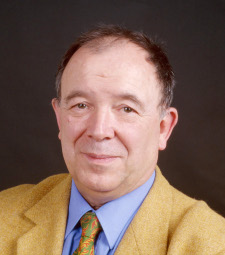
Jean-Pierre Changeux is a French neuroscientist known for his research in several fields of biology, from the structure and function of proteins, to the early development of the nervous system up to cognitive functions. Although being famous in biological sciences for the MWC model, the identification and purification of the nicotinic acetylcholine receptor and the theory of epigenesis by synapse selection are also notable scientific achievements. Changeux is known by the non-scientific public for his ideas regarding the connection between mind and physical brain. As put forth in his book, Conversations on Mind, Matter and Mathematics, Changeux strongly supports the view that the nervous system functions in a projective rather than reactive style and that interaction with the environment, rather than being instructive, results in the selection amongst a diversity of preexisting internal representations.
Douglas Hill, Canadian author and critic (d. 2007) births
Douglas Arthur Hill was a Canadian science fiction author, editor and reviewer. He was born in Brandon, Manitoba, the son of a railroad engineer, and was raised in Prince Albert, Saskatchewan. An avid science fiction reader from an early age, he studied English at the University of Saskatchewan and at the University of Toronto. He married fellow writer and U. of S. alumna Gail Robinson in 1958; they moved to Britain in 1959, where he worked as a freelance writer and editor for Aldus Books. In 1967–1968 he served as assistant editor of the controversial New Worlds science fiction magazine under Michael Moorcock.
Edwin Arlington Robinson, American poet and playwright (b. 1869) deaths

Edwin Arlington Robinson was an American poet and playwright. Robinson won the Pulitzer Prize for Poetry on three occasions and was nominated for the Nobel Prize in Literature four times.
Enrique Álvarez Félix, Mexican actor (d. 1996) births

Enrique Álvarez Félix was a Mexican actor, known for his roles in telenovelas and in films, such as The Monastery of the Vultures and The House of the Pelican.
Anton Geesink, Dutch martial artist and wrestler (d. 2010) births
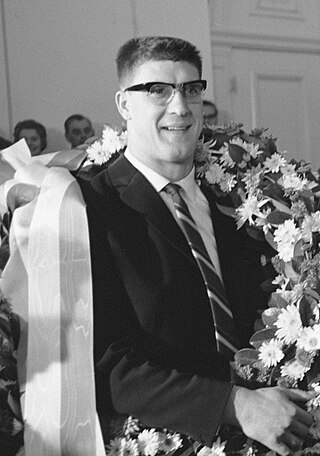
Antonius Johannes Geesink was a Dutch 10th dan judoka. He was the first non-Japanese judoka to win gold at the World Judo Championship, a feat he accomplished in 1961 and 1965. He was also an Olympic Champion, having won gold at the 1964 Summer Olympics in Japan, and won a record 21 European Judo Championships during his career.
Guy Peellaert, Belgian painter, illustrator, and photographer (d. 2008) births
Guy Peellaert was a Belgian artist, painter, illustrator, comic artist and photographer, most famous for the book Rock Dreams, and his album covers for rock artists like David Bowie and the Rolling Stones. He also designed film posters for films like Taxi Driver (1976), Paris, Texas (1984), and Short Cuts (1993). The band Frankie Goes to Hollywood took their name from Peellaert's painting, titled Frank Sinatra, which featured the headline "Frankie Goes Hollywood".
Roy Goode, English lawyer and academic births
Sir Royston Miles "Roy" Goode is an academic commercial lawyer in the United Kingdom. He founded the Centre for Commercial Law Studies at Queen Mary, University of London. He was awarded the OBE in 1972 followed by the CBE in 1994 before being knighted for services to academic law in 2000.
Tom C. Korologos, American journalist and diplomat, United States Ambassador to Belgium births
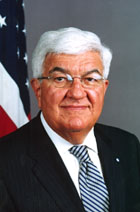
Tom Chris Korologos is an American former diplomat who served as the United States Ambassador to Belgium.

In 1832, shortly after the creation of the Kingdom of Belgium, the United States established diplomatic relations. Since that time, a long line of distinguished envoys have represented American interests in Belgium. These diplomats included men and women whose career paths would lead them to become Secretary of States, Secretary of Commerce and Chair of the Federal Trade Commission.
Eduardo Malapit, American lawyer and politician, Mayor of Kauai (d. 2007) births
Eduardo Enabore Malapit was an American Democratic politician who served as Mayor of Kauai, Hawaii. Elected for four consecutive two-year terms as mayor of Kauai beginning in 1974, he was the first Filipino American mayor of any United States municipality. He was widely respected in Kauai and throughout Hawaii for his belief in community service, and was known as "Mala" by friends and constituents.
The Mayor of Kauaʻi is the chief executive officer of the County of Kauaʻi in the state of Hawaiʻi. The mayor has municipal jurisdiction over the islands of Kauaʻi and Ni’ihau. Derek Kawakami was elected on November 6, 2018, as the mayor of Kauaʻi over JoAnn A. Yukimura, who was Kauaʻi's mayor from 1988 to 1992, with 15,857 votes out of 40,323 registered voters in the County of Kauaʻi. The Mayor of Kauaʻi is the successor of the Royal Governors of Kauaʻi of the Kingdom of Hawaii.
Connie Broden, Canadian ice hockey player (d. 2013) births

Thomas Connell Broden was a Canadian ice hockey forward. Broden is the only player to have won the International Ice Hockey Federation's World Championships and the Stanley Cup in the same year (1958).
Helmut Griem, German actor and director (d. 2004) births

Helmut Griem was a German film, television and stage actor, and director.
Ram Dass, American author and educator (d. 2019) births
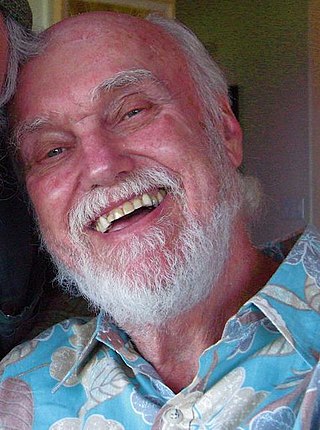
Ram Dass, also known as Baba Ram Dass, was an American spiritual teacher, guru of modern yoga, psychologist, and author. His best-selling 1971 book Be Here Now, which has been described by multiple reviewers as "seminal", helped popularize Eastern spirituality and yoga in the West. He authored or co-authored twelve more books on spirituality over the next four decades, including Grist for the Mill (1977), How Can I Help? (1985), and Polishing the Mirror (2013).
Ivan Dixon, American actor, director, and producer (d. 2008) births

Ivan Nathaniel Dixon III was an American actor, director, and producer best known for his series role in the 1960s sitcom Hogan's Heroes, and for his starring roles in the 1964 independent drama Nothing But a Man and the 1967 television film The Final War of Olly Winter. In addition, he directed many episodes of television series.
Willis Hall, English playwright and author (d. 2005) births

Willis Edward Hall was an English playwright and radio, television and film writer who drew on his working-class roots in Leeds for much of his writing. Willis formed an extremely prolific partnership with his life-long friend Keith Waterhouse producing over 250 works. He wrote plays such as Billy Liar, The Long and the Short and the Tall, and Celebration; the screenplays for Whistle Down the Wind, A Kind of Loving and Alfred Hitchcock's Torn Curtain; and television programmes including Budgie, Worzel Gummidge and Minder. His passion for musical theatre led to a string of hits, including Wind in the Willows, The Card, and George Stiles' and Anthony Drewe's Peter Pan: A Musical Adventure.
Joi Lansing, American model, actress and nightclub singer (d. 1972) births

Joi Lansing was an American model, film and television actress, and nightclub singer. She was noted for her pin-up photos and roles in B-movies, as well as a prominent role in the famous opening "tracking shot" in Orson Welles' 1958 crime drama Touch of Evil.
André Previn, American pianist, composer, and conductor (d. 2019) births

André George Previn was a German-American pianist, composer, and conductor. His career had three major genres: Hollywood films, jazz, and classical music. In each he achieved success, and the latter two were part of his life until the end. In movies, he arranged and composed music. In jazz, he was a celebrated trio pianist, a piano-accompanist to singers of standards, and pianist-interpreter of songs from the "Great American Songbook". In classical music, he also performed as a pianist but gained television fame as a conductor, and during his last thirty years created his legacy as a composer of art music.
Christos Sartzetakis, Greek jurist, supreme justice and President of Greece (d. 2022) births

Christos Sartzetakis was a Greek jurist and a supreme justice of the Court of Cassation, who served as the President of Greece from 1985 to 1990.

The president of Greece, officially the President of the Hellenic Republic, commonly referred to in Greek as the President of the Republic, is the head of state of Greece. The president is elected by the Hellenic Parliament; the role has been mainly ceremonial since the 1986 constitutional reform. The office was formally established by the Constitution of Greece in 1975, but has antecedents in the Second Hellenic Republic of 1924–1935 and the Greek junta in 1973–1974 which predated the transition to the current Third Hellenic Republic. The incumbent, since 13 March 2020, is Katerina Sakellaropoulou.
James Watson, American biologist, geneticist, and zoologist, Nobel Prize laureate births

James Dewey Watson is an American molecular biologist, geneticist, and zoologist. In 1953, he co-authored with Francis Crick the academic paper proposing the double helix structure of the DNA molecule. Watson, Crick and Maurice Wilkins were awarded the 1962 Nobel Prize in Physiology or Medicine "for their discoveries concerning the molecular structure of nucleic acids and its significance for information transfer in living material". In subsequent years, it has been recognized that Watson and his colleagues did not properly attribute colleague Rosalind Franklin for her contributions to the discovery of the double helix structure.

The Nobel Prize in Physiology or Medicine is awarded yearly by the Nobel Assembly at the Karolinska Institute for outstanding discoveries in physiology or medicine. The Nobel Prize is not a single prize, but five separate prizes that, according to Alfred Nobel's 1895 will, are awarded "to those who, during the preceding year, have conferred the greatest benefit to humankind". Nobel Prizes are awarded in the fields of Physics, Chemistry, Physiology or Medicine, Literature, and Peace.
Gerry Mulligan, American saxophonist, clarinet player, and composer (d. 1996) births

Gerald Joseph Mulligan, also known as Jeru, was an American jazz saxophonist, clarinetist, composer and arranger. Though primarily known as one of the leading jazz baritone saxophonists—playing the instrument with a light and airy tone in the era of cool jazz—Mulligan was also a significant arranger, working with Claude Thornhill, Miles Davis, Stan Kenton, and others. His pianoless quartet of the early 1950s with trumpeter Chet Baker is still regarded as one of the best cool jazz groups. Mulligan was also a skilled pianist and played several other reed instruments. Several of his compositions, such as "Walkin' Shoes" and "Five Brothers", have become standards.
Florence Earle Coates, American poet (b. 1850) deaths

Florence Van Leer Earle Nicholson Coates was an American poet, whose prolific output was published in many literary magazines, some of it set to music. She was mentored by the English poet Matthew Arnold, with whom she maintained a lifelong friendship. She was famous for her many nature-poems, inspired by the flora and fauna of the Adirondacks, where she lived. She was elected poet laureate of Pennsylvania by the state Federation of Women's Clubs in 1915.
Sergio Franchi, Italian-American singer and actor (d. 1990) births
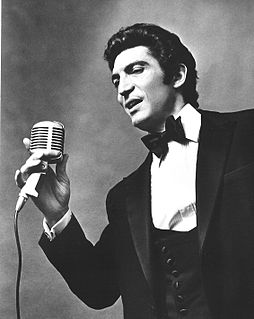
Sergio Franchi was an Italian-American tenor and actor who enjoyed success in the United States and internationally after gaining notice in Britain in the early 1960s. In 1962, RCA Victor signed him to a seven-year contract and in October of that year Franchi appeared on The Ed Sullivan Show and performed at Carnegie Hall. Sol Hurok managed Franchi's initial American concert tour.
Gil Kane, Latvian-American author and illustrator (d. 2000) births

Gil Kane was a Latvian-born American comics artist whose career spanned the 1940s to the 1990s and virtually every major comics company and character.
Ian Paisley, Northern Irish evangelical minister and politician, 2nd First Minister of Northern Ireland (d. 2014) births

Ian Richard Kyle Paisley, Baron Bannside, was a Northern Irish loyalist politician and Protestant religious leader who served as leader of the Democratic Unionist Party (DUP) from 1971 to 2008 and First Minister of Northern Ireland from 2007 to 2008.
The First Minister and deputy First Minister of Northern Ireland are the joint heads of government of the Northern Ireland Executive and have overall responsibility for the running of the Executive Office. Despite the different titles for the two offices, the two positions have the same governmental power, resulting in a duumvirate; the deputy First Minister is not subordinate to the First Minister. Created under the terms of the 1998 Good Friday Agreement, both were initially nominated and appointed by members of the Northern Ireland Assembly on a joint ticket by a cross-community vote, using consociational principles. That process was changed following the 2006 St Andrews Agreement, meaning that the First Minister is nominated by the largest party overall, and the deputy First Minister is nominated by the largest party in the next largest community designation.
Randy Weston, American jazz pianist and composer (d. 2018) births
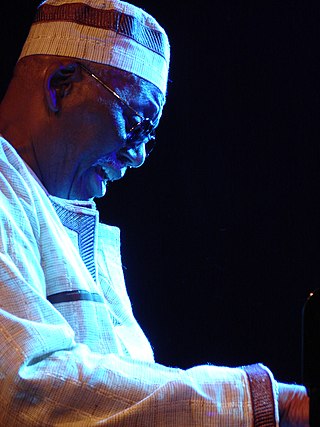
Randolph Edward "Randy" Weston was an American jazz pianist and composer whose creativity was inspired by his ancestral African connection.
Herb Thomas, American race car driver (d. 2000) births

Herbert Watson Thomas was a stock car racer who was one of NASCAR's most successful drivers in the 1950s. Thomas was NASCAR's first multi-time Cup Champion.
Gordon Chater, English-Australian comedian and actor (d. 1999) births
Gordon Maitland Chater AM was an English Australian comedian and actor, and recipient of the Gold Logie, he appeared in revue, theatre, radio, television and film, with a career spanning almost 50 years.
Wilbur Thompson, American shot putter (d. 2013) births

Wilbur Marvin "Moose" Thompson was an American shot putter who won a gold medal at the 1948 Summer Olympics.
Jack Cover, American pilot and physicist, invented the Taser gun (d. 2009) births

John Higson Cover Jr. was an American aerospace scientist who was the inventor of the Taser stun gun.

A taser is an electroshock weapon used to incapacitate people allowing them to be approached and handled in an unresisting and thus safe manner. It is sold by Axon, formerly TASER International. It fires two small barbed darts intended to puncture the skin and remain attached to the target, at 55 m/s. Their range extends from 4.5 m (15 ft) for non-Law Enforcement Tasers to 10.5 m (34 ft) for LE Tasers. The darts are connected to the main unit by thin insulated copper wire and deliver a modulated electric current designed to disrupt voluntary control of muscles, causing "neuromuscular incapacitation". The effects of a taser may only be localised pain or strong involuntary long muscle contractions, based on the mode of use and connectivity of the darts.
Edmond H. Fischer, Swiss-American biochemist and academic, Nobel Prize laureate (d. 2021) births
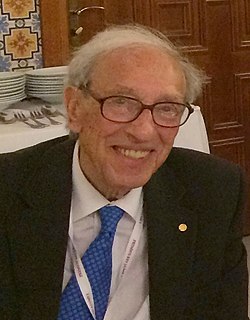
Edmond Henri Fischer was a Swiss-American biochemist. He and his collaborator Edwin G. Krebs were awarded the Nobel Prize in Physiology or Medicine in 1992 for describing how reversible phosphorylation works as a switch to activate proteins and regulate various cellular processes. From 2007 until 2014, he was the Honorary President of the World Cultural Council. At the time of his death at age 101 in 2021, he was the oldest living Nobel Prize laureate.

The Nobel Prize in Physiology or Medicine is awarded yearly by the Nobel Assembly at the Karolinska Institute for outstanding discoveries in physiology or medicine. The Nobel Prize is not a single prize, but five separate prizes that, according to Alfred Nobel's 1895 will, are awarded "to those who, during the preceding year, have conferred the greatest benefit to humankind". Nobel Prizes are awarded in the fields of Physics, Chemistry, Physiology or Medicine, Literature, and Peace.
Georgios Mylonas, Greek politician, 11th Greek Minister of Culture (d. 1998) births

Georgios Mylonas was a Greek Center Union politician and government minister. He was a close aide to Greek statesman and premier Georgios Papandreou, and was repeatedly elected deputy for the Ioannina seat with the Center Union. Mylonas had served as an undersecretary to the premier's office and education undersecretary from 1963 to 1965. He assumed the transport ministry in the first post-junta government in 1974 and was Minister for Culture from 1989 to 1990. Mylonas was the author of the book Escape From Amorgos, detailing his escape from the island, where he was exiled during the 1967-1974 military dictatorship. The escape was organized by his then, son-in-law Elias B.M. Kulukundris and his daughter Eleni Mylonas with the help of Maria Becket.
The Ministry of Culture and Sports is the government department of Greece entrusted with preserving the country's cultural heritage, promoting the arts, and overseeing sport through the subordinate General Secretariat for Sports. The incumbent minister is Lina Mendoni. The Deputy Minister for Modern Culture is Nicholas Yatromanolakis, and the Deputy Minister for Sports is Lefteris Avgenakis.
Alfredo Ovando Candía, Bolivian general and politician, 56th President of Bolivia (d. 1982) births

Alfredo Ovando Candía was the Commander of the Bolivian Air Forces and ambassador who served as the 48th president of Bolivia twice nonconsecutively, first as co-president with René Barrientos from 1965 to 1966 and then as de facto president from 1969 to 1970.
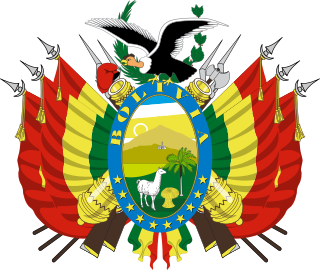
The president of Bolivia, officially known as the president of the Plurinational State of Bolivia, is head of state and head of government of Bolivia and the captain general of the Armed Forces of Bolivia.
Leonora Carrington, English-Mexican painter and author (d. 2011) births
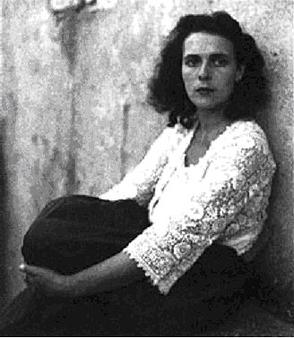
Mary Leonora Carrington was a British-born Mexican artist, surrealist painter, and novelist. She lived most of her adult life in Mexico City and was one of the last surviving participants in the surrealist movement of the 1930s. Carrington was also a founding member of the women's liberation movement in Mexico during the 1970s.
Phil Leeds, American actor (d. 1998) births

Phil Leeds was an American character actor. He is best known for appearing in many movies and television series, including guest appearances in The Dick Van Dyke Show, Maude, Friends, Barney Miller, The Golden Girls, Everybody Loves Raymond, and more.
Vincent Ellis McKelvey, American geologist and author (d. 1987) births

Vincent Ellis McKelvey was an American geologist and earth scientist. Recognized as an international authority on deep-sea mineral deposits, he spent 46 years with the United States Geological Survey. From 1968 to 1982, he served as scientific adviser and senior deputy to the United States delegation to the Law of the Sea Conference of the United Nations, where fellow delegates often depended on his ability to render complex scientific issues into plain English.
Tadeusz Kantor, Polish director, painter, and set designer (d. 1990) births

Tadeusz Kantor was a Polish painter, assemblage and Happenings artist, set designer and theatre director. Kantor is renowned for his revolutionary theatrical performances in Poland and abroad. Laureate of Witkacy Prize – Critics' Circle Award (1989).
Shannon Boyd-Bailey McCune, American geographer and academic (d. 1993) births

Shannon Boyd-Bailey McCune was an American geographer.
Somerset Lowry-Corry, 4th Earl Belmore (b. 1835) deaths
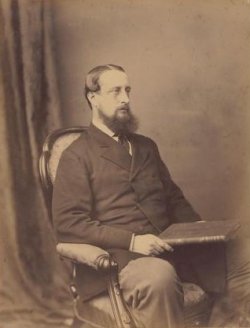
Somerset Richard Lowry-Corry, 4th Earl Belmore,, styled as Viscount Corry from 1841 to 1845, was an Irish nobleman and Conservative politician who served as Governor of New South Wales from 1868 to 1872.
Feodor Felix Konrad Lynen, German biochemist and academic, Nobel Prize laureate (d. 1979) births
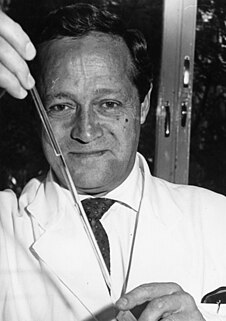
Feodor Felix Konrad Lynen was a German biochemist. In 1964 he won the Nobel Prize in Physiology or Medicine together with Konrad Bloch for their discoveries concerning the mechanism and regulation of cholesterol and fatty acid metabolism while he was director of the Max-Planck Institute for Cellular Chemistry in Munich.

The Nobel Prize in Physiology or Medicine is awarded yearly by the Nobel Assembly at the Karolinska Institute for outstanding discoveries in physiology or medicine. The Nobel Prize is not a single prize, but five separate prizes that, according to Alfred Nobel's 1895 will, are awarded "to those who, during the preceding year, have conferred the greatest benefit to humankind". Nobel Prizes are awarded in the fields of Physics, Chemistry, Physiology or Medicine, Literature, and Peace.
Barys Kit, Belarusian-American rocket scientist (d. 2018) births
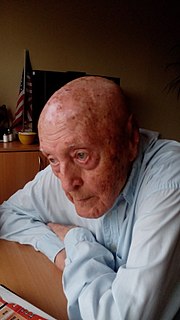
Boris Uladzimiravich Kit was a Belarusian-American rocket scientist.

Belarusian Americans are Americans who are of total or partial Belarusian ancestry.
William M. Branham, American minister and theologian (d. 1965) births

William Marrion Branham was an American Christian minister and faith healer who initiated the post–World War II healing revival, and claimed to be a prophet with the anointing of Elijah, who had come to prelude Christ's second coming; some of his followers have been labeled a "doomsday cult". He is credited as "a principal architect of restorationist thought" for charismatics by some Christian historians, and has been called the "leading individual in the Second Wave of Pentecostalism." He made a lasting influence on televangelism and the modern charismatic movement, and his "stage presence remains a legend unparalleled in the history of the Charismatic movement". At the time they were held, his inter-denominational meetings were the largest religious meetings ever held in some American cities. Branham was the first American deliverance minister to successfully campaign in Europe; his ministry reached global audiences with major campaigns held in North America, Europe, Africa, and India.
Hermann Lang, German race car driver (d. 1987) births

Hermann Lang was a German racing driver who raced motorcycles, Grand Prix cars, and sports cars.
Marcel-Marie Desmarais, Canadian preacher, missionary, and author (d. 1994) births
Marcel-Marie Desmarais,, was a Quebec writer, preacher and broadcaster. A member of the Roman Catholic Dominican Order, he became a personality through his popular books and radio and TV programs in Quebec. He was also sent as missionary to Brazil during the 1940s.
Alexander Kielland, Norwegian author, playwright, and politician, 6th County Governor of Møre og Romsdal (b. 1849) deaths

Alexander Lange Kielland was a Norwegian realistic writer of the 19th century. He is one of the so-called "The Four Greats" of Norwegian literature, along with Henrik Ibsen, Bjørnstjerne Bjørnson and Jonas Lie.
The county governor of Møre og Romsdal county in Norway represents the central government administration in the county. The office of county governor is a government agency of the Kingdom of Norway; the title was Amtmann, then Fylkesmann, and then Statsforvaltaren.
Kurt Georg Kiesinger, German lawyer, politician and Chancellor of Germany (d. 1988) births
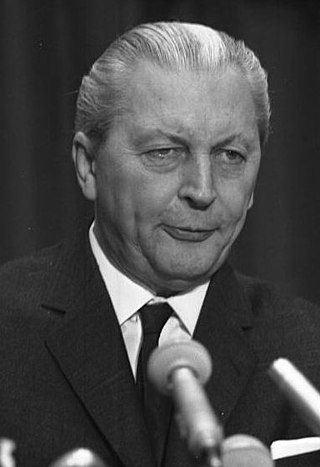
Kurt Georg Kiesinger was a German politician who served as the chancellor of West Germany from 1 December 1966 to 21 October 1969. Before he became Chancellor he served as Minister President of Baden-Württemberg from 1958 to 1966 and as President of the Federal Council from 1962 to 1963. He was Chairman of the Christian Democratic Union from 1967 to 1971.

The chancellor of Germany, officially the federal chancellor of the Federal Republic of Germany, is the head of the federal government of Germany and the commander in chief of the German Armed Forces during wartime. The chancellor is the chief executive of the Federal Cabinet and heads the executive branch. The chancellor is elected by the Bundestag on the proposal of the federal president and without debate.
Erwin Komenda, Austrian car designer and engineer (d. 1966) births
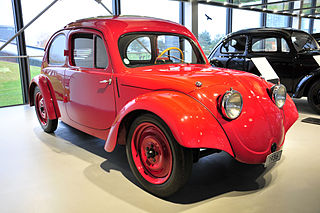
Erwin Komenda was an Austrian automobile designer and Porsche employee, and a lead contributor to the design of the bodies for the VW Beetle and various Porsche sports cars.
Mickey Cochrane, American baseball player and manager (d. 1962) births
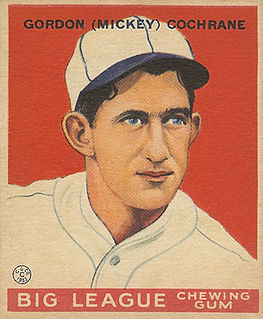
Gordon Stanley "Mickey" Cochrane, nicknamed "Black Mike", was an American professional baseball player, manager and coach. He played in Major League Baseball as a catcher for the Philadelphia Athletics and Detroit Tigers. Cochrane was considered one of the best catchers in baseball history and is a member of the Baseball Hall of Fame. In his first season as manager, he led the Tigers to 101 wins, which was the most for a rookie manager for 27 years.
Harold Eugene Edgerton, American engineer and academic (d. 1990) births

Harold Eugene "Doc" Edgerton, also known as Papa Flash, was an American scientist and researcher, a professor of electrical engineering at the Massachusetts Institute of Technology. He is largely credited with transforming the stroboscope from an obscure laboratory instrument into a common device. He also was deeply involved with the development of sonar and deep-sea photography, and his equipment was used by Jacques Cousteau in searches for shipwrecks and even the Loch Ness Monster.
Julien Torma, French author, poet, and playwright (d. 1933) births
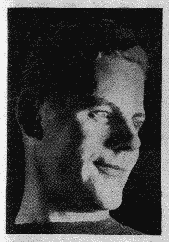
Julien Torma was credited as a French writer, playwright and poet who was part of the Dadaist movement.
Pier Giorgio Frassati, Italian activist (d. 1925) births

Pier Giorgio Frassati was an Italian Catholic activist and a member from the Third Order of Saint Dominic. He was dedicated to social justice issues and joined several charitable organizations, including Catholic Action and the Society of Saint Vincent de Paul, to better aid the poor and less fortunate living in his hometown of Turin; he put his own pious beliefs into practice to cater to their needs and was best known for his devotion and amiable character.
Leo Robin, American composer and songwriter (d. 1984) births
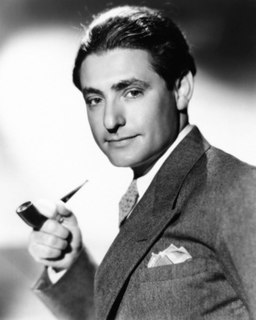
Leo Robin was an American composer, lyricist and songwriter. He is probably best known for collaborating with Ralph Rainger on the 1938 Oscar-winning song "Thanks for the Memory," sung by Bob Hope and Shirley Ross in the film The Big Broadcast of 1938, and with Jule Styne on "Diamonds Are a Girl's Best Friend," a song whose witty, Cole Porter style of lyric came to be identified with its famous interpreter Marilyn Monroe.
Alvan Wentworth Chapman, American physician and botanist (b. 1809) deaths

Alvan Wentworth Chapman was an American physician and pioneering botanist in the study of flora of the American Southeast. He wrote Flora of the Southern United States, the first comprehensive description of US plants in any region beyond the northeastern states.
Jeanne Hébuterne, French painter and author (d. 1920) births

Jeanne Hébuterne was a French painter and art model best known as the frequent subject and common-law wife of the artist Amedeo Modigliani. She took her own life the day after Modigliani died, and is now buried beside him.
Dudley Nichols, American director, producer, and screenwriter (d. 1960) births
Dudley Nichols was an American screenwriter and film director. He was the first person to decline an Academy Award, as part of a boycott to gain recognition for the Screen Writers Guild; he would later accept his Academy Award for Best Original Screenplay in 1938.
Donald Wills Douglas, Sr., American businessman, founded the Douglas Aircraft Company (d. 1981) births

Donald Wills Douglas Sr. was an American aircraft industrialist and engineer.

The Douglas Aircraft Company was an American aerospace manufacturer based in Southern California. It was founded in 1921 by Donald Wills Douglas Sr. and later merged with McDonnell Aircraft in 1967 to form McDonnell Douglas; it then operated as a division of McDonnell Douglas. McDonnell Douglas later merged with Boeing in 1997.
Lowell Thomas, American journalist and author (d. 1981) births

Lowell Jackson Thomas was an American writer, actor, broadcaster, and traveler, best remembered for publicising T. E. Lawrence. He was also involved in promoting the Cinerama widescreen system. In 1954, he led a group of New York City-based investors to buy majority control of Hudson Valley Broadcasting, which, in 1957, became Capital Cities Television Corporation.
Anthony Fokker, Dutch engineer and businessman, founded Fokker Aircraft Manufacturer (d. 1939) births

Anton Herman Gerard "Anthony" Fokker was a Dutch aviation pioneer, aviation entrepreneur, aircraft designer, and aircraft manufacturer. He produced fighter aircraft in Germany during the First World War such as the Eindecker monoplanes, the Dr.1 triplane and the D.VII biplane.
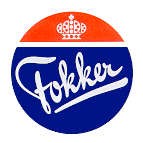
Fokker was a Dutch aircraft manufacturer named after its founder, Anthony Fokker. The company operated under several different names. It was founded in 1912 in Berlin, Germany, and became famous for its fighter aircraft in World War I. After the war, it moved to the Netherlands in 1919.
Hans Richter, Swiss painter, illustrator, and director (d. 1976) births

Hans Richter was a German Dada painter, graphic artist, avant-garde film producer, and art historian. In 1965 he authored the book Dadaism about the history of the Dada movement. He was born in Berlin into a well-to-do family and died in Minusio, near Locarno, Switzerland.
Gerhard Ritter, German historian and academic (d. 1967) births
Gerhard Georg Bernhard Ritter was a nationalist-conservative German historian, who served as a professor of history at the University of Freiburg from 1925 to 1956. He studied under Professor Hermann Oncken. A Lutheran, he first became well known for his 1925 biography of Martin Luther and hagiographic portrayal of Prussia. A member of the German People's Party during the Weimar Republic, he was a lifelong monarchist and remained sympathetic to the political system of the defunct German Empire.
Athenagoras I of Constantinople (d. 1972) births

Athenagoras I, born Aristocles Matthaiou Spyrou, initially the Greek archbishop in North America, was the 268th Ecumenical Patriarch of Constantinople, from 1948 to 1972.
Walter Dandy, American physician and neurosurgeon (d. 1946) births
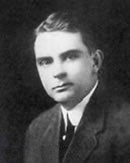
Walter Edward Dandy was an American neurosurgeon and scientist. He is considered one of the founding fathers of neurosurgery, along with Victor Horsley (1857–1916) and Harvey Cushing (1869–1939). Dandy is credited with numerous neurosurgical discoveries and innovations, including the description of the circulation of cerebrospinal fluid in the brain, surgical treatment of hydrocephalus, the invention of air ventriculography and pneumoencephalography, the description of brain endoscopy, the establishment of the first intensive care unit, and the first clipping of an intracranial aneurysm, which marked the birth of cerebrovascular neurosurgery.
Osman Ali Khan, Asaf Jah VII, Indian ruler (d. 1967) births

Mir Osman Ali Khan, Asaf Jah VII, was the last Nizam (ruler) of the Princely State of Hyderabad, the largest princely state in British India. He ascended the throne on 29 August 1911, at the age of 25 and ruled the Kingdom of Hyderabad between 1911 and 1948, until India annexed it. He was styled as His Exalted Highness-(H.E.H) the Nizam of Hyderabad, and was widely considered as one of the world's wealthiest person of all time. With some estimate placing his wealth at 2% of U.S. GDP, his portrait was on the cover of Time magazine in 1937. As a semi-autonomous monarch, he had his own mint, printing his own currency, the Hyderabadi rupee, and had a private treasury that was said to contain £100 million in gold and silver bullion, and a further £400 million of jewels. The major source of his wealth was the Golconda mines, the only supplier of diamonds in the world at that time. Among them was the Jacob Diamond, valued at some £50 million, and used by the Nizam as a paperweight.
William Edward Forster, English businessman, philanthropist, and politician, Chief Secretary for Ireland (b. 1818) deaths

William Edward Forster, PC, FRS was an English industrialist, philanthropist and Liberal Party statesman. His staunch advocacy of lethal force against the Land League earned him the nickname Buckshot Forster.
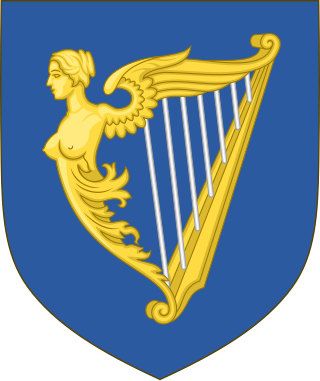
The Chief Secretary for Ireland was a key political office in the British administration in Ireland. Nominally subordinate to the Lord Lieutenant, and officially the "Chief Secretary to the Lord Lieutenant", from the early 19th century until the end of British rule he was effectively the government minister with responsibility for governing Ireland, roughly equivalent to the role of a Secretary of State, such as the similar role of Secretary of State for Scotland. Usually it was the Chief Secretary, rather than the Lord Lieutenant, who sat in the British Cabinet. The Chief Secretary was ex officio President of the Local Government Board for Ireland from its creation in 1872.
J. G. Parry-Thomas, Welsh race car driver and engineer (d. 1927) births

John Godfrey Parry-Thomas was a Welsh engineer and motor-racing driver who at one time held the land speed record. He was the first driver to be killed in pursuit of the land speed record.
Benjamin Wright Raymond, American merchant and politician, 3rd Mayor of Chicago (b. 1801) deaths

Benjamin Wright Raymond was an American politician who twice served as mayor of Chicago, Illinois for the Whig Party.

The mayor of Chicago is the chief executive of city government in Chicago, Illinois, the third-largest city in the United States. The mayor is responsible for the administration and management of various city departments, submits proposals and recommendations to the Chicago City Council, is active in the enforcement of the city's ordinances, submits the city's annual budget and appoints city officers, department commissioners or directors, and members of city boards and commissions.
Karl Staaf, Swedish pole vaulter and hammer thrower (d. 1953) births
Karl Gustaf Vilhelm Staaf was a Swedish track and field athlete and tug of war competitor who competed at the 1900 Summer Olympics. He was born in Stockholm and died in Motala.
Erich Mühsam, German author, poet, and playwright (d. 1934) births

Erich Mühsam was a German-Jewish antimilitarist anarchist essayist, poet and playwright. He emerged at the end of World War I as one of the leading agitators for a federated Bavarian Soviet Republic, for which he served 5 years in prison.
Levon Shant, Armenian author, poet, and playwright (d. 1951) births

Levon Shant was an Armenian playwright, novelist, poet and founder of the Hamazkayin Armenian Educational and Cultural Society.
Felix-Raymond-Marie Rouleau, Canadian cardinal (d. 1931) births

Félix-Raymond-Marie Rouleau was a Canadian Cardinal of the Roman Catholic Church. He served as Archbishop of Quebec from 1926 until his death, and was elevated to the cardinalate in 1927.
William Bate Hardy, English biologist and academic (d. 1934) births

Sir William Bate Hardy, FRS was a British biologist and food scientist. The William Bate Hardy Prize is named in his honour.
Albert Sidney Johnston, American general (b. 1803) deaths

Albert Sidney Johnston served as a general in three different armies: the Texian Army, the United States Army, and the Confederate States Army. He saw extensive combat during his 34-year military career, fighting actions in the Black Hawk War, the Texas War of Independence, the Mexican–American War, the Utah War, and the American Civil War.
Stanislas de Guaita, French poet and author (d. 1897) births

Stanislas De Guaita was a French poet based in Paris, an expert on esotericism and European mysticism, and an active member of the Rosicrucian Order. He was very celebrated and successful in his time. He had many disputes with other people who were involved with occultism and magic. Occultism and magic were part of his novels.
René Lalique, French sculptor and jewellery designer (d. 1945) births
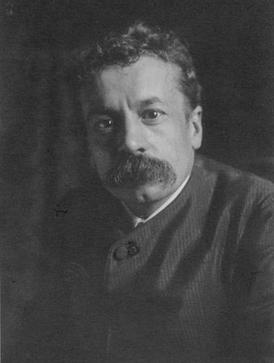
René Jules Lalique was a French jeweller, medallist,and glass designer known for his creations of glass art, perfume bottles, vases, jewellery, chandeliers, clocks, and automobile hood ornaments.
James Kirke Paulding, American author and politician, 11th United States Secretary of the Navy (b. 1778) deaths

James Kirke Paulding was an American writer and, for a time, the United States Secretary of the Navy. Paulding's early writings were satirical and violently anti-British, as shown in The Diverting History of John Bull and Brother Jonathan (1812). He wrote numerous long poems and serious histories. Among his novels are Konigsmarke, the Long Finne (1823) and The Dutchman's Fireside (1831). He is best known for creating the inimitable Nimrod Wildfire, the “half horse, half alligator” in The Lion of the West (1831), and as collaborator with William Irving and Washington Irving in Salmagundi. (1807–08). Paulding was also, by the mid-1830s, an ardent and outspoken defender of slavery, and he later endorsed southern secession from the union.

The secretary of the Navy is a statutory officer and the head of the Department of the Navy, a military department within the United States Department of Defense.
Arthur Wesley Dow, American painter and photographer (d. 1922) births

Arthur Wesley Dow was an American painter, printmaker, photographer and an arts educator.
Charles Huot, Canadian painter and illustrator (d. 1930) births

Charles Édouard Masson Huot was a French-Canadian painter and illustrator.
Will Crooks, English trade unionist and politician (d. 1921) births

William Crooks was a noted trade unionist and politician from Poplar, London, and a member of the Fabian Society. He is particularly remembered for his campaigning work against poverty and inequality.
Guillaume Bigourdan, French astronomer and academic (d. 1932) births

Camille Guillaume Bigourdan was a French astronomer.
William Lyne, Australian politician, 13th Premier of New South Wales (d. 1913) births

Sir William John Lyne KCMG was an Australian politician who served as Premier of New South Wales from 1899 to 1901, and later as a federal cabinet minister under Edmund Barton and Alfred Deakin. He is best known as the subject of the so called "Hopetoun Blunder", unexpectedly being asked to serve as the first Prime Minister of Australia but proving unable to form a government.

The premier of New South Wales is the head of government in the state of New South Wales, Australia. The Government of New South Wales follows the Westminster Parliamentary System, with a Parliament of New South Wales acting as the legislature. The premier is appointed by the governor of New South Wales, and by modern convention holds office by his or her ability to command the support of a majority of members of the lower house of Parliament, the Legislative Assembly.
José Bonifácio de Andrada, Brazilian poet, academic, and politician (b. 1763) deaths

José Bonifácio de Andrada e Silva was a Brazilian statesman, naturalist, mineralist, professor and poet, born in Santos, São Paulo, then part of the Portuguese Empire. He was one of the most important mentors of Brazilian independence, and his actions were decisive for the success of Emperor Pedro I. He supported public education, was an abolitionist and suggested that a new national capital be created in Brazil's underdeveloped interior. His career as naturalist was marked by the discovery of four new minerals.
Adamantios Korais, Greek philosopher and scholar (b. 1748) deaths

Adamantios Korais or Koraïs was a Greek scholar credited with laying the foundations of modern Greek literature and a major figure in the Greek Enlightenment. His activities paved the way for the Greek War of Independence and the emergence of a purified form of the Greek language, known as Katharevousa. Encyclopædia Britannica asserts that "his influence on the modern Greek language and culture has been compared to that of Dante on Italian and Martin Luther on German".
Niels Henrik Abel, Norwegian mathematician and theorist (b. 1802) deaths

Niels Henrik Abel was a Norwegian mathematician who made pioneering contributions in a variety of fields. His most famous single result is the first complete proof demonstrating the impossibility of solving the general quintic equation in radicals. This question was one of the outstanding open problems of his day, and had been unresolved for over 250 years. He was also an innovator in the field of elliptic functions, discoverer of Abelian functions. He made his discoveries while living in poverty and died at the age of 26 from tuberculosis.
Nikolis Apostolis, Greek naval commander during the Greek War of Independence (b. 1770) deaths

Nikolis Apostolis was a Greek naval commander during the Greek War of Independence. Apostolis was born on the island of Psara in 1770. He was initiated into the Filiki Eteria in 1818. When the revolt against the Ottoman Empire broke out in 1821, he took part in the naval struggles at the head of the Psarian squadron. Apostolis continued the struggle even after his native Psara was attacked and sacked by the Turks in 1824. He helped supply the army and people of Messolonghi by running through the Ottoman blockade during the final siege of that city. He died in Aegina on April 6, 1827.
Gustave Moreau, French painter and academic (d. 1898) births
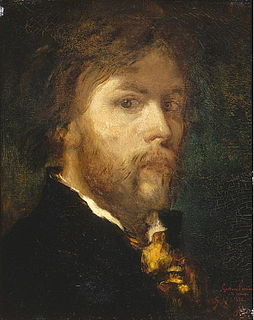
Gustave Moreau was a French artist and an important figure in the Symbolist movement. Jean Cassou called him "the Symbolist painter par excellence". He was an influential forerunner of symbolism in the visual arts in the 1860s, and at the height of the symbolist movement in the 1890s, he was among the most significant painters. Art historian Robert Delevoy wrote that Moreau "brought symbolist polyvalence to its highest point in Jupiter and Semele." He was a prolific artist who produced over 15,000 paintings, watercolors, and drawings. Moreau painted allegories and traditional biblical and mythological subjects favored by the fine art academies. J. K. Huysmans wrote, "Gustave Moreau has given new freshness to dreary old subjects by a talent both subtle and ample: he has taken myths worn out by the repetitions of centuries and expressed them in a language that is persuasive and lofty, mysterious and new." The female characters from the Bible and mythology that he so frequently depicted came to be regarded by many as the archetypical symbolist woman. His art fell from favor and received little attention in the early 20th century but, beginning in the 1960s and 70s, he has come to be considered among the most paramount of symbolist painters.
Vladimir Borovikovsky, Ukrainian-Russian painter and educator (b. 1757) deaths

Vladimir Lukich Borovikovsky was a prominent Russian Imperial artist of Ukrainian Cossack background, who served at the court of Catherine the Great and dominated portraiture in the Russian Empire at the turn of the 19th century.
George Waterhouse, English-New Zealand politician, 7th Prime Minister of New Zealand (d. 1906) births

George Marsden Waterhouse was a Premier of South Australia from 8 October 1861 until 3 July 1863 and the seventh premier of New Zealand from 11 October 1872 to 3 March 1873.

The prime minister of New Zealand is the head of government of New Zealand. The incumbent prime minister, Jacinda Ardern, leader of the New Zealand Labour Party, took office on 26 October 2017.
Joseph Medill, Canadian-American publisher and politician, 26th Mayor of Chicago (d. 1899) births

Joseph Medill was a Canadian-American newspaper editor, publisher, and Republican Party politician. He was co-owner and managing editor of the Chicago Tribune, and he was Mayor of Chicago from after the Great Chicago Fire of 1871 until 1873.

The mayor of Chicago is the chief executive of city government in Chicago, Illinois, the third-largest city in the United States. The mayor is responsible for the administration and management of various city departments, submits proposals and recommendations to the Chicago City Council, is active in the enforcement of the city's ordinances, submits the city's annual budget and appoints city officers, department commissioners or directors, and members of city boards and commissions.
Nadar, French photographer, journalist, and author (d. 1910) births
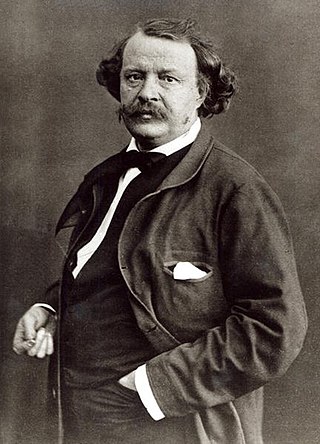
Gaspard-Félix Tournachon, known by the pseudonym Nadar, was a French photographer, caricaturist, journalist, novelist, balloonist, and proponent of heavier-than-air flight. In 1858, he became the first person to take aerial photographs.
Aasmund Olavsson Vinje, Norwegian journalist and poet (d. 1870) births

Aasmund Olavsson Vinje was a Norwegian poet and journalist who is remembered for poetry, travel writing, and his pioneering use of Landsmål.
Robert Volkmann, German organist, composer, and conductor (d. 1883) births

Friedrich Robert Volkmann was a German composer.
Alexander Herzen, Russian philosopher and author (d. 1870) births
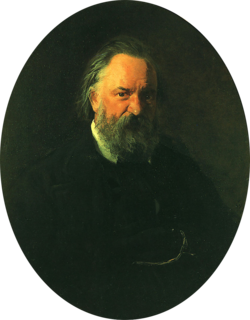
Alexander Ivanovich Herzen was a Russian writer and thinker known as the "father of Russian socialism" and one of the main fathers of agrarian populism. With his writings, many composed while exiled in London, he attempted to influence the situation in Russia, contributing to a political climate that led to the emancipation of the serfs in 1861. He published the important social novel Who is to Blame? (1845–46). His autobiography, My Past and Thoughts, is often considered one of the best examples of that genre in Russian literature.
Philip Henry Gosse, English biologist and academic (d. 1888) births

Philip Henry Gosse FRS, known to his friends as Henry, was an English naturalist and populariser of natural science, an early improver of the seawater aquarium, and a painstaking innovator in the study of marine biology. Gosse created and stocked the first public aquarium at the London Zoo in 1853, and coined the term "aquarium" when he published the first manual, The Aquarium: An Unveiling of the Wonders of the Deep Sea, in 1854. His work was the catalyst for an aquarium craze in early Victorian England.
Louis IX, Landgrave of Hesse-Darmstadt (b. 1719) deaths
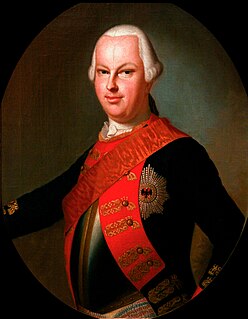
Louis IX of Hesse-Darmstadt was the reigning Landgrave of Hesse-Darmstadt from 1768 to 1790.
Celestina Cordero, Puerto Rican educator (d. 1862) births
Celestina Cordero, was an educator who in 1820 founded the first school for girls in San Juan, Puerto Rico.
James Mill, Scottish historian, economist, and philosopher (d. 1836) births

James Mill was a Scottish historian, economist, political theorist, and philosopher. He is counted among the founders of the Ricardian school of economics. He also wrote The History of British India (1817) and was one of the prominent historians to take colonial approach. He was the first writer to divide Indian history into three parts: Hindu, Muslim and British, a classification which has proved surpassingly influential in the field of Indian historical studies.
Wilhelm von Kobell, German painter and educator (d. 1853) births

Wilhelm von Kobell was a German painter, printmaker and teacher.
Richard Rawlinson, English minister and historian (b. 1690) deaths

Richard Rawlinson FRS was an English clergyman and antiquarian collector of books and manuscripts, which he bequeathed to the Bodleian Library, Oxford.
Nicolas Chamfort, French author and playwright (d. 1794) births

Sébastien-Roch Nicolas, known in his adult life as Nicolas Chamfort and as Sébastien Nicolas de Chamfort, was a French writer, best known for his epigrams and aphorisms. He was secretary to Louis XVI's sister, and of the Jacobin club.
Gerard Majella, Italian saint (d. 1755) births

Gerard Majella was an Italian lay brother of the Congregation of the Redeemer, better known as the Redemptorists, who is honored as a saint by the Catholic Church.
Pasquale Paoli, French soldier and politician (d. 1807) births

Filippo Antonio Pasquale de' Paoli was a Corsican patriot, statesman, and military leader who was at the forefront of resistance movements against the Genoese and later French rule over the island. He became the President of the Executive Council of the General Diet of the People of Corsica and wrote the Constitution of the state.
Johann Georg Reutter, Austrian organist and composer (d. 1772) births

Johann Adam Joseph Karl Georg Reutter, during his life known as Georg Reutter the Younger was an Austrian composer. According to David Wyn Jones, in his prime he was "the single most influential musician in Vienna".
Willem van de Velde the Younger, Dutch-English painter (b. 1633) deaths

Willem van de Velde the Younger was a Dutch marine painter, the son of Willem van de Velde the Elder, who also specialised in maritime art. His brother, Adriaen van de Velde, was a landscape painter.
Louis de Cahusac, French playwright and composer (d. 1759) births

Louis de Cahusac was an 18th-century French playwright and librettist, and Freemason, most famous for his work with the composer Jean-Philippe Rameau. He provided the libretti for several of Rameau's operas, namely Les fêtes de l'Hymen et de l'Amour (1747), Zaïs (1748), Naïs (1749), Zoroastre, La naissance d'Osiris (1754), and Anacréon. He is also credited with writing the libretto of Rameau's final work, Les Boréades. Cahusac contributed to the Encyclopédie and was the lover of Marie Fel.
Arthur Annesley, 1st Earl of Anglesey, Irish-English politician (b. 1614) deaths

Arthur Annesley, 1st Earl of Anglesey PC was an Anglo-Irish royalist statesman. After short periods as President of the Council of State and Treasurer of the Navy, he served as Lord Privy Seal between 1673 and 1682 for Charles II. He succeeded his father as 2nd Viscount Valentia in 1660, and he was created Earl of Anglesey in 1661.
John Winthrop the Younger, English politician, 1st Governor of Connecticut (b. 1606) deaths

John Winthrop the Younger was an early governor of the Connecticut Colony, and he played a large role in the merger of several separate settlements into the unified colony.

The territory of the United States state of Connecticut was first settled by Europeans in the 1620s, when Dutch traders established trading posts on the Connecticut River. English settlers, mainly Puritans fleeing repression in England, began to arrive in the 1630s, and a number of separate colonies were established. The first was the Saybrook Colony in 1635, based at the mouth of the Connecticut; it was followed by the Connecticut Colony and the New Haven Colony. The Saybrook Colony merged with the Connecticut Colony in 1644, and the New Haven Colony was merged into Connecticut between 1662 and 1665 after Connecticut received a royal charter.
André Cardinal Destouches, French composer (d. 1749) births

André Cardinal Destouches was a French composer best known for the opéra-ballet Les élémens.
Jean-Baptiste Rousseau, French poet and playwright (d. 1741) births
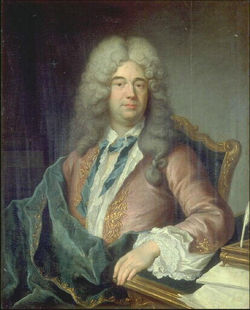
Jean-Baptiste Rousseau was a French playwright and poet, particularly noted for his cynical epigrams.
Leonora Baroni, Italian composer (b. 1611) deaths

Leonora Baroni was an Italian singer, theorbist, lutenist, viol player, and composer.
Arvid Horn, Swedish general and politician, Governor of Västerbotten County (d. 1742) births
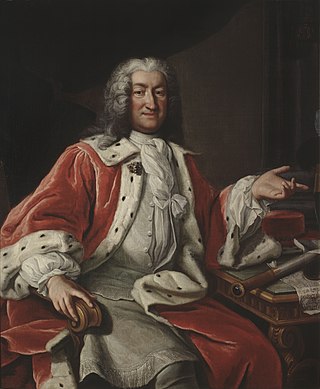
Count Arvid Bernhard Horn af Ekebyholm was a Swedish general, diplomat and politician, a member of the noble Horn family. He served twice as President of the Privy Council Chancellery and was one of the leading figures of the Swedish Age of Liberty.

This is a list of governors of Västerbotten County in Sweden, from 1598–present. This list is incomplete.
Johann Kuhnau, German organist and composer (d. 1722) births

Johann Kuhnau was a German polymath, known primarily as a composer today. He was also active as a novelist, translator, lawyer, and music theorist, and was able to combine these activities with his duties in his official post as Thomaskantor in Leipzig, which he occupied for 21 years. Much of his music, including operas, masses, and other large-scale vocal works, is lost. His reputation today rests on his Biblical Sonatas, a set of programmatic keyboard sonatas published in 1700, in which each sonata depicted in detail a particular story from the Bible. After his death, Kuhnau was succeeded as Thomaskantor by Johann Sebastian Bach.
David Blondel, French minister, historian, and scholar (b. 1591) deaths

David Blondel was a French Protestant clergyman, historian and classical scholar.
André Dacier, French scholar and academic (d. 1722) births

André Dacier was a French classical scholar and editor of texts. He began his career with an edition and commentary of Festus' De verborum significatione, and was the first to produce a "readable" text of the 20-book work. His wife was the influential classical scholar and translator, Anne Dacier.
Domenico Zampieri (Domenichino), Italian painter (b. 1581) deaths

Domenico Zampieri, known by the diminutive Domenichino after his shortness, was an Italian Baroque painter of the Bolognese School of painters.
Maria Leopoldine of Austria (d. 1649) births

Maria Leopoldine of Austria-Tyrol, was by birth Archduchess of Austria and member of the Tyrolese branch of the House of Habsburg and by marriage the second spouse of her first cousin, Holy Roman Emperor Ferdinand III. As such, she was Empress of the Holy Roman Empire, German Queen and Queen consort of Hungary and Bohemia. She died in childbirth.
Edward Seymour, 1st Earl of Hertford (b. 1539) deaths

Edward Seymour, 1st Earl of Hertford, 1st Baron Beauchamp, KG, of Wulfhall and Totnam Lodge in Great Bedwyn, Wiltshire, of Hatch Beauchamp in Somerset, of Netley Abbey, Hampshire, and of Hertford House, Cannon Row in Westminster, is most noted for incurring the displeasure of Queen Elizabeth I by taking part in more than one clandestine marriage.
John Stow, English historian and author (b. 1525) deaths

John Stow was an English historian and antiquarian. He wrote a series of chronicles of English history, published from 1565 onwards under such titles as The Summarie of Englyshe Chronicles, The Chronicles of England, and The Annales of England; and also A Survey of London. A. L. Rowse has described him as "one of the best historians of that age; indefatigable in the trouble he took, thorough and conscientious, accurate – above all things devoted to truth".
Henry Barrowe, English Puritan and separatist (b. 1550) deaths
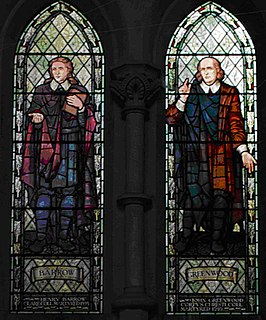
Henry Barrow was an English Separatist Puritan, or Brownist, executed for his views. He led the London Underground Church from 1587 to 1593, spending most of that time in prison, and wrote numerous works of Brownist apologetics, most notably A Brief Discoverie of the False Church.
Francis Walsingham, English politician and diplomat, Chancellor of the Duchy of Lancaster (b. 1532) deaths

Sir Francis Walsingham was principal secretary to Queen Elizabeth I of England from 20 December 1573 until his death and is popularly remembered as her "spymaster".

The chancellor of the Duchy of Lancaster is a ministerial office in the Government of the United Kingdom. The position is currently sixth in the ministerial ranking and is the second highest ranking minister in the Cabinet Office, immediately after the Prime Minister, and senior to the Minister for the Cabinet Office. The role includes as part of its duties the administration of the estates and rents of the Duchy of Lancaster.
Margaret of Brunswick-Lüneburg, German noble (d. 1643) births

Margaret of Brunswick-Lüneburg, was a German noblewoman member of the House of Welf and by marriage Duchess of Saxe-Coburg.
John Hamilton, Scottish archbishop and academic (b. 1512) deaths
John Hamilton, Scottish prelate and politician, was an illegitimate son of The 1st Earl of Arran.
Joachim Vadian, Swiss scholar and politician (b. 1484) deaths

Joachim Vadian, born as Joachim von Watt, was a humanist, scholar, mayor and reformer in St. Gallen, Switzerland.
Albrecht Dürer, German painter, engraver, and mathematician (b. 1471) deaths

Albrecht Dürer, sometimes spelled in English as Durer or Duerer, was a German painter, printmaker, and theorist of the German Renaissance. Born in Nuremberg, Dürer established his reputation and influence across Europe in his twenties due to his high-quality woodcut prints. He was in contact with the major Italian artists of his time, including Raphael, Giovanni Bellini, and Leonardo da Vinci, and from 1512 was patronized by Emperor Maximilian I.
Henry Stafford, 1st Earl of Wiltshire, English nobleman (b. 1479) deaths

Henry Stafford, 1st Earl of Wiltshire was an English peer.
Raphael, Italian painter and architect (b. 1483) deaths

Raffaello Sanzio da Urbino, better known as Raphael, was an Italian painter and architect of the High Renaissance. His work is admired for its clarity of form, ease of composition, and visual achievement of the Neoplatonic ideal of human grandeur. Together with Leonardo da Vinci and Michelangelo, he forms the traditional trinity of great masters of that period.
Matthias Corvinus, King of Hungary and Croatia from 1458 to 1490 (b. 1443) deaths

Matthias Corvinus, also called Matthias I, was King of Hungary and Croatia from 1458 to 1490. After conducting several military campaigns, he was elected King of Bohemia in 1469 and adopted the title Duke of Austria in 1487. He was the son of John Hunyadi, Regent of Hungary, who died in 1456. In 1457, Matthias was imprisoned along with his older brother, Ladislaus Hunyadi, on the orders of King Ladislaus the Posthumous. Ladislaus Hunyadi was executed, causing a rebellion that forced King Ladislaus to flee Hungary. After the King died unexpectedly, Matthias's uncle Michael Szilágyi persuaded the Estates to unanimously proclaim the 14-year-old Matthias as king on 24 January 1458. He began his rule under his uncle's guardianship, but he took effective control of government within two weeks.

The King of Hungary was the ruling head of state of the Kingdom of Hungary from 1000 to 1918. The style of title "Apostolic King of Hungary" was endorsed by Pope Clement XIII in 1758 and used afterwards by all Monarchs of Hungary.
This is a complete list of rulers of Croatia under domestic ethnic and elected dynasties during the Croatian Kingdom (925–1918). This article follows the monarch's title number according to Hungarian succession for convenience. For example, the Hungarian monarch Béla IV is according to Croatian succession correctly titled Béla III. This is because Hungarians had a king named Béla prior to the incorporation of Croatia under the Hungarian Crown but the Croats did not.
Preczlaw of Pogarell, Cardinal and Bishop of Wrocław (b. 1310) deaths

Przecław of Pogorzela was a Cardinal of the Roman Catholic Church and Bishop of Wrocław and Duke of Nysa from 1342–1376.
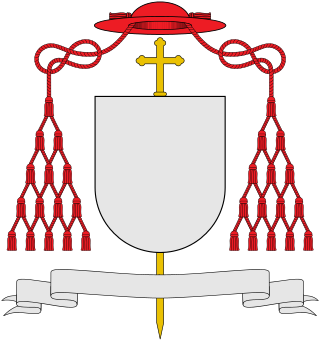
A cardinal is a senior member of the clergy of the Catholic Church. Cardinals are created by the ruling pope and typically hold the title for life. Collectively, they constitute the College of Cardinals.
Bishops of the Wrocław Bishopric, Prince-Bishopric (1290–1918), and Archdiocese.
James I, count of La Marche (b. 1319) deaths

James I of Bourbon, was a French prince du sang, and the son of Louis I, Duke of Bourbon and Mary of Avesnes. He was Count of Ponthieu from 1351 to 1360, and Count of La Marche from 1341 to his death.
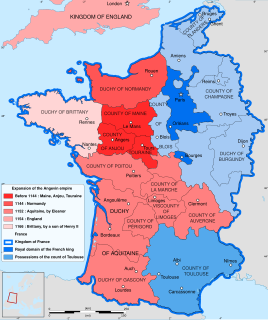
The County of La Marche was a medieval French county, approximately corresponding to the modern département of Creuse.
Infanta Maria, Marchioness of Tortosa births
Maria of Portugal was a Portuguese infanta (princess) member of the House of Burgundy and by marriage Marchioness of Tortosa and Lady of Albarracín.
Basil, emperor of Trebizond (Turkey) deaths
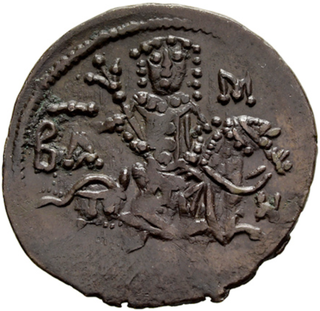
Basil Megas Komnenos was Emperor of Trebizond from August 1332 until his death in 1340. Although Basil's reign was a period of stability during the civil war that dominated the pocket empire during the second quarter of the 14th century, some of that conflict had its origins in his marital actions.

The Empire of Trebizond, or Trapezuntine Empire, was a monarchy and one of three successor rump states of the Byzantine Empire, along with the Despotate of the Morea and the Principality of Theodoro, that flourished during the 13th through to the 15th century, consisting of the far northeastern corner of Anatolia and the southern Crimea. The empire was formed in 1204 with the help of the Georgian queen Tamar after the Georgian expedition in Chaldia and Paphlagonia, commanded by Alexios Komnenos a few weeks before the sack of Constantinople. Alexios later declared himself Emperor and established himself in Trebizond. Alexios and David Komnenos, grandsons and last male descendants of deposed Emperor Andronikos I Komnenos, pressed their claims as "Roman emperors" against Byzantine Emperor Alexios V Doukas. The later Byzantine emperors, as well as Byzantine authors, such as George Pachymeres, Nicephorus Gregoras and to some extent Trapezuntines such as John Lazaropoulos and Basilios Bessarion, regarded the emperors of Trebizond as the "princes of the Lazes", while the possession of these "princes" was also called Lazica. Thus from the point of view of the Byzantine writers connected with the Laskaris and later with the Palaiologos dynasties, the rulers of Trebizond were not emperors.

Turkey, officially the Republic of Türkiye, is a transcontinental country located mainly on the Anatolian Peninsula in Western Asia, with a small portion on the Balkan Peninsula in Southeast Europe. It shares borders with the Black Sea to the north; Georgia to the northeast; Armenia, Azerbaijan, and Iran to the east; Iraq to the southeast; Syria and the Mediterranean Sea to the south; the Aegean Sea to the west; and Greece and Bulgaria to the northwest. Cyprus is located off the south coast. Turks form the vast majority of the nation's population and Kurds are the largest minority. Ankara is Turkey's capital, while Istanbul is its largest city and financial centre.
Peter of Verona, Italian priest and saint (b. 1206) deaths
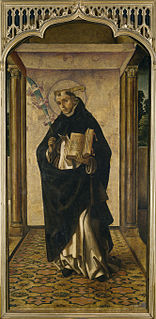
Peter of Verona, also known as Saint Peter Martyr and Saint Peter of Verona, was a 13th-century Italian Catholic priest. He was a Dominican friar and a celebrated preacher. He served as Inquisitor in Lombardy, was killed by an assassin, and was canonized as a Catholic saint 11 months after his death, making this the fastest canonization in history.
Guillaume de Sonnac, Grand Master of the Knights Templar deaths

Guillaume de Sonnac was Grand Master of the Knights Templar from 1247 to 1250.
William Marshal, 2nd Earl of Pembroke deaths

William Marshal, 2nd Earl of Pembroke was a medieval English nobleman and was one of Magna Carta sureties. He fought during the First Barons' War and was present at the Battle of Lincoln (1217) alongside his father William Marshal, 1st Earl of Pembroke, who led the English troops in that battle. He commissioned the first biography of a medieval knight to be written, called L'Histoire de Guillaume le Mareschal, in honour of his father.
Richard I, king of England (b. 1157) deaths

Richard I was King of England from 1189 until his death in 1199. He also ruled as Duke of Normandy, Aquitaine and Gascony, Lord of Cyprus, and Count of Poitiers, Anjou, Maine, and Nantes, and was overlord of Brittany at various times during the same period. He was the third of five sons of King Henry II of England and Eleanor of Aquitaine and seemed unlikely to become king, but all his brothers except the youngest, John, predeceased their father. Richard is known as Richard Cœur de Lion or Richard the Lionheart because of his reputation as a great military leader and warrior. The troubadour Bertran de Born also called him Richard Oc-e-Non, possibly from a reputation for terseness.
Frederick II, duke of Swabia (b. 1090) deaths
Frederick II, called the One-Eyed, was Duke of Swabia from 1105 until his death, the second from the Hohenstaufen dynasty. His younger brother Conrad was elected King of the Romans in 1138.

The Duchy of Swabia was one of the five stem duchies of the medieval German Kingdom. It arose in the 10th century in the southwestern area that had been settled by Alemanni tribes in Late Antiquity.
Maimonides, Jewish philosopher, Torah scholar, physician and astronomer (March 30 also proposed, d. 1204) births

Moses ben Maimon (1138–1204), commonly known as Maimonides and also referred to by the acronym Rambam, was a Sephardic Jewish philosopher who became one of the most prolific and influential Torah scholars of the Middle Ages. In his time, he was also a preeminent astronomer and physician, serving as the personal physician of Saladin. Born in Córdoba, Almoravid Empire, on Passover eve, 1138, he worked as a rabbi, physician and philosopher in Morocco and Egypt. He died in Egypt on 12 December 1204, whence his body was taken to the lower Galilee and buried in Tiberias.

The Torah is the compilation of the first five books of the Hebrew Bible, namely the books of Genesis, Exodus, Leviticus, Numbers and Deuteronomy. In that sense, Torah means the same as Pentateuch or the Five Books of Moses. It is also known in the Jewish tradition as the Written Torah. If meant for liturgic purposes, it takes the form of a Torah scroll. If in bound book form, it is called Chumash, and is usually printed with the rabbinic commentaries.
Liu Churang, Chinese general and chief of staff (b. 881) deaths
Liu Churang, courtesy name Deqian (德謙), was a general of the Chinese Five Dynasties and Ten Kingdoms Period states Later Tang and Later Jin, serving as a chief of staff (Shumishi) during the reign of Later Jin's founding emperor Shi Jingtang.
Nasr II, ruler (amir) of the Samanid Empire (b. 906) deaths

Nasr ibn Ahmad or Nasr II, nicknamed "the Fortunate", was the ruler (amir) of Transoxiana and Khurasan as the head of the Samanid dynasty from 914 to 943. His reign marked the high point of the Samanid dynasty's fortunes. He was the son of Ahmad ibn Isma’il.

Emir, sometimes transliterated amir, amier, or ameer, is a word of Arabic origin that can refer to a male monarch, aristocrat, holder of high-ranking military or political office, or other person possessing actual or ceremonial authority. The title has a long history of use in the Arab World, East Africa, West Africa, Central Asia, and the Indian subcontinent. In the modern era, when used as a formal monarchical title, it is roughly synonymous with "prince", applicable both to a son of a hereditary monarch, and to a reigning monarch of a sovereign principality, namely an emirate. The feminine form is emira, a cognate for "princess". Prior to its use as a monarchical title, the term "emir" was historically used to denote a "commander", "general", or "leader". In contemporary usage, "emir" is also sometimes used as either an honorary or formal title for the head of an Islamic, or Arab organisation or movement.

The Samanid Empire also known as the Samanian Empire, Samanid dynasty, Samanid amirate, or simply as the Samanids) was a Persianate Sunni Muslim empire, of Iranian dehqan origin. The empire was centred in Khorasan and Transoxiana; at its greatest extent encompassing modern-day Afghanistan, huge parts of Iran, Turkmenistan, Uzbekistan, Kyrgyzstan, Tajikistan, and parts of Kazakhstan and Pakistan, from 819 to 999.
Pei Che, chancellor of the Tang Dynasty deaths
Pei Che (裴澈), courtesy name Shenyuan (深源), was an official of the late Tang dynasty, serving as a chancellor during the reigns of Emperor Xizong and the pretender to the throne Li Yun. After Li Yun was defeated and executed, Pei was also executed for his service under Li Yun.
The chancellor was a semi-formally designated office position for a number of high-level officials at one time during the Tang dynasty of China. This list also includes chancellors of the short-lived Wu Zhou dynasty, which is typically treated as an interregnum of the Tang dynasty by historians.
Saint Methodius, Byzantine missionary and saint (b. 815) deaths

Cyril and Methodius (815–885) were two brothers and Byzantine Christian theologians and missionaries. For their work evangelizing the Slavs, they are known as the "Apostles to the Slavs".
Prudentius, bishop of Troyes deaths

Prudentius was bishop of Troyes, a chronicler and an opponent of Hincmar of Reims in the controversy on predestination.

The Diocese of Troyes is a Latin Church ecclesiastical territory or diocese of the Catholic Church in Troyes, France. The diocese now comprises the département of Aube. Erected in the 4th century, the diocese is currently a suffragan diocese in the ecclesiastical province of the metropolitan Archdiocese of Reims. It was re-established in 1802 as a suffragan of the Archbishopric of Paris, when it comprised the départements of Aube and Yonne and its bishop had the titles of Troyes, Auxerre, and Châlons-sur-Marne. In 1822 the See of Châlons was created and the Bishop of Troyes lost that title. When Sens was made an archdiocese, the episcopal title of Auxerre went to it and Troyes lost also the département of Yonne, which became the Archdiocese of Sens. The Diocese of Troyes covers, besides the ancient diocesan limits, 116 parishes of the ancient Diocese of Langres and 20 belonging to the ancient diocese of Sens. On 8 December 2002, the Diocese of Troyes was returned to its ancient metropolitan, the Archbishop of Reims. As of 2014, there was one priest for every 2,710 Catholics.
Chakri Day, commemorating the establishment of the Chakri dynasty. (Thailand)
Public holidays in Thailand are regulated by the government, and most are observed by both the public and private sectors. There are usually nineteen public holidays in a year, but more may be declared by the cabinet. Other observances, both official and non-official, local and international, are observed to varying degrees throughout the country.

The Chakri dynasty is the current reigning dynasty of the Kingdom of Thailand, the head of the house is the king, who is head of state. The family has ruled Thailand since the founding of the Rattanakosin Era and the city of Bangkok in 1782; following the end of Taksin Thonburi's reign, when the capital of Siam shifted to Bangkok. The royal house was founded by Rama I, an Ayutthaya military leader of Sino-Mon descent.
Christian feast day: Albrecht Dürer and Lucas Cranach (Lutheran Church).

Albrecht Dürer, sometimes spelled in English as Durer or Duerer, was a German painter, printmaker, and theorist of the German Renaissance. Born in Nuremberg, Dürer established his reputation and influence across Europe in his twenties due to his high-quality woodcut prints. He was in contact with the major Italian artists of his time, including Raphael, Giovanni Bellini, and Leonardo da Vinci, and from 1512 was patronized by Emperor Maximilian I.

Lucas Cranach the Elder was a German Renaissance painter and printmaker in woodcut and engraving. He was court painter to the Electors of Saxony for most of his career, and is known for his portraits, both of German princes and those of the leaders of the Protestant Reformation, whose cause he embraced with enthusiasm. He was a close friend of Martin Luther. Cranach also painted religious subjects, first in the Catholic tradition, and later trying to find new ways of conveying Lutheran religious concerns in art. He continued throughout his career to paint nude subjects drawn from mythology and religion.

The Lutheran liturgical calendar is a listing which details the primary annual festivals and events that are celebrated liturgically by various Lutheran churches. The calendars of the Evangelical Lutheran Church in America (ELCA) and the Evangelical Lutheran Church in Canada (ELCIC) are from the 1978 Lutheran Book of Worship and the calendar of the Lutheran Church–Missouri Synod (LCMS) and the Lutheran Church–Canada (LCC) use the Lutheran Book of Worship and the 1982 Lutheran Worship. Elements unique to the ELCA have been updated from the Lutheran Book of Worship to reflect changes resulting from the publication of Evangelical Lutheran Worship in 2006. The elements of the calendar unique to the LCMS have also been updated from Lutheran Worship and the Lutheran Book of Worship to reflect the 2006 publication of the Lutheran Service Book.
Christian feast day: Brychan

Brychan Brycheiniog was a legendary 5th-century king of Brycheiniog in Mid Wales.
Christian feast day: Eutychius of Constantinople (Eastern Orthodox Church)
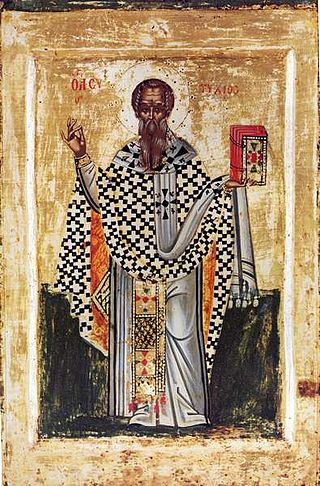
Eutychius, considered a saint in the Catholic and Eastern Orthodox Christian traditions, was the patriarch of Constantinople from 552 to 565, and from 577 to 582. His feast is kept by the Orthodox Church on 6 April, and he is mentioned in the Catholic Church's "Corpus Juris". His terms of office, occurring during the reign of Emperor Justinian the Great, were marked by controversies with both imperial and papal authority.

The Eastern Orthodox Church, also called the Orthodox Church, is the second-largest Christian church, with approximately 220 million baptized members. It operates as a communion of autocephalous churches, each governed by its bishops via local synods. The church has no central doctrinal or governmental authority analogous to the head of the Roman Catholic Church—the Pope—but the Ecumenical Patriarch of Constantinople is recognized by them as primus inter pares, which may be explained as a representative of the church. As one of the oldest surviving religious institutions in the world, the Eastern Orthodox Church has played a prominent role in the history and culture of Eastern and Southeastern Europe. The Eastern Orthodox Church officially calls itself the Orthodox Catholic Church.
Christian feast day: Marcellinus of Carthage
Marcellinus of Carthage was a Christian martyr and saint who died in 413. He was secretary of state of the Western Roman Empire under Roman emperor Honorius and a close friend of Augustine of Hippo, as well as a correspondent of Saint Jerome's. Saint Augustine dedicated the first books of his landmark The City of God to Marcellinus in 413.
Christian feast day: Pope Sixtus I

Pope Sixtus I, also spelled Xystus, a Roman of Greek descent, was the bishop of Rome from c. 115 to his death. He succeeded Alexander I and was in turn succeeded by Telesphorus. His feast is celebrated on 6 April.
Christian feast day: April 6 (Eastern Orthodox liturgics)

April 5 — Eastern Orthodox liturgical calendar — April 7
International Day of Sport for Development and Peace
The International Day of Sport for Development and Peace (IDSDP) is an annual celebration of the power of sport to drive social change, community development and to foster peace and understanding.
National Fisherman Day (Indonesia)

The following table indicates declared Indonesian government national holidays. Cultural variants also provide opportunity for holidays tied to local events. Beside official holidays, there are the so-called "libur bersama" or "cuti bersama", or joint leave(s) declared nationwide by the government. In total there are 16 public holidays every year.
New Beer's Eve (United States)
National Beer Day is celebrated in the United States every year on April 7, marking the day that the Cullen–Harrison Act came into force after having been signed into law by President Franklin D. Roosevelt on March 22, 1933. This led to the Eighteenth Amendment being repealed on December 5, 1933, with the ratification of the Twenty-first Amendment to the U.S. Constitution. April 6, the day prior to National Beer Day, is known as New Beer's Eve.
Tartan Day (United States & Canada)

Tartan Day is a North American celebration of Scottish heritage on 6 April, the date on which the Declaration of Arbroath was signed in 1320. It originated in Canada in the mid-1980s. It spread to other communities of the Scottish diaspora in the 1990s. In Australia, a similar International Tartan Day is held on 1 July, the anniversary of the repeal of the 1747 Act of Proscription that banned the wearing of tartan.
Waltzing Matilda Day (Australia)

"Waltzing Matilda" is a song developed in the Australian style of poetry and folk music called a bush ballad. It has been described as the country's "unofficial national anthem".
International Asexuality Day

Asexuality is the lack of sexual attraction to others, or low or absent interest in or desire for sexual activity. It may be considered a sexual orientation or the lack thereof. It may also be categorized more widely, to include a broad spectrum of asexual sub-identities.